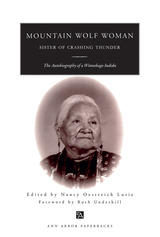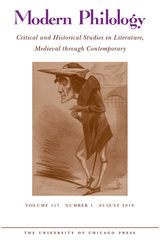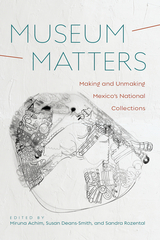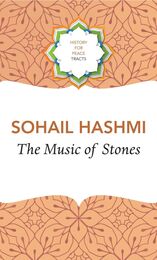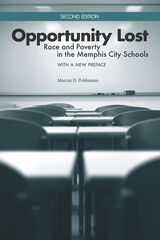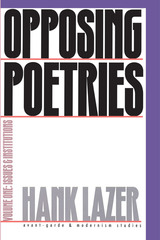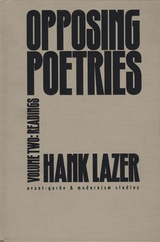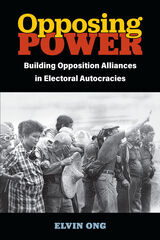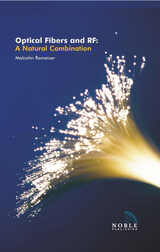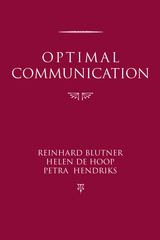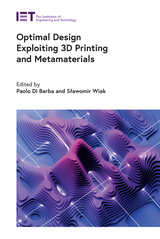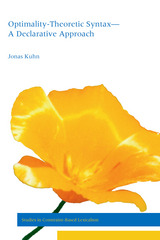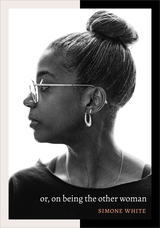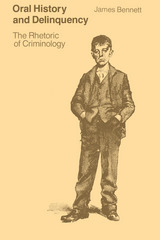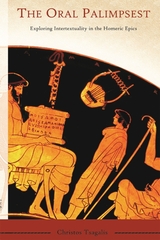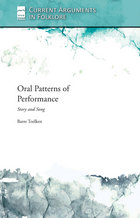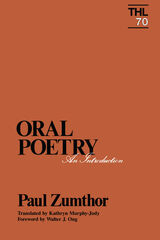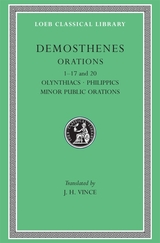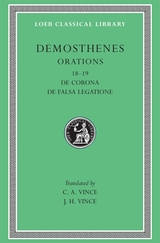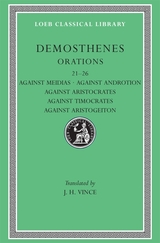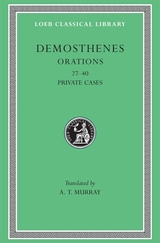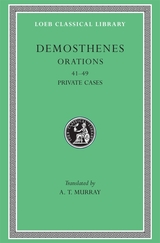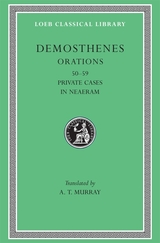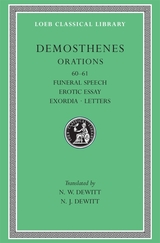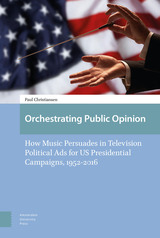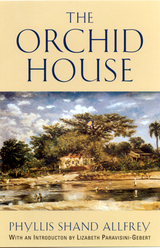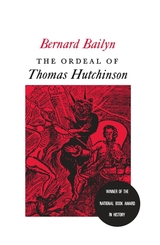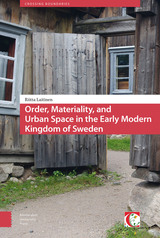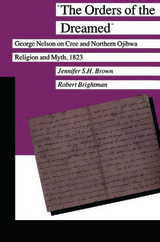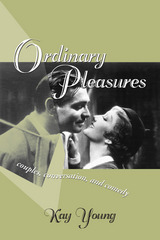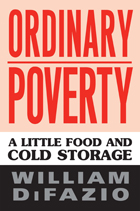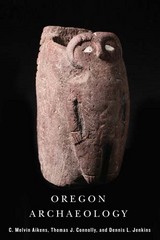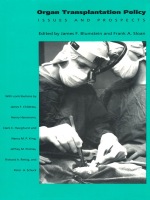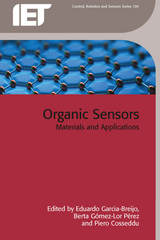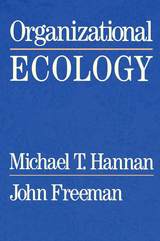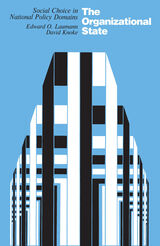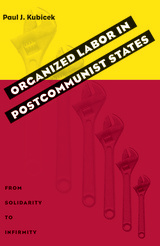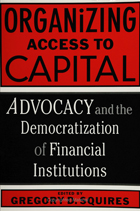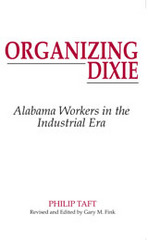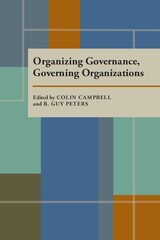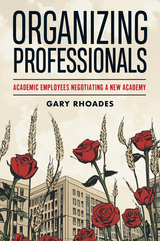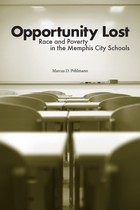 Opportunity Lost: Race and Poverty in the Memphis City Schools
Marcus D. Pohlmann
University of Tennessee Press, 2008
In Opportunity Lost, Marcus D. Pohlmann examines the troubling issue of why Memphis city school students are underperforming at alarming rates. His provocative interdisciplinary analysis, combining both history and social science, examines the events before and after desegregation, compares a city school to an affluent suburban school to pinpoint imbalances, and offers critical assessments of various educational reforms.
Employing a rich trove of data to demonstrate the realities of racial and economic inequality, Pohlmann underscores the difficulties that plague the urban schools and their students-problems that persist despite the fact that the city schools often have more resource advantages than the county schools: better student-to-teacher ratios, more teachers with advanced degrees, and even greater spending on each student. Pohlmann demonstrates that post-industrial economic shifts and continuing racial exclusion have resulted in a predominance of low-income students at these schools. This economic disadvantage has had a lasting impact on performance among students at all grade levels and has not been reversed simply by increasing resources.
In addition to his analysis of the problems, Pohlmann lays out educational reforms that run the gamut from early intervention and parental involvement to increasing class size and teacher compensation, improving time utilization, and more. Pohlmann's illuminating and original study has wide application for a problem that bedevils inner-city children everywhere and prevents the promise of equality from reaching all of our nation's citizens.
Marcus D. Pohlmann is professor of political science at Rhodes College. He is the author of Governing the Postindustrial City; coauthor, with Michael P. Kirby, of Racial Politics at the Crossroads: Memphis Elects W. W. Herenton; and editor of the six-volume African American Political Thought.
Opportunity Lost: Race and Poverty in the Memphis City Schools
Marcus D. Pohlmann
University of Tennessee Press, 2009
In Opportunity Lost, Marcus D. Pohlmann examines the troubling issue of why Memphis city school students are underperforming at alarming rates. His provocative interdisciplinary analysis, combining both history and social science, examines the events before and after desegregation, compares a city school to an affluent suburban school to pinpoint imbalances, and offers critical assessments of various educational reforms.
In addition to his analysis of the problems, Pohlmann lays out educational reforms that run the gamut from early intervention and parental involvement to increasing teacher compensation, improving time utilization, and more. Pohlmann’s illuminating and original study has wide application for a problem that bedevils inner-city children everywhere and prevents the promise of equality from reaching all of our nation’s citizens.
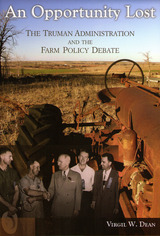 An Opportunity Lost: The Truman Administration and the Farm Policy Debate
Virgil W. Dean
University of Missouri Press, 2006
Harry Truman’s “Fair Deal” domestic policy agenda promised to continue Roosevelt’s New Deal and, with some modification for postwar realities, to guide America into a new age of peace and prosperity. Agricultural policy was a cornerstone of this program, as it attempted to transform the farm program from the parity price foundation crafted by FDR to one based on income support through direct payment to farmers.
Virgil W. Dean takes a new look at the much-heralded “Brannan Plan” to examine in detail the farm policy dilemma and Truman’s quest for a long-range agricultural program that would confront the problems of an industry in the midst of a technological revolution—one in which regional and commodity-based differences only served to complicate any solution. He assesses Truman’s relationships with the farming community and with politicians of both parties and analyzes the complex problems facing those concerned about the welfare of the American farm, focusing on their search for a workable peacetime program—especially as it related to price supports—and their failure to come to terms with the issues.
Dean describes how supporters of the Brannan Plan recognized its promise of social and economic equity while opponents feared excessive government spending, creeping socialism, and the regimentation of agriculture. He also tells how agriculture secretary Charles Brannan interjected partisan politics to an unprecedented degree in policy making—and how Truman used agricultural policy against the Republicans in the 1948 election by creating an issue with little basis in fact.
As Dean shows, the failure of Truman’s efforts meant that the nation lost an opportunity to effect a much-needed change in agricultural policy, yet the issues raised remained at the heart of the farm policy debate for decades to come—with “direct income” morphing into “deficiency payments” to satisfy farmers not wanting to appear to be on welfare. An Opportunity Lost makes a major contribution to our understanding of the Truman administration’s political activities at a time when the agricultural community had a strong voice in the formulation of domestic policy, and it casts new light on the overall fate of the Fair Deal.
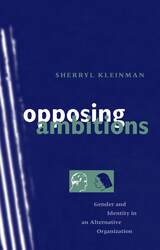 Opposing Ambitions: Gender and Identity in an Alternative Organization
Sherryl Kleinman
University of Chicago Press, 1996 "Renewal" is a holistic health center run by baby boomers whose political ideals were shaped by the counterculture movements of the 1960s. Through interviews and observation, Sherryl Kleinman takes us inside Renewal and shows us how its members struggled to maintain a view of themselves as progressive and alternative even as they sought conventional legitimacy.
In Opposing Ambitions we meet the members of Renewal as individuals; learn about the differences in power, prestige, and respect they are accorded; why they talked endlessly about money; and how they related to each other. Kleinman shows how members' attempts to see themselves as unconventional, but also as serious operators of a legitimate health care organization, led them to act in ways that undermined their egalitarian goals. She draws out the lessons Renewal offers for understanding the problems women face in organizations, the failure of social movements to live up to their ideals, and how it is possible for progressives to avoid reproducing the inequalities they claim to oppose.
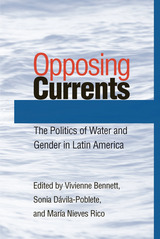 Opposing Currents: The Politics of Water and Gender in Latin America
Vivienne Bennett
University of Pittsburgh Press, 2004
This volume focuses on women in Latin America as stakeholders in water resources management. It makes their contributions to grassroots efforts more visible, explains why doing so is essential for effective public policy and planning in the water sector, and provides guidelines for future planning and project implementation.
After an in-depth review of gender and water management policies and issues in relation to domestic usage, irrigation, and sustainable development, the book provides a series of case studies prepared by an interdisciplinary group of scholars and activists. Covering countries throughout the hemisphere, and moving freely from impoverished neighborhoods to the conference rooms of international agencies, the book explores the various ways in which women are-and are not-involved in local water initiatives across Latin America. Insightful analyses reveal what these case studies imply for the success or failure of various regional efforts to improve water accessibility and usability, and suggest new ways of thinking about gender and the environment in the context of specific policies and practices.
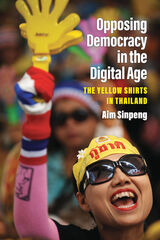 Opposing Democracy in the Digital Age: The Yellow Shirts in Thailand
Aim Sinpeng
University of Michigan Press, 2021 Opposing Democracy in the Digital Age is about why ordinary people in a democratizing state oppose democracy and how they leverage both traditional and social media to do so. Aim Sinpeng focuses on the people behind popular, large-scale antidemocratic movements that helped bring down democracy in 2006 and 2014 in Thailand. The yellow shirts (PAD—People’s Alliance for Democracy) that are the focus of the book are antidemocratic movements grown out of democratic periods in Thailand, but became the catalyst for the country’s democratic breakdown. Why, when, and how supporters of these movements mobilize offline and online to bring down democracy are some of the key questions that Sinpeng answers. While the book primarily uses a qualitative methodological approach, it also uses several quantitative tools to analyze social media data in the later chapters. This is one of few studies in the field of regime transition that focuses on antidemocratic mobilization and takes the role of social media seriously.
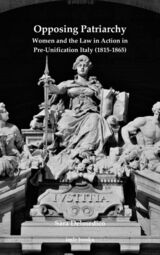 Opposing Patriarchy: Women and the Law in Action in Pre-Unification Italy (1815–1865)
Sara Delmedico
University of London Press, 2021 Opposing Patriarchy explores women’s increasing political activism in nineteenth-century Italy.
In Italy and beyond, the nineteenth century was a time of great political change. Shifts in state boundaries and socio-economic structures deeply affected the Italian political landscape, including the nation’s legal system. Many Italian women, who had lived within a strict patriarchal and hierarchical society, began to redefine their identities beyond the traditional domestic roles of daughter, wife, and mother. This volume charts that process by focusing on women’s attitudes towards the law and their interaction with the legal system. Sara Delmedico seeks to recover the forgotten voices and lives of those ordinary women who, in their everyday lives, reacted against the limitations and constraints imposed upon them by society and who refused to accept their status passively. As this volume shows, the women of the period understood the law, questioned obedience, challenged authority, and stood up for themselves. Even though they did not always achieve their goals, their actions contributed to shaping our present.
Opposing Poetries: Part One: Issues and Institutions
Hank Lazer
Northwestern University Press, 1996 Opposing Poetries presents a selection of Hank Lazer's writing on a range of issues in contemporary American poetry. Through a series of recurring cultural, material, and institutional perspectives, Lazer investigates the assumptions and habits that govern conflicting conceptions of contemporary American poetry, while refining, reconsidering, and questioning his own and modern theorists' assertions and claims relating to experimental poetry.
Volume One examines the shift in the governing assumptions of contemporary poetic practice. Lazer inspects the key critical works addressing poetries in the 1980s and 1990s, as well as the political and aesthetic impact of modern critics, poetry reading programs, and of the publishing industry and libraries on contemporary poetic practice.
Opposing Poetries: Part Two: Readings
Hank Lazer
Northwestern University Press, 1996 Opposing Poetries presents a selection of Hank Lazer's writing on a range of issues in contemporary American poetry. Through a series of recurring cultural, material, and institutional perspectives, Lazer investigates the assumptions and habits that govern conflicting conceptions of contemporary American poetry, while refining, reconsidering, and questioning his own and modern theorists' assertions and claims relating to experimental poetry.
In Volume Two, Lazer presents a series of sustained readings of important experimental texts. Included are the poets Susan Howe, Lyn Hejinian, Bruce Andrews, and James Sherry. Lazer places these poets in the context of contemporary literary theory, and inspects both the successes and failures of said theory to interpret these works.
Opposing Power: Building Opposition Alliances in Electoral Autocracies
Elvin Ong
University of Michigan Press, 2022 Opposing Power argues that perceptions of regime vulnerability and mutual dependency by opposition elites shape the building of opposition alliances. When electoral autocracies are consistently dominant, opposition parties eschew fully fledged alliances. At best, they allocate only one candidate to contest against the incumbent in each subnational electoral district to avoid splitting the opposition vote. However, when multiple regime-debilitating events strike within a short period of time, thus pushing an incumbent to the precipice of power, opposition elites expect victory, accepting costly compromises to build alliances and seize power. Opposing Power shows how oppositions build these alliances through case study comparisons in East and Southeast Asia—between the Philippines and South Korea in the late 1980s, and between Malaysia and Singapore from 1965 to 2020.
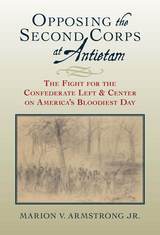 Opposing the Second Corps at Antietam: The Fight for the Confederate Left and Center on America's Bloodiest Day
Marion V. Armstrong, Jr.
University of Alabama Press, 2016 With a tally of more than five thousand killed, twenty thousand wounded, and three thousand missing, the Battle of Antietam made September 17, 1862, the deadliest day of combat in American history. In Opposing the Second Corps at Antietam, Antietam scholar Marion V. Armstrong Jr. completes his magisterial study of Antietam begun in Unfurl Those Colors! by examining Robert E. Lee’s leadership at the climactic battle in the Confederate invasion of Union territory.
Eminent Civil War historians consider Antietam the turning point of the war. Hoping to maintain the initiative they had gained at the Second Battle of Bull Run, Confederate leaders looked to a stunning victory on Northern soil to sour Northern sentiment on the war as well as to coax European powers to recognize the fledgling Confederacy. Having examined McClellan’s command and role at Antietam in Unfurl Those Colors!, Armstrong now recounts in riveting detail Lee’s command decisions and their execution in the field, drawing on a superlative collection of first-person accounts by Confederate veterans to narrate the cataclysmic struggle between Lee and McClellan.
Armstrong sets the stage with a lively recap of the political and military events leading up to the early fall of 1862 and foreshadowing the conflagration to come on September 17. Each chapter then traces a critical section of the battle, the fight for the West Woods and the bloody engagement of the Sunken Road. Armstrong augments this collection with an exceptional set of maps, which will be valued by scholars, readers, and visitors to the battlefield. These unique maps delineate troop movements in intervals as brief as fifteen minutes, bringing to life the fluid, mutable lines that characterize the glory and horror of Antietam.
Either together with Unfurl Those Colors! or as a stand-alone account of the Confederate side of the battle, Opposing the Second Corps at Antietam provides the fullest possible understanding of the experience of Confederate soldiers at Antietam.
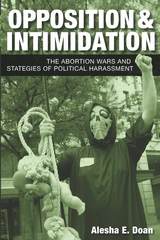 Opposition and Intimidation: The Abortion Wars and Strategies of Political Harassment
Alesha E. Doan
University of Michigan Press, 2007 The abortion fight has long been a crucible of political tactics, with both sides employing strategies ranging from litigation to civil disobedience to outright violence. Anti-abortion activists have arguably been more tactically innovative than their pro-choice peers. Opposition and Intimidation looks at how their use of political harassment fits—or doesn't—with more conventional political efforts in the struggle over abortion. Alesha Doan's insightful interviews and observations powerfully portray anti-abortion activists' relationship to the objects of their protest. Her portrait is augmented by thorough quantitative analysis of harassment's role within the movement's multitiered strategy—a strategy that Doan shows has forced a decline in the availability and popularity of abortions. Using her unique study of the anti-abortion movement as a model, Doan extends her findings to propose a novel and valuable theory of the new politics of harassment. "An interesting and sophisticated account. Seamlessly weaves narrative and analysis, tying local action to national strategy. Explores uncharted territory in the abortion controversy and expands our understanding of political action." —Deborah R. McFarlane, University of New Mexico "For 40 years, abortion politics have been endlessly fascinating to American scholars and journalists alike because they generate unique political phenomena that challenge traditional theories of political behavior. In this book, Doan goes straight to the heart of the matter by describing, evaluating, and explaining one of the most characteristic and complex of these phenomena—political harassment. In a well-written narrative that weaves qualitative and quantitative data, she gives us the first scholarly look at this political tactic, whose relevance and use go well beyond American abortion politics."
—Chris Mooney, University of Illinois at Springfield "The book contributes to political theory and knowledge by adding new empirical data gathered from interviews with those in the front lines of the struggle over abortion. The author refines and develops a category of unconventional political participation—political harassment of nongovernmental actors—and explains why it is particularly effective in undermining the rights of women seeking abortions, as well as the rights of abortion service providers." —Nikki R. Van Hightower, Texas A&M University Alesha E. Doan is Assistant Professor of Political Science at the University of Kansas.
 Opposition by Imitation: The Economics of Italian Anti-Mafia Activism
Christina Jerne
University of Minnesota Press, 2025 Defying the mafia with everyday acts of resistance
For more than 150 years, Italy has been home to a resilient and evolving resistance against the pervasive influence of mafias. While these criminal organizations are renowned for their vast international business enterprises, the collective actions taken to oppose them are less known. In Opposition by Imitation, Christina Jerne explores anti-mafia activism, revealing how ordinary people resist, counter, and prevent criminal economies from proliferating. Drawing on ethnographic fieldwork among anti-mafia alliances in Campania, Sicily, and other parts of Italy, Jerne details a particular aspect of mafia activities: providing cash relief and other forms of patronage to individuals and groups. Her research shows how activism has evolved to imitate this sustaining role. Activists are increasingly challenging mafia control both by creating alternative economies—from producing food that interrupts mafia labor practices to organizing tourism that supports anti-mafia hospitality—and by subversively adopting business tactics similar to the mafia’s to compete with their social influence and legitimacy. Exposing the political implications of this mimetic opposition, Jerne points to its potential impact on crime prevention and criminalization, both in Italy and globally. Opposition by Imitation shows how these modern-day Robin Hoods are redefining collective action, taking what was controlled by the mafias and returning it to the collective. This contentious economic turn, against the backdrop of broader social movements, reveals significant political possibilities afforded by imitative opposition. Retail e-book files for this title are screen-reader friendly with images accompanied by short alt text and/or extended descriptions.
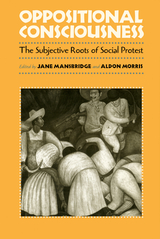 Oppositional Consciousness: The Subjective Roots of Social Protest
Edited by Jane J. Mansbridge and Aldon Morris
University of Chicago Press, 2001 How can human beings be induced to sacrifice their lives—even one minute of their lives-for the sake of their group? This question, central to understanding the dynamics of social movements, is at the heart of this collection of original essays. The book is the first to conceptualize and illustrate the complex patterns of negotiation, struggle, borrowing, and crafting that characterize what the editors term "oppositional consciousness"—an empowering mental state that prepares members of an oppressed group to undermine, reform, or overthrow a dominant system.
Each essay employs a recent historical case to demonstrate how oppositional consciousness actually worked in the experience of a subordinate group. Based on participant observation and interviews, chapters focus on the successful social movements of groups such as African Americans, people with disabilities, sexually harassed women, Chicano workers, and AIDS activists. Ultimately, Oppositional Consciousness sheds new light on the intricate mechanisms that drive the important social movements of our time.
Contributors: Naomi Braine, Sharon Groch, Fredrick C. Harris, Jane Mansbridge, Anna-Maria Marshall, Aldon Morris, Marc Simon Rodriguez, Brett C. Stockdill, Lori G. Waite
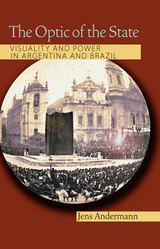 The Optic of the State: Visuality and Power in Argentina and Brazil
Jens Andermann
University of Pittsburgh Press, 2007 The Optic of the State traces the production of nationalist imaginaries through the public visual representation of modern state formation in Brazil and Argentina. As Jens Andermann reveals, the foundational visions of national heritage, territory, and social and ethnic composition were conceived and implemented, but also disputed and contested, in a complex interplay between government, cultural, and scientific institutions and actors, as a means of propagating political agendas and power throughout the emerging states.
The purpose of these imaginaries was to vindicate the political upheavals of the recent past and secure the viability of the newly independent states through a sense of historic destiny and inevitable evolution. The careful presentation of artifacts and spectacles was also aimed abroad in order to win the favor of European imperial powers and thereby acquire a competitive place in the nascent global economy of the late nineteenth century.
The Optic of the State offers a fascinating critique of the visual aspects of national mythology. It exposes how scientific and cultural institutions inscribed the state-form in time and space, thus presenting historical processes as natural “givens.”
Optical Fibers and RF: A natural combination
Malcolm Romeiser
The Institution of Engineering and Technology, 2004 The optical fiber industry has experienced a period of consolidation and reorganization and is now poised for a new surge in growth. To take advantage of that growth, and to respond to the demand to use fiber more efficiently, designers need a better understanding of fiber optics. Taking the approach that optical fibers are an extension of RF-based communications, the author explains basic optical concepts, applications, and systems; the nature and performance characteristics of optical fibers; and optical sources, connectors and splices. Subsequent chapters explore current applications of fiber optic technology. Appropriate for use as a college text, this is an accessible and thorough treatment of fiber optics, without an intimidating amount of mathematical derivations.
Optical MEMS for Chemical Analysis and Biomedicine
Hongrui Jiang
The Institution of Engineering and Technology, 2016 Optical MEMS are micro-electromechanical systems merged with micro-optics. They allow sensing or manipulating optical signals on a very small size scale using integrated mechanical, optical, and electrical systems and hold great promise specifically in biomedical applications, among others.
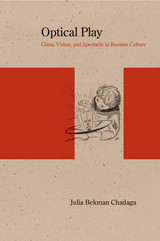 Optical Play: Glass, Vision, and Spectacle in Russian Culture
Julia Bekman Chadaga
Northwestern University Press, 2014 Longlist finalist, 2015 Historia Nova Prize for Best Book on Russian Intellectual and Cultural History
Julia Bekman Chadaga’s ambitious study posits that glass—in its uses as a material and as captured in culture—is a key to understanding the evolution of Russian identity from the eighteenth century onward. From the contemporary perspective, it is easy to overlook how glass has profoundly transformed vision. Chadaga shows the far-reaching effects of this phenomenon.
Her book examines the similarities between glass and language, the ideological uses of glass, and the material’s associations with modernity, while illuminating the work of Lomonosov, Dostoevsky, Zamyatin, and Eisenstein, among others. In particular, Chadaga explores the prominent role of glass in the discourse around Russia’s contentious relationship with the West—by turns admiring and antagonistic—as the nation crafted a vision for its own future. Chadaga returns throughout to the spectacular aspect of glass and shows how both the tendentious capacity and the playfulness of this material have shaped Russian culture.
 The Optics of Ibn al-Haytham Books IV–V: On Reflection and Images Seen by Reflection
Abdelhamid I. Sabra
University of London Press, 2023 Books four and five of a landmark seven-volume work of medieval scientific study of optics.
Ibn al-Haytham was perhaps the greatest mathematician and physicist of the medieval Arabic/Islamic world. The most famous book in which he applied his scientific method is his Optics, through which he dealt with both the mathematics of rays of light and the physical aspects of the eye in seven comprehensive books. His rethinking of the entire science of optics set the scene for the whole of the subsequent development of the subject, influencing figures such as William of Ockham, Kepler, Descartes, and Christaan Huygens. The immense work of editing, translating into English, and commenting on this work was undertaken by Abdelhamid I. Sabra. This English translation of Books IV–V was completed by Sabra just before his death in 2013 with an introduction and critical analysis. It has been extensively revised by Jan Hogendijk.
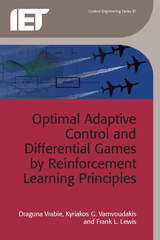 Optimal Adaptive Control and Differential Games by Reinforcement Learning Principles
Draguna Vrabie
The Institution of Engineering and Technology, 2012 This book gives an exposition of recently developed approximate dynamic programming (ADP) techniques for decision and control in human engineered systems. ADP is a reinforcement machine learning technique that is motivated by learning mechanisms in biological and animal systems. It is connected from a theoretical point of view with both adaptive control and optimal control methods. The book shows how ADP can be used to design a family of adaptive optimal control algorithms that converge in real-time to optimal control solutions by measuring data along the system trajectories. Generally, in the current literature adaptive controllers and optimal controllers are two distinct methods for the design of automatic control systems. Traditional adaptive controllers learn online in real time how to control systems, but do not yield optimal performance. On the other hand, traditional optimal controllers must be designed offline using full knowledge of the systems dynamics. It is also shown how to use ADP methods to solve multi-player differential games online. Differential games have been shown to be important in H-infinity robust control for disturbance rejection, and in coordinating activities among multiple agents in networked teams. The focus of this book is on continuous-time systems, whose dynamical models can be derived directly from physical principles based on Hamiltonian or Lagrangian dynamics.
Optimal Communication
Edited by Reinhard Blutner, Helen de Hoop and Petra Hendriks
CSLI, 2005 This volume explores how the effectiveness of communication is shaped by aspects of semantics and pragmatics such as compositionality, the role of the speaker and hearer, and the acquisition of meaning. Optimal Communication surveys recent research in the fields of syntax, semantics, and pragmatics, and draws from optimality theory to argue that optimal meanings result from a compromise between competing constraints. Optimal Communication will be an invaluable resource for students in cognitive science, linguistics, and natural language semantics.
Optimal Design Exploiting 3D Printing and Metamaterials
Paolo Di Barba
The Institution of Engineering and Technology, 2022 The key theme of this book is an exploration of how recent advances across three related scientific fields are intertwined - the developments in metamaterials, the automated optimal design of innovative electronic, electromagnetic and mechatronic devices, and 3D printing.
Optimality-Theoretic Syntax: A Declarative Approach
Jonas Kuhn
CSLI, 2003 With this book, Jonas Kuhn greatly advances Optimality Theory (OT) by clarifying the significant choices in the design of a formally precise OT approach to syntax. Building on OT work that uses the representation structures of Lexical Functional Grammar (OT-LFG), Kuhn defines the notion of an OT-syntactic grammar in a declarative, non-derivational way.
Along with the standard OT architecture, which is based on a generation metaphor, Kuhn also formalizes parsing-based OT, and goes on to discuss possible combinations of these two architectures. This is followed by an examination of assumptions under which the computational tasks of generation and parsing are decidable for an OT-syntactic grammar.
Optimised Radar Processors
A. Farina
The Institution of Engineering and Technology, 1987 This book is devoted to the description of optimum signal processing algorithms which can find useful applications in radar systems. The monograph collects about twenty papers written by the Editor and his colleagues. Structurally the collection of the papers is divided into four parts. The first describes the adaptive cancellation techniques of radar clutter; the second part addresses the challenging problem of finding the optimum detection schemes to deal with target and clutter signals having non-Gaussian probability density function, and any type of autocorrelation function. The third group of papers considers the problem of finding the optimum detection schemes for the case of netted multi-static radar systems. The last part is concerned with more general processing techniques used in radar systems for surveillance.
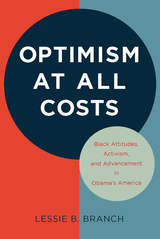 Optimism at All Costs: Black Attitudes, Activism, and Advancement in Obama's America
Lessie B. Branch
University of Massachusetts Press, 2018 In the wake of Barack Obama's 2008 presidential victory, most Americans believed that race relations would improve. While many leaders rallied behind the first black president and the black community felt optimistic on the whole, statistics reveal a decline in black Americans' economic fortunes and a slower recovery from the recession in the years that followed.
Lessie B. Branch confronts the tension between black Americans' economic realities and the hope many felt for the future, looking at survey data alongside the rhetoric of leading black figures, including President Obama. This disparity has caused a dangerous resistance to social activism, as discourses of optimism privilege individual success over the need for collective action. Branch sees the emergence of the Black Lives Matter movement as a constructive change in this dynamic. As Americans continue to grapple with complicated questions of race and progress in classrooms, in the media, and in legislatures, this short, provocative book will inform and enrich these important discussions.
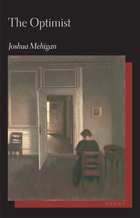 The Optimist: Poems
Joshua Mehigan
Ohio University Press, 2005 In Joshua Mehigan’s award-winning poetry, one encounters a lucid, resolute vision driven by an amazing facility with the metrical line. Most of the poems in The Optimist unapologetically employ traditional poetic technique, and, in each of these, Mehigan stretches the fabric of living language over a framework of regular meter to produce a compelling sonic counterpoint. The Optimist stares at contemporary darkness visible, a darkly lit tableau that erases the boundary between the world and the perceiving self. Whether narrative or lyric, dramatic or satirical, Mehigan’s poems explore death, desire, and change with a mixture of reason and compassion. In choosing The Optimist for the Hollis Summers Poetry Prize, final judge James Cummins, wrote: “The world is given its due in these poems, but its due is the subjective voice making ‘objective’ reality into the reality of art. To do this Mehigan accesses a tradition of voices—the echoes in The Optimist are, to name a few, of Frost, Robinson, Kees, and Justice; and more in terms of point of view, Bishop and Jarrell—to form with great integrity his own. It isn’t that Mehigan is concerned more with what’s outside himself than inside; nor merely that he travels the highway between the two with such humility and grace. It’s also that these voices, this great tradition, infuses his line with what the best verse, metrical or free, must have: wonder.”
 Optimizing Cyberdeterrence: A Comprehensive Strategy for Preventing Foreign Cyberattacks
Robert Mandel
Georgetown University Press, 2017 Cyberattacks are one of the greatest fears for governments and the private sector. The attacks come without warning and can be extremely costly and embarrassing. Robert Mandel offers a unique and comprehensive strategic vision for how governments, in partnership with the private sector, can deter cyberattacks from both nonstate and state actors. Cyberdeterrence must be different from conventional military or nuclear deterrence, which are mainly based on dissuading an attack by forcing the aggressor to face unacceptable costs. In the cyber realm, where attributing a specific attack to a specific actor is extremely difficult, conventional deterrence principles are not enough. Mandel argues that cyberdeterrence must alter a potential attacker’s decision calculus by not only raising costs for the attacker but also by limiting the prospects for gain. Cyberdeterrence must also involve indirect unorthodox restraints, such as exposure to negative blowback and deceptive diversionary measures, and cross-domain measures rather than just retaliation in kind. The book includes twelve twenty-first-century cyberattack case studies to draw insights into cyberdeterrence and determine the conditions under which it works most effectively. Mandel concludes by making recommendations for implementing cyberdeterrence and integrating it into broader national security policy. Cyber policy practitioners and scholars will gain valuable and current knowledge from this excellent study.
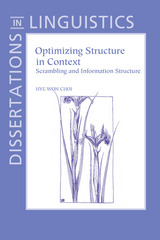 Optimizing Structure in Context: Scrambling and Information Structure
Hye-Won Choi
CSLI, 1999 This book examines the scrambling phenomena in German and Korean from the perspective that different ordering possibilities are motivated and constrained by interactions among syntactic, semantic, and discourse principles. Using Optimality Theory, Optimizing Structure in Context demonstrates how these principles from different modules of grammar interact and thus resolve conflicts among themselves to yield the most optimal output, that is, a sentence with a particular word order, in a given semantic and discoursal context. This way, it explains various meaning-related effects associated with scrambling such as definiteness effect and focus effect. While developing constraints in the discourse domain, it also proposes a new model of information structure based on basic discourse features. By expanding the core idea of constraint interaction in Optimality Theory to interactions 'between' modules of grammar as well as 'between', this book provides a model of interface theory.
 Opting for Elsewhere: Lifestyle Migration in the American Middle Class
Brian A. Hoey
Vanderbilt University Press, 2014 "Do you get told what the good life is, or do you figure it out for yourself?" This is the central question of Opting for Elsewhere, as the reader encounters stories of people who chose relocation as a way of redefining themselves and reordering work, family, and personal priorities. This is a book about the impulse to start over. Whether downshifting from stressful careers or being downsized from jobs lost in a surge of economic restructuring, lifestyle migrants seek refuge in places that seem to resonate with an idealized, potential self. Choosing the "option of elsewhere" and moving as a means of remaking self through sheer force of will are basic facets of American character, forged in its history as a developing nation of immigrants with a seemingly ever-expanding frontier. Building off years of interviews and research in the Midwest, including areas of Michigan, Brian Hoey provides an evocative illustration of the ways these sweeping changes impact people and the communities where they live and work as well as how both react--devising strategies for either coping with or challenging the status quo. This portrait of starting over in the heartland of America compels the reader to ask where we are going next as an emerging postindustrial society.
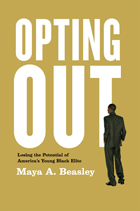 Opting Out: Losing the Potential of America's Young Black Elite
Maya A. Beasley
University of Chicago Press, 2011 Why has the large income gap between blacks and whites persisted for decades after the passage of civil rights legislation? More specifically, why do African Americans remain substantially underrepresented in the highest-paying professions, such as science, engineering, information technology, and finance? A sophisticated study of racial disparity, Opting Out examines why some talented black undergraduates pursue lower-paying, lower-status careers despite being amply qualified for more prosperous ones. To explore these issues, Maya A. Beasley conducted in-depth interviews with black and white juniors at two of the nation’s most elite universities, one public and one private. Beasley identifies a set of complex factors behind these students’ career aspirations, including the anticipation of discrimination in particular fields; the racial composition of classes, student groups, and teaching staff; student values; and the availability of opportunities to network. Ironically, Beasley also discovers, campus policies designed to enhance the academic and career potential of black students often reduce the diversity of their choices. Shedding new light on the root causes of racial inequality, Opting Out will be essential reading for parents, educators, students, scholars, and policymakers.
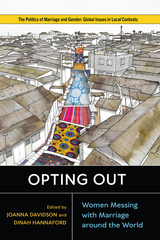 Opting Out: Women Messing with Marriage around the World
Joanna Davidson
Rutgers University Press, 2023 Women around the world are opting out of marriage. Through nuanced ethnographic accounts of the ways that women are moving the needle on marital norms and practices, Opting Out reveals the conditions that make this widespread phenomenon possible in places where marriage has long been obligatory. Each chapter invites readers into the lives of particular women and the changing circumstances in which these lives unfold - sometimes painfully, sometimes humorously, and always unexpectedly. Taken together, the essays in this volume prompt the following questions: Why is marriage so consistently disappointing for women? When the rewards of economic stability and the social status that marriage confers are troubled, does marriage offer women anything compelling at all? Across diverse geographic contexts in Africa, Asia, and Latin America, this book offers sensitive and powerful portrayals of women as they escape or reshape marriage into a more rewarding arrangement.
 The Option for the Poor in Christian Theology
Daniel G. Groody, C.S.C.
University of Notre Dame Press, 2007 Since the publication of Gustavo Gutiérrez's 1973 groundbreaking work, A Theology of Liberation, much has been written on liberation theology and its central premise of the preferential option for the poor. Arguably, this has been one of the most important yet controversial theological themes of the twentieth century. As globalization creates greater gaps between the rich and the poor, and as the situation for many of the world’s poor worsens, there is an ever greater need to understand the gift and challenge of Christian faith from the context of the poor and marginalized of our society. This volume draws on the thought of leading international scholars and explores how the Christian tradition can help us understand the theological foundations for the option for the poor.
“This passionate collection gives testimony to the continued vitality of the ‘option for the poor’ in Christian theology, and the necessity for all theology to have a political edge in the era of globalization. Many major names in theology are gathered here as well as a wonderful diversiity of perspectives on the topic: North America, Latin American, African-American, Latino, African, Asian, and Jewish. this volume will be excellent for classroom use, while also challenging scholars to broaden their horizons and their imaginations.” —Lisa Sowle Cahill, J. Donald Monan Professor of Theology, Boston College
“The contributors to this volume include some of the most important names in Catholic social theology of recent decades. This points to the book’s significance for scholars and students in theology, ethics, justice, and peace studies. Nearly all of the authors come out of their experience as people of color, people of the Third World, or people committed to the poor in their lives and lifestyle. I think the volume presents high-caliber scholarship rooted in the reality it tries to probe.” —Stephen Bevans, Louis J. Luzbatek Professor of Mission and Culture, Catholic Theological Union
"All who believe that Liberation Theology was just a fad must read this book. Groody gathers foundational voices of the Liberation Theology movement to demonstrate that where ever the poor exist, a theological option exists for them. By focusing the discussion on the poor of the world, Groody forces all of us to interpret our Christian faith through their experiences, and whatever one chooses to call that interpretation, it will—in the final analysis—be liberationist!" —Miguel A. De La Torre, Iliff School of Theology
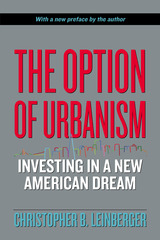 The Option of Urbanism: Investing in a New American Dream
Christopher B. Leinberger
Island Press, 2009 Americans are voting with their feet to abandon strip malls and suburban sprawl, embracing instead a new type of community where they can live, work, shop, and play within easy walking distance. In The Option of Urbanism visionary developer and strategist Christopher B. Leinberger explains why government policies have tilted the playing field toward one form of development over the last sixty years: the drivable suburb. Rooted in the driving forces of the economy—car manufacturing and the oil industry—this type of growth has fostered the decline of community, contributed to urban decay, increased greenhouse gas emissions, and contributed to the rise in obesity and asthma.
Highlighting both the challenges and the opportunities for this type of development, The Option of Urbanism shows how the American Dream is shifting to include cities as well as suburbs and how the financial and real estate communities need to respond to build communities that are more environmentally, socially, and financially sustainable.
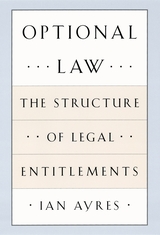 Optional Law: The Structure of Legal Entitlements
Ian Ayres
University of Chicago Press, 2005 Spurred by the advances in option theory that have been remaking financial and economic scholarship over the past thirty years, a revolution is taking shape in the way legal scholars conceptualize property and the way it is protected by the law. Ian Ayres's Optional Law explores how option theory is overthrowing many accepted wisdoms and producing tangible new tools for courts in deciding cases.
Ayres identifies flaws in the current system and shows how option theory can radically expand and improve the ways that lawmakers structure legal entitlements. An option-based system, Ayres shows, gives parties the option to purchase—or the option to sell—the relevant legal entitlement. Choosing to exercise a legal option forces decisionmakers to reveal information about their own valuation of the entitlement. And, as with auctions, entitlements in option-based law naturally flow to those who value them the most. Seeing legal entitlements through this lens suggests a variety of new entitlement structures from which lawmakers might choose. Optional Law provides a theory for determining which structure is likely to be most effective in harnessing parties' private information.
Proposing a practical approach to the foundational question of how to allocate and protect legal rights, Optional Law will be applauded by legal scholars and professionals who continue to seek new and better ways of fostering both equitable and efficient legal rules.
Or, Gone: Poems
Deborah Flanagan
Tupelo Press, 2015 Deborah Flanagan’s prizewinning new chapbook is populated by a menagerie of historic personages — celebrities and scientists, political and artistic luminaries, including George Washington, Houdini, Samuel Beckett, Peggy Guggenheim, Francis Bacon, Casanova, and Lord Byron’s daughter, the mathematician Ada Lovelace. Juggling voices as she romps among her personae, the poet revisits and revises our complicated connections to the past in ways orthodox history can’t possibly do: coding and decoding her stories while bursting out of the boxes into which we try to fit meaning.
or, on being the other woman
Simone White
Duke University Press, 2022 In or, on being the other woman, Simone White considers the dynamics of contemporary black feminist life. Throughout this book-length poem, White writes through a hybrid of poetry, essay, personal narrative, and critical theory, attesting to the narrative complexities of writing and living as a black woman and artist. She considers black social life—from art and motherhood to trap music and love—as unspeakably troubling and reflects on the degree to which it strands and punishes black women. She also explores what constitutes sexual freedom and the rewards and dangers that come with it. White meditates on trap music and the ways artists such as Future and Meek Mill and the sonic waves of the drum machine convey desire and the black experience. Charting the pressures of ordinary black womanhood, White pushes the limits of language, showing how those limits can be the basis for new modes of expression.
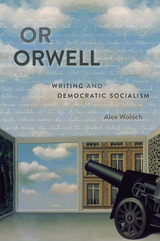 Or Orwell: Writing and Democratic Socialism
Alex Woloch
Harvard University Press, 2016 There have been many studies of George Orwell’s life and work, but nothing quite like this book by Alex Woloch—an exuberant, revisionary account of Orwell’s writing.
“Good prose is like a window-pane,” Orwell famously avers. But what kind of literary criticism is possible, face-to-face with Orwell’s plain-style prose? Too often this style has been either dismissed by a seemingly more savvy critical theory, or held up as a reprimand against the enterprise of theory. In a series of unusually close and intensive readings—focused on the unstable event of writing itself—Woloch recovers the radical and experimental energies of Orwell’s prose. Against accounts that would quickly naturalize Orwell’s truthfulness or reduce his window-pane prose to bad faith, Woloch’s study bears down on a propulsive irony and formal restlessness that have always been intertwined with Orwell’s plain-style. Such restlessness, far from diluting Orwell’s democratic and socialist politics, is at its aesthetic and conceptual core.
The first half of Or Orwell ranges across his nonfiction prose, including new readings of “A Hanging,” The Road to Wigan Pier, and Inside the Whale. The second half develops an extended analysis of a single writing project: Orwell’s eighty “As I Please” newspaper columns, written for the Socialist weekly Tribune. Moving through multiple forms and genres, testing the limits of each, Orwell emerges in Woloch’s fine-grained account as a boldly unconventional writer and a central figure in twentieth-century literature and political thought.
 The Oracle and the Curse: A Poetics of Justice from the Revolution to the Civil War
Caleb Smith
Harvard University Press, 2013 Condemned to hang after his raid on Harper’s Ferry, John Brown prophesied that the crimes of a slave-holding land would be purged away only with blood. A study of omens, maledictions, and inspired invocations, The Oracle and the Curse examines how utterances such as Brown’s shaped American literature between the Revolution and the Civil War.
In nineteenth-century criminal trials, judges played the role of law’s living oracles, but offenders were also given an opportunity to address the public. When the accused began to turn the tables on their judges, they did so not through rational arguments but by calling down a divine retribution. Widely circulated in newspapers and pamphlets, these curses appeared to channel an otherworldly power, condemning an unjust legal system and summoning readers to the side of righteousness.
Exploring the modes of address that communicated the authority of law and the dictates of conscience in antebellum America’s court of public opinion, Caleb Smith offers a new poetics of justice which assesses the nonrational influence that these printed confessions, trial reports, and martyr narratives exerted on their first audiences. Smith shows how writers portrayed struggles for justice as clashes between human law and higher authority, giving voice to a moral protest that transformed American literature.
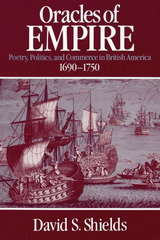 Oracles of Empire: Poetry, Politics, and Commerce in British America, 1690-1750
David S. Shields
University of Chicago Press, 1990 This innovative look at previously neglected poetry in British America represents a major contribution to our understanding of early American culture. Spanning the period from the Glorious Revolution (1690) to the end of King George's War (1750), this study critically reconstitutes the literature of empire in the thirteen colonies, Canada, and the West Indies by investigating over 300 texts in mixed print and manuscript sources, including poems in pamphlets and newspapers.
British America's poetry of empire was dominated by three issues: mercantilism's promise that civilization and wealth would be transmitted from London to the provinces; the debate over the extent of metropolitan prerogatives in law and commerce when they obtruded upon provincial rights and interests; and the argument that Britain's imperium pelagi was an ethical empire, because it depended upon the morality of trade, while the empires of Spain and France were immoral empires because they were grounded upon conquest. In discussing these issues, Shields provides a virtual anthology of poems long lost to students of American literature.
The Oracles of Zeus: Dodona, Olympia, Ammon
H. W. Parke
Harvard University Press After Delphi, Dodona was the most important of the oracles in Ancient Greece. The somewhat limited literary references to Dodona's history have been supplemented in recent years by valuable archaeological findings, illustrating particularly its use by private inquirers. In this book, the first time the subject has been treated at length, H. W. Parke examines in detail the chief problems concerning Dodona's activity and assesses all the available evidence while clearly distinguishing between what is certain, what is probable, and what is merely speculative. He combines his analysis with studies of Olympia and Ammon, the two other sites where the Greeks consulted Zeus.
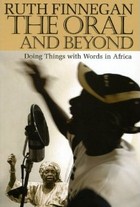 The Oral and Beyond: Doing Things with Words in Africa
Ruth Finnegan
University of Chicago Press, 2007 With her 1976 book Oral Literature in Africa, Ruth Finnegan almost single-handedly created the field of ethnography of language. Now, Finnegan has gathered and updated a selection of her best work on oral literature, performance, and the creative use of language in Africa, along with several new essays that broaden and extend her ideas.
The Oral and Beyond looks simultaneously backwards and forwards, reviewing and critiquing the achievements of scholarship on African oral literature, revisiting issues of perennial contention, and highlighting some of the most interesting new ideas and approaches in the field. Exploring such fundamental questions as how texts and textuality relate to performance, how ideology inflects language, and how traditional forms adapt to modern media and popular culture, Finnegan essentially crafts an intellectual history of her field. At the same time, she propels the ethnography of language forward, bringing the techniques and knowledge developed through her fieldwork in Africa to bear on issues that transcend African studies and reach into the larger world of anthropology and beyond.
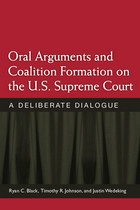 Oral Arguments and Coalition Formation on the U.S. Supreme Court: A Deliberate Dialogue
Ryan C. Black, Timothy R. Johnson, and Justin Wedeking
University of Michigan Press, 2014 The U.S. Supreme Court, with its controlled, highly institutionalized decision-making practices, provides an ideal environment for studying coalition formation. The process begins during the oral argument stage, which provides the justices with their first opportunity to hear one another's attitudes and concerns specific to a case. This information gathering allows them eventually to form a coalition.
In order to uncover the workings of this process, the authors analyze oral argument transcripts from every case decided from 1998 through 2007 as well as the complete collection of notes kept during oral arguments by Justice Lewis F. Powell and Justice Harry A. Blackmun. Both justices clearly monitored their fellow justices' participation in the discussion and used their observations to craft opinions their colleagues would be likely to support. This study represents a major step forward in the understanding of coalition formation, which is a crucial aspect of many areas of political debate and decision making.
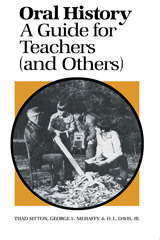 Oral History: A Guide for Teachers (and Others)
By Thad Sitton, George L. Mehaffy, and O.L. Davis, Jr.
University of Texas Press, 1983 More than a mode of gathering information about the past, oral history has become an international movement. Historians, folklorists, and other educational and religious groups now recognize the importance of preserving the recollections of people about the past. The recorded memories of famous and common folk alike provide a vital complement to textbook history, bringing the past to life through the stories of those who lived it. Oral History is designed to introduce teachers, students, and interested individuals to the techniques, problems, and pleasures of collecting oral history. The authors, themselves experienced educators, examine the uses of oral history in the classroom, looking at a wide range of projects that have been attempted and focusing on those that have succeeded best. Besides suggesting many possible projects, they discuss the necessary hardware and its use: recording equipment and procedures, interview outlines and preliminary research, photography and note-taking in the field, transcription and storage of information, legal forms, and more. For the teacher, the authors offer helpful advice on training students to be sensitive interviewers in both formal and informal situations. How can oral histories collected in the classroom be put to use? The authors discuss their uses within the curriculum; in projects such as oral history archives, publications such as the popular Foxfire books, and other media productions; and in researching current community problems. Useful appendixes survey a variety of reference tools for the oral historian and describe in detail how a Foxfire-concept magazine may be developed.
Oral History and Delinquency: The Rhetoric of Criminology
James Bennett
University of Chicago Press, 1981 From Henry Mayhew's classic study of Victorian slums to Studs Terkel's presentations of ordinary people in modern America, oral history has been used to call attention to social conditions. By analyzing the nature and circumstances of the production of such histories of delinquency, James Bennett argues that oral history is a rhetorical device, consciously chosen as such, and is to be understood in terms of its persuasive powers and aims. Bennett shows how oral or life histories of juvenile delinquents have been crucial in communicating the human traits of offenders within their social context, to attract interest in resources for programs to prevent delinquency. Although life history helped to establish the discipline of sociology, Bennett suggests concepts for understanding oral histories generated in many fields.
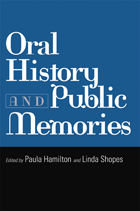 Oral History and Public Memories
Paula Hamilton
Temple University Press, 2008 Oral history is inherently about memory, and when oral history interviews are used "in public," they invariably both reflect and shape public memories of the past. Oral History and Public Memories is the only book that explores this relationship, in fourteen case studies of oral history's use in a variety of venues and media around the world. Readers will learn, for example, of oral history based efforts to reclaim community memory in post-apartheid Cape Town, South Africa; of the role of personal testimony in changing public understanding of Japanese American history in the American West; of oral history's value in mapping heritage sites important to Australia's Aboriginal population; and of the way an oral history project with homeless people in Cleveland, Ohio became a tool for popular education. Taken together, these original essays link the well established practice of oral history to the burgeoning field of memory studies.
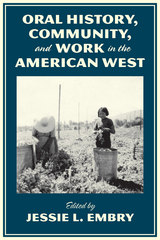 Oral History, Community, and Work in the American West
Edited by Jessie L. Embry
University of Arizona Press, 2013 Nurses, show girls, housewives, farm workers, casino managers, and government inspectors—together these hard-working members of society contributed to the development of towns across the West. The essays in this volume show how oral history increases understanding of work and community in the twentieth century American West.
In many cases occupations brought people together in myriad ways. The Latino workers who picked lemons together in Southern California report that it was baseball and Cinco de Mayo Queen contests that united them. Mormons in Fort Collins, Colorado, say that building a church together bonded them together. In separate essays, African Americans and women describe how they fostered a sense of community in Las Vegas. Native Americans detail the “Indian economy” in Northern California.
As these essays demonstrate, the history of the American West is the story of small towns and big cities, places both isolated and heavily populated. It includes groups whose history has often been neglected. Sometimes, western history has mirrored the history of the nation; at other times, it has diverged in unique ways. Oral history adds a dimension that has often been missing in writing a comprehensive history of the West. Here an array of oral historians—including folklorists, librarians, and public historians—record what they have learned from people who have, in their own ways, made history.
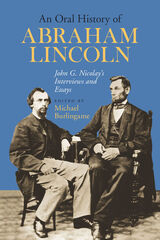 An Oral History of Abraham Lincoln: John G. Nicolay's Interviews and Essays
Edited by Michael Burlingame
Southern Illinois University Press, 2006 John C. Nicolay, who had known Lincoln in Springfield, Illinois, served as chief White House secretary from 1861 to 1865. Trained as a journalist, Nicolay had hoped to write a campaign biography of Lincoln in 1860, a desire that was thwarted when an obscure young writer named William Dean Howells got the job. Years later, however, Nicolay fulfilled his ambition; with John Hay, he spent the years from 1872 to 1890 writing a monumental ten-volume biography of Lincoln. In preparation for this task, Nicolay interviewed men who had known Lincoln both during his years in Springfield and later when he became the president of the United States. "When it came time to write their massive biography, however," Burlingame notes, "he and Hay made sparing use of the interviews" because they had become "skeptical about human memory." Nicolay and Hay also feared that Robert Todd Lincoln might censor material that reflected "poorly on Lincoln or his wife." Nicolay had interviewed such Springfield friends as Lincoln’s first two law partners, John Todd Stuart and Stephen T. Logan. At the Illinois capital in June and July 1875, he talked to a number of others including Orville H. Browning, U.S. senator and Lincoln’s close friend and adviser for over thirty-five years, and Ozias M. Hatch, Lincoln’s political ally and Springfield neighbor. Four years later he returned briefly and spoke with John W. Bunn, a young political "insider" from Springfield at the time Lincoln was elected president, and once again with Hatch. Browning shed new light on Lincoln’s courtship and marriage, telling Nicolay that Lincoln often told him "that he was constantly under great apprehension lest his wife should do something which would bring him into disgrace" while in the White House. During their research, Nicolay and Hay also learned of Lincoln’s despondency and erratic behavior following his rejection by Matilda Edwards, and they were subsequently criticized by friends for suppressing the information. Burlingame argues that this open discussion of Lincoln’s depression of January 1841 is "perhaps the most startling new information in the Springfield interviews." Briefer and more narrowly focused than the Springfield interviews, the Washington interviews deal with the formation of Lincoln’s cabinet, his relations with Congress, his behavior during the war, his humor, and his grief. In a reminiscence by Robert Todd Lincoln, for example, we learn of Lincoln’s despair at General Lee's escape after the Battle of Gettysburg: "I went into my father’s office ... and found him in [much] distress, his head leaning upon the desk in front of him, and when he raised his head there were evidences of tears upon his face. Upon my asking the cause of his distress he told me that he had just received the information that Gen. Lee had succeeded in escaping across the Potomac river. . ." To supplement these interviews, Burlingame has included Nicolay’s unpublished essays on Lincoln during the 1860 campaign and on Lincoln’s journey from Springfield to Washington in 1861, essay’s based on firsthand testimony.
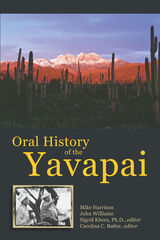 Oral History of the Yavapai
Mike Harrison and John Williams; Edited by Sigrid Khera and Carolina C. Butler
University of Arizona Press, 2015 In the 1970s, the Fort McDowell Reservation in Arizona came under threat by a dam construction project that, if approved, would potentially flood most of its 24,680 acres of land. As part of the effort to preserve the reservation, Mike Harrison and John Williams, two elders of the Yavapai tribe, sought to have their history recorded as they themselves knew it, as it had been passed down to them from generation to generation, so that the history of their people would not be lost to future generations. In March 1974, Arizona State University anthropologist Sigrid Khera first sat down with Harrison and Williams to begin recording and transcribing their oral history, a project that would continue through the summer of 1976 and beyond.
Although Harrison and Williams have since passed away, their voices shine through the pages of this book and the history of their people remains to be passed along and shared. Thanks to the efforts of Scottsdale, Arizona, resident and Orme Dam activist Carolina Butler, this important document is being made available to the public for the first time.
Oral History of the Yavapai offers a wide range of information regarding the Yavapai people, from creation beliefs to interpretations of historical events and people. Harrison and Williams not only relate their perspectives on the relationship between the “White people” and the Native American peoples of the Southwest, but they also share stories about prayers, songs, dreams, sacred places, and belief systems of the Yavapai.
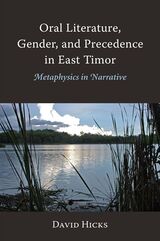 Oral Literature, Gender, and Precedence in East Timor: Metaphysics in Narrative
David Hicks
National University of Singapore Press, 2020 Decades of war, social upheaval and political change have not lessened the enduring interest of the people of East Timor (Timor-Leste) in their oral traditions, something they share with their neighbours in the eastern islands of Indonesia. Although oral literature continues to occupy a central place in Timorese cultures, new forms of expression are emerging (for instance via published fiction and in social media). Nonetheless, the corpus of Timorese oral narrative largely retains an underlying metaphysical unity. Among others, it continues to express indigenous notions about gender and precedence – two important sociocultural markers that are among the most prominent topics currently under discussion by scholars of the region today. What has yet to be done, however, is to bring Timorese oral narratives into mainstream social science scholarship by subjecting them to a rigorous scholarly analysis. That is the purpose of this masterly study by the veteran Timor scholar, David Hicks. Drawing upon more than a half century of fieldwork and publishing, he discusses the tropes found in and illuminating Timorese metaphysical thought and literature. No other work has discussed these tropes before nor indeed attempted to discern patterns of thought in Timorese narratives. Certainly, the study will be of interest to scholars of literature, social science, structural analysis, Indonesian cultures and philosophy, as well as to those interested in the country’s colonial past and in efforts to conserve its natural environment. The book should also appeal to educated citizens of Timor-Leste; here is a work illuminating how future aspirations might be grounded in a common heritage.
The Oral Palimpsest: Exploring Intertextuality in the Homeric Epics
Christos Tsagalis
Harvard University Press, 2008 Oral intertextuality is an innate feature of the web of myth, whose interrelated fabrics allow the audience of epic song to have access to an entire horizon of diverse variants of a story. The Oral Palimpsest argues that just as the erased text of a palimpsest still carries traces of its previous writing, so the Homeric tradition unfolds its awareness of alternative versions in the act of producing the signs of their erasure.
In this light, "Homer" reflects the concerted effort to create a Panhellenic canon of epic song, through which we can still retrieve the poikilia (roughly, "dappled, embroidered variation") of various interwoven fabrics belonging to recognizable song-traditions or even older Indo-European strata.
Oral Patterns of Performance: Story and Song
Barre Toelken
Utah State University Press, 2003 To many Native American cultures, songs and stories are dramatic enactments of reality, and words bring reality into existence. In this chapter from his award-winning book, The Anguish of Snails, Toelken thoughtfully approaches a number of stories from Native American traditions, discussing how narratives can be touchstones of shared values among closely associated traditional people and how songs and stories go far beyond an evening's entertainment or "lessons” about life. A traditional narrative can be a culturally structured way of thinking and of experiencing the patterns that make culture real.
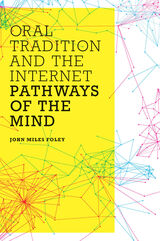 Oral Tradition and the Internet: Pathways of the Mind
John Miles Foley
University of Illinois Press, 2012 The major purpose of this book is to illustrate and explain the fundamental similarities and correspondences between humankind's oldest and newest thought-technologies: oral tradition and the Internet. Despite superficial differences, both technologies are radically alike in depending not on static products but rather on continuous processes, not on "What?" but on "How do I get there?" In contrast to the fixed spatial organization of the page and book, the technologies of oral tradition and the Internet mime the way we think by processing along pathways within a network. In both media it's pathways--not things--that matter. To illustrate these ideas, this volume is designed as a "morphing book," a collection of linked nodes that can be read in innumerable different ways. Doing nothing less fundamental than challenging the default medium of the linear book and page and all that they entail, Oral Tradition and the Internet shows readers that there are large, complex, wholly viable, alternative worlds of media-technology out there--if only they are willing to explore, to think outside the usual, culturally constructed categories. This "brick-and-mortar" book exists as an extension of The Pathways Project (http://pathwaysproject.org), an open-access online suite of chapter-nodes, linked websites, and multimedia all dedicated to exploring and demonstrating the dynamic relationship between oral tradition and Internet technology
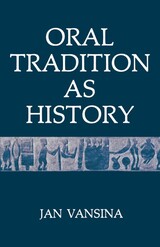 Oral Tradition as History
Jan M. Vansina
University of Wisconsin Press, 1985 Jan Vansina’s 1961 book, Oral Tradition, was hailed internationally as a pioneering work in the field of ethno-history. Originally published in French, it was translated into English, Spanish, Italian, Arabic, and Hungarian. Reviewers were unanimous in their praise of Vansina’s success in subjecting oral traditions to intense functional analysis.
Now, Vansina—with the benefit of two decades of additional thought and research—has revised his original work substantially, completely rewriting some sections and adding much new material. The result is an essentially new work, indispensable to all students and scholars of history, anthropology, folklore, and ethno-history who are concerned with the transmission and potential uses of oral material.
“Those embarking on the challenging adventure of historical fieldwork with an oral community will find the book a valuable companion, filled with good practical advice. Those who already have collected bodies of oral material, or who strive to interpret and analyze that collected by others, will be forced to subject their own methodological approaches to a critical reexamination in the light of Vansina’s thoughtful and provocative insights. . . . For the second time in a quarter of a century, we are profoundly in the debt of Jan Vansina.”—Research in African Literatures
“Oral Traditions as History is an essential addition to the basic literature of African history.”—American Historical Review
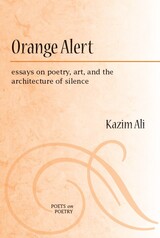 Orange Alert: essays on poetry, art, and the architecture of silence
Kazim Ali
University of Michigan Press, 2010 "Orange Alert is a poetic and yogic salvo across the bows of our defensive imperial posturing. Kazim Ali's essays leap deftly from homages to avant-garde artists (Yoko Ono, Agnes Martin, John Cage) to awestruck meditations on ancient architecture, from analyses of poets (Jane Cooper, Agha Shahid Ali, Mahmoud Darwish, Lucille Clifton) to twitter aphorisms. Orange Alert is a revelation, a salve, an invitation to breathe again."
---Philip Metres, Associate Professor, Department of English, John Carroll University "With their delicacy of attention and bold range of subjects, Kazim Ali's essays hold many quiet surprises. In each art he searches for insight and craft---the virtues of his own patient writing."
---Susan Stewart, Chancellor, Academy of American Poets; and Professor, Princeton University "Kazim Ali's essays, like his poems, are alive with curiosity and humanity. . . . Orange Alert makes a compelling case for the necessity of poetry on a planet wracked by war and devastation."
---Timothy Yu, Associate Professor, English and Asian American Studies, University of Wisconsin-Madison A volume in the Poets on Poetry series, which collects critical works by contemporary poets, gathering together the articles, interviews, and book reviews by which they have articulated the poetics of a new generation. Whether he is discussing the way cell phones have altered physical intimacy and introduced new verb forms, or the way Emily Dickinson's mysteries are more clearly revealed in French translation, Kazim Ali is at once clear and complex, rigorous and charming, accessible and demanding. In Orange Alert, Ali discusses poets including Agha Shahid Ali, Jane Cooper, Bhanu Kapil, Semezdin Mehmedinovic, and Samuel Beckett. He considers painters Agnes Martin and Piet Mondrian, musicians Alice Coltrane and Yoko Ono, and philosophers Slavoj Žižek and Jean Baudrillard. Ali links the poetic endeavor to such diverse texts as Moby-Dick, Battlestar Galactica, and Marilyn Buck's prison journals. Ali discusses contemporary poetry in relation to other art forms and to contemporary television; film; and electronic media, including the Internet, YouTube, and Facebook. He shines a light on the intersections between cultures in these essays on the craft of poetry, offering a hand to poets either geographically or metaphorically outside the mainstream of Western culture. Kazim Ali is the author of two books of poetry, The Far Mosque and The Fortieth Day; two novels, Quinn's Passage and The Disappearance of Seth; and a memoir, Bright Felon: Autobiographyand Cities. He is Assistant Professor of Creative Writing at Oberlin College. He has been a regular columnist for American Poetry Review.
Orange Parades: The Politics of Ritual, Tradition and Control
Dominic Bryan
Pluto Press, 2000 In the first major study of the Protestant Loyalist Orange Order in Northern Ireland, Dominic Bryan provides a detailed ethnographic and historical study of Orange Order parades. He looks at the development of the parades, the history of disputes over the parades, the structure and politics of the Orange Order, the organisation of loyalist bands, the role of social class in Unionist politics – and the anthropology of ritual itself.
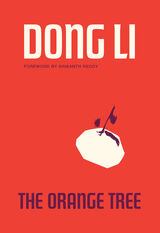 The Orange Tree
Dong Li
University of Chicago Press, 2023 Debut collection of poems that weaves stories of family history, war, and migration.
Dong Li’s The Orange Tree is a collection of narrative poems that braids forgotten legends, personal sorrows, and political upheavals into a cinematic account of Chinese history as experienced by one family. Amid chaos and catastrophe, the child narrator examines a yellowed family photo to find resemblances and learns a new language, inventing compound words to conjure and connect family stories. These invented words and the calligraphy of untranslated Chinese characters appear in lists separating the book’s narrative sections.
Li’s lyrical and experimental collection transcends the individual, placing generations of family members and anonymous others together in a single moment that surpasses chronological time. Weaving through stories of people with little means, between wars and celebrations, over bridges and walls, and between trees and gardens, Li’s poems offer intimate perspectives on times that resonate with our own. The result is an unflinching meditation on family history, collective trauma, and imaginative recovery.
The Orange Tree is the recipient of the inaugural Phoenix Emerging Poet Book Prize for 2023.
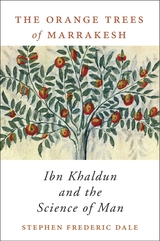 The Orange Trees of Marrakesh: Ibn Khaldun and the Science of Man
Stephen Frederic Dale
Harvard University Press, 2015 In his masterwork Muqaddimah, the Arab Muslim Ibn Khaldun (1332–1406), a Tunisian descendant of Andalusian scholars and officials in Seville, developed a method of evaluating historical evidence that allowed him to identify the underlying causes of events. His methodology was derived from Aristotelian notions of nature and causation, and he applied it to create a dialectical model that explained the cyclical rise and fall of North African dynasties. The Muqaddimah represents the world’s first example of structural history and historical sociology. Four centuries before the European Enlightenment, this work anticipated modern historiography and social science.
In Stephen F. Dale’s The Orange Trees of Marrakesh, Ibn Khaldun emerges as a cultured urban intellectual and professional religious judge who demanded his fellow Muslim historians abandon their worthless tradition of narrative historiography and instead base their works on a philosophically informed understanding of social organizations. His strikingly modern approach to historical research established him as the premodern world’s preeminent historical scholar. It also demonstrated his membership in an intellectual lineage that begins with Plato, Aristotle, and Galen; continues with the Greco-Muslim philosophers al-Farabi, Avicenna, and Averroes; and is renewed with Montesquieu, Hume, Adam Smith, and Durkheim.
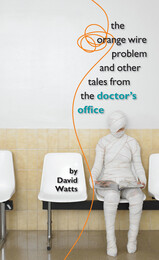 The Orange Wire Problem and Other Tales from the Doctor’s Office
David Watts
University of Iowa Press, 2009 Western literature has had a long tradition of physician-writers. From Mikhail Bulgakov to William Carlos Williams to Richard Selzer to Ethan Canin, exposure to human beings at their most vulnerable has inspired fine writing. In his own inimitable and unpretentious style, David Watts is also a master storyteller. Whether recounting the decline and death of a dear friend or poking holes in the faulty logic of an insurance company underling, The Orange Wire Problem lays bare the nobility and weakness, generosity and churlishness of human nature.
With disarming candor and the audacity to admit that practicing medicine can be a crazy thing, Watts fills each page with riveting details, moving accounts, or belly-laughs. As the stories in this work unfold, we are witness to the moral dilemmas and personal rewards of ministering to the sick. Whether the subject is the potential benefits of therapeutic deception or telling a child about death, Watts’s ear for the right word, the right tone, and the right detail never fails him.
From The Orange Wire Problem and Other Tales from the Doctor’s Office:
We were lingering in the outer office. He mentioned again, no biopsy. I knew that. And I knew there would be no chemotherapy.
Maybe it's like that Orange Wire Problem, I said.
Yes exactly, he said, and four years from now when we're all sitting around the campfire we'll remember the Orange Wire Problem. . .
And I thought to myself, my brother did that. Spoke of the time ahead as he was dying of lung cancer. Six months from now he had said, we'll be glad we did all those drug therapies—as if to speak of the future laid claim to the future.
 Orations. Other Fragments
Cato
Harvard University Press, 2023 Ancient Rome’s original archconservative.
M. Porcius Cato (234–149 BC), one of the best-known figures of the middle Roman Republic, remains legendary for his political and military career, especially his staunch opposition to Carthage; his modest way of life; his integrity of character and austere morality; his literary works, composed in a style at once sophisticated and down-to-earth; his pithy sayings; and his drive to define and to champion Roman national character and traditions in the face of challenges from Greek culture. Cato’s legend derived to no small degree from his own distinctive and compelling self-presentation, which established a model later developed and elaborated by Cicero and by subsequent literary and historical authors for centuries to come.
This volume and its companion (LCL 551) join the Loeb edition of Cato’s only extant work, On Agriculture (LCL 283), by supplying all testimonia about, and all fragments by or attributed to Cato. Highlights are Origines, the first historical work attested in Latin, a history of Rome from its founding to the onset of the first Punic War, as well as the origins of major Italian cities; his orations, regarded as the beginning of Roman oratory; To His Son Marcus, which inaugurated a Roman tradition of didactic pieces addressed by fathers to their sons; Military Matters; the Poem on Morals; letters; commentaries on civil law; and memorable sayings.
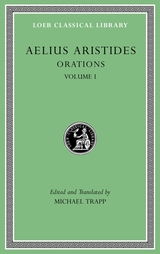 Orations, Volume I
Aelius Aristides
Harvard University Press, 2017 Meticulous eloquence.
Publius Aelius Aristides Theodorus was among the most celebrated, versatile, and influential authors of the Second Sophistic era and an important figure in the transmission of Hellenism. Born to wealthy landowners in Mysia in AD 117, he studied in Athens and Pergamum and had begun a promising oratorical career when in the early 140s he fell chronically ill and retreated to the healing shrine of Asclepius in Pergamum. There he began to follow a lifelong series of dream revelations and instructions from the god that inspired the six autobiographical books of Sacred Tales, an invaluable record of both temple therapy and personal religious experience published in the 170s. By 147 Aristides was able to resume his public activities as a member of the landed and gubernatorial elite and to pursue a successful oratorical career. Based at his family estate in Smyrna, he traveled between bouts of illness and produced speeches and lectures for both public and private occasions, declamations on historical themes, polemical works, prose hymns, and essays on a wide variety of subjects, all of it displaying deep and creative familiarity with the classical literary heritage. He died between 180 and 185.
This edition of Aristides’ complete works offers fresh translations and texts based on the critical editions of Lenz-Behr (Orations 1–16) and Keil (Orations 17–53). Volume I contains the Panathenaic Oration, a historical appreciation of classical Athens and Aristides’ most influential work, and A Reply to Plato, the first of three essays taking issue with the attack on orators and oratory delivered in Plato’s Gorgias.
Orations, Volume I: Orations 1–17 and 20: Olynthiacs. Philippics. Minor Public Orations
Demosthenes
Harvard University Press The preeminent orator of ancient Athens.
Demosthenes (384–322 BC), orator at Athens, was a pleader in law courts who later became also a statesman, champion of the past greatness of his city and the present resistance of Greece to Philip of Macedon’s rise to supremacy. We possess by him political speeches and law-court speeches composed for parties in private cases and political cases. His early reputation as the best of Greek orators rests on his steadfastness of purpose, his sincerity, his clear and pungent argument, and his severe control of language. In his law cases he is the advocate, in his political speeches a castigator not of his opponents but of their politics. Demosthenes gives us vivid pictures of public and private life of his time.
The Loeb Classical Library edition of Demosthenes is in seven volumes.
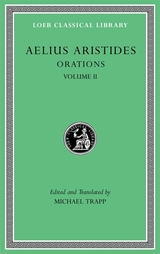 Orations, Volume II
Aelius Aristides
Harvard University Press, 2017 Meticulous eloquence.
Publius Aelius Aristides Theodorus was among the most celebrated, versatile, and influential authors of the Second Sophistic era and an important figure in the transmission of Hellenism. Born to wealthy landowners in Mysia in AD 117, he studied in Athens and Pergamum and had begun a promising oratorical career when in the early 140s he fell chronically ill and retreated to the healing shrine of Asclepius in Pergamum. There he began to follow a lifelong series of dream revelations and instructions from the god that inspired the six autobiographical books of Sacred Tales, an invaluable record of both temple therapy and personal religious experience published in the 170s. By 147 Aristides was able to resume his public activities as a member of the landed and gubernatorial elite and to pursue a successful oratorical career. Based at his family estate in Smyrna, he traveled between bouts of illness and produced speeches and lectures for both public and private occasions, declamations on historical themes, polemical works, prose hymns, and essays on a wide variety of subjects, all of it displaying deep and creative familiarity with the classical literary heritage. He died between 180 and 185.
This edition of Aristides’ complete works offers fresh translations and texts based on the critical editions of Lenz-Behr (Orations 1–16) and Keil (Orations 17–53). Volume II contains Oration 3 (In Defense of the Four) and Oration 4, (A Reply to Capito), which along with Oration 2 take issue with the attack on orators and oratory delivered in Plato’s Gorgias.
Orations, Volume II: Orations 18–19: De Corona. De Falsa Legatione
Demosthenes
Harvard University Press The preeminent orator of ancient Athens.
Demosthenes (384–322 BC), orator at Athens, was a pleader in law courts who later became also a statesman, champion of the past greatness of his city and the present resistance of Greece to Philip of Macedon’s rise to supremacy. We possess by him political speeches and law-court speeches composed for parties in private cases and political cases. His early reputation as the best of Greek orators rests on his steadfastness of purpose, his sincerity, his clear and pungent argument, and his severe control of language. In his law cases he is the advocate, in his political speeches a castigator not of his opponents but of their politics. Demosthenes gives us vivid pictures of public and private life of his time.
The Loeb Classical Library edition of Demosthenes is in seven volumes.
Orations, Volume III: Orations 21–26: Against Meidias. Against Androtion. Against Aristocrates. Against Timocrates. Against Aristogeiton
Demosthenes
Harvard University Press The preeminent orator of ancient Athens.
Demosthenes (384–322 BC), orator at Athens, was a pleader in law courts who later became also a statesman, champion of the past greatness of his city and the present resistance of Greece to Philip of Macedon’s rise to supremacy. We possess by him political speeches and law-court speeches composed for parties in private cases and political cases. His early reputation as the best of Greek orators rests on his steadfastness of purpose, his sincerity, his clear and pungent argument, and his severe control of language. In his law cases he is the advocate, in his political speeches a castigator not of his opponents but of their politics. Demosthenes gives us vivid pictures of public and private life of his time.
The Loeb Classical Library edition of Demosthenes is in seven volumes.
Orations, Volume IV: Orations 27–40: Private Cases
Demosthenes
Harvard University Press The preeminent orator of ancient Athens.
Demosthenes (384–322 BC), orator at Athens, was a pleader in law courts who later became also a statesman, champion of the past greatness of his city and the present resistance of Greece to Philip of Macedon’s rise to supremacy. We possess by him political speeches and law-court speeches composed for parties in private cases and political cases. His early reputation as the best of Greek orators rests on his steadfastness of purpose, his sincerity, his clear and pungent argument, and his severe control of language. In his law cases he is the advocate, in his political speeches a castigator not of his opponents but of their politics. Demosthenes gives us vivid pictures of public and private life of his time.
The Loeb Classical Library edition of Demosthenes is in seven volumes.
Orations, Volume V: Orations 41–49: Private Cases
Demosthenes
Harvard University Press The preeminent orator of ancient Athens.
Demosthenes (384–322 BC), orator at Athens, was a pleader in law courts who later became also a statesman, champion of the past greatness of his city and the present resistance of Greece to Philip of Macedon’s rise to supremacy. We possess by him political speeches and law-court speeches composed for parties in private cases and political cases. His early reputation as the best of Greek orators rests on his steadfastness of purpose, his sincerity, his clear and pungent argument, and his severe control of language. In his law cases he is the advocate, in his political speeches a castigator not of his opponents but of their politics. Demosthenes gives us vivid pictures of public and private life of his time.
The Loeb Classical Library edition of Demosthenes is in seven volumes.
Orations, Volume VI: Orations 50–59: Private Cases. In Neaeram
Demosthenes
Harvard University Press The preeminent orator of ancient Athens.
Demosthenes (384–322 BC), orator at Athens, was a pleader in law courts who later became also a statesman, champion of the past greatness of his city and the present resistance of Greece to Philip of Macedon’s rise to supremacy. We possess by him political speeches and law-court speeches composed for parties in private cases and political cases. His early reputation as the best of Greek orators rests on his steadfastness of purpose, his sincerity, his clear and pungent argument, and his severe control of language. In his law cases he is the advocate, in his political speeches a castigator not of his opponents but of their politics. Demosthenes gives us vivid pictures of public and private life of his time.
The Loeb Classical Library edition of Demosthenes is in seven volumes.
Orations, Volume VII: Orations 60–61: Funeral Speech. Erotic Essay. Exordia. Letters
Demosthenes
Harvard University Press The preeminent orator of ancient Athens.
Demosthenes (384–322 BC), orator at Athens, was a pleader in law courts who later became also a statesman, champion of the past greatness of his city and the present resistance of Greece to Philip of Macedon’s rise to supremacy. We possess by him political speeches and law-court speeches composed for parties in private cases and political cases. His early reputation as the best of Greek orators rests on his steadfastness of purpose, his sincerity, his clear and pungent argument, and his severe control of language. In his law cases he is the advocate, in his political speeches a castigator not of his opponents but of their politics. Demosthenes gives us vivid pictures of public and private life of his time.
The Loeb Classical Library edition of Demosthenes is in seven volumes.
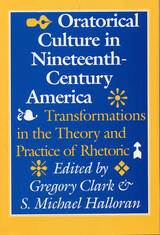 Oratorical Culture in Nineteenth-Century America: Transformations in the Theory and Practice of Rhetoric
Gregory Clark and S. Michael Halloran
Southern Illinois University Press, 1993 Gregory Clark and S. Michael Halloran bring together nine essays that explore change in both the theory and the practice of rhetoric in the nineteenth-century United States. In their introductory essay, Clark and Halloran argue that at the beginning of the nineteenth century, rhetoric encompassed a neoclassical oratorical culture in which speakers articulated common values to establish consensual moral authority that directed community thought and action. As the century progressed, however, moral authority shifted from the civic realm to the professional, thus expanding participation in the community as it fragmented the community itself. Clark and Halloran argue that this shift was a transformation in which rhetoric was reconceived to meet changing cultural needs. Part I examines the theories and practices of rhetoric that dominated at the beginning of the century. The essays in this section include "Edward Everett and Neoclassical Oratory in Genteel America" by Ronald F. Reid, "The Oratorical Poetic of Timothy Dwight" by Gregory Clark, "The Sermon as Public Discourse: Austin Phelps and the Conservative Homiletic Tradition in Nineteenth-Century America" by Russel Hirst, and "A Rhetoric of Citizenship in Nineteenth-Century America" by P. Joy Rouse. Part 2 examines rhetorical changes in the culture that developed during that century. The essays include "The Popularization of Nineteenth-Century Rhetoric: Elocution and the Private Learner" by Nan Johnson, "Rhetorical Power in the Victorian Parlor: Godey’s Lady’s Book and the Gendering of Nineteenth-Century Rhetoric" by Nicole Tonkovich, "Jane Addams and the Social Rhetoric of Democracy" by Catherine Peaden, "The Divergence of Purpose and Practice on the Chatauqua: Keith Vawter’s Self-Defense" by Frederick J.Antczak and Edith Siemers, and "The Rhetoric of Picturesque Scenery: A Nineteenth-Century Epideictic" by S. Michael Halloran.
 The Orator’s Education, Volume I: Books 1–2
Quintilian
Harvard University Press, 2001 A central work in the history of rhetoric.
Quintilian, born in Spain about AD 35, became a widely known and highly successful teacher of rhetoric in Rome. The Orator’s Education (Institutio Oratoria), a comprehensive training program in twelve books, draws on his own rich experience. It is a work of enduring importance, not only for its insights on oratory, but for the picture it paints of education and social attitudes in the Roman world.
Quintilian offers both general and specific advice. He gives guidelines for proper schooling (beginning with the young boy); analyzes the structure of speeches; recommends devices that will engage listeners and appeal to their emotions; reviews a wide range of Greek and Latin authors of use to the orator; and counsels on memory, delivery, and gestures.
Donald Russell’s five-volume Loeb Classical Library edition of The Orator’s Education, which replaces an eighty-year-old translation by H. E. Butler, provides a text and facing translation that are fully up to date in light of current scholarship and well tuned to today’s manner of expression. Russell also provides unusually rich explanatory notes, which enable full appreciation of this central work in the history of rhetoric.
 The Orator’s Education, Volume II: Books 3–5
Quintilian
Harvard University Press, 2001 A central work in the history of rhetoric.
Quintilian, born in Spain about AD 35, became a widely known and highly successful teacher of rhetoric in Rome. The Orator’s Education (Institutio Oratoria), a comprehensive training program in twelve books, draws on his own rich experience. It is a work of enduring importance, not only for its insights on oratory, but for the picture it paints of education and social attitudes in the Roman world.
Quintilian offers both general and specific advice. He gives guidelines for proper schooling (beginning with the young boy); analyzes the structure of speeches; recommends devices that will engage listeners and appeal to their emotions; reviews a wide range of Greek and Latin authors of use to the orator; and counsels on memory, delivery, and gestures.
Donald Russell’s five-volume Loeb Classical Library edition of The Orator’s Education, which replaces an eighty-year-old translation by H. E. Butler, provides a text and facing translation that are fully up to date in light of current scholarship and well tuned to today’s manner of expression. Russell also provides unusually rich explanatory notes, which enable full appreciation of this central work in the history of rhetoric.
 The Orator’s Education, Volume III: Books 6–8
Quintilian
Harvard University Press, 2001 A central work in the history of rhetoric.
Quintilian, born in Spain about AD 35, became a widely known and highly successful teacher of rhetoric in Rome. The Orator’s Education (Institutio Oratoria), a comprehensive training program in twelve books, draws on his own rich experience. It is a work of enduring importance, not only for its insights on oratory, but for the picture it paints of education and social attitudes in the Roman world.
Quintilian offers both general and specific advice. He gives guidelines for proper schooling (beginning with the young boy); analyzes the structure of speeches; recommends devices that will engage listeners and appeal to their emotions; reviews a wide range of Greek and Latin authors of use to the orator; and counsels on memory, delivery, and gestures.
Donald Russell’s five-volume Loeb Classical Library edition of The Orator’s Education, which replaces an eighty-year-old translation by H. E. Butler, provides a text and facing translation that are fully up to date in light of current scholarship and well tuned to today’s manner of expression. Russell also provides unusually rich explanatory notes, which enable full appreciation of this central work in the history of rhetoric.
 The Orator’s Education, Volume IV: Books 9–10
Quintilian
Harvard University Press, 2001 A central work in the history of rhetoric.
Quintilian, born in Spain about AD 35, became a widely known and highly successful teacher of rhetoric in Rome. The Orator’s Education (Institutio Oratoria), a comprehensive training program in twelve books, draws on his own rich experience. It is a work of enduring importance, not only for its insights on oratory, but for the picture it paints of education and social attitudes in the Roman world.
Quintilian offers both general and specific advice. He gives guidelines for proper schooling (beginning with the young boy); analyzes the structure of speeches; recommends devices that will engage listeners and appeal to their emotions; reviews a wide range of Greek and Latin authors of use to the orator; and counsels on memory, delivery, and gestures.
Donald Russell’s five-volume Loeb Classical Library edition of The Orator’s Education, which replaces an eighty-year-old translation by H. E. Butler, provides a text and facing translation that are fully up to date in light of current scholarship and well tuned to today’s manner of expression. Russell also provides unusually rich explanatory notes, which enable full appreciation of this central work in the history of rhetoric.
 The Orator’s Education, Volume V: Books 11–12
Quintilian
Harvard University Press, 2001 A central work in the history of rhetoric.
Quintilian, born in Spain about AD 35, became a widely known and highly successful teacher of rhetoric in Rome. The Orator’s Education (Institutio Oratoria), a comprehensive training program in twelve books, draws on his own rich experience. It is a work of enduring importance, not only for its insights on oratory, but for the picture it paints of education and social attitudes in the Roman world.
Quintilian offers both general and specific advice. He gives guidelines for proper schooling (beginning with the young boy); analyzes the structure of speeches; recommends devices that will engage listeners and appeal to their emotions; reviews a wide range of Greek and Latin authors of use to the orator; and counsels on memory, delivery, and gestures.
Donald Russell’s five-volume Loeb Classical Library edition of The Orator’s Education, which replaces an eighty-year-old translation by H. E. Butler, provides a text and facing translation that are fully up to date in light of current scholarship and well tuned to today’s manner of expression. Russell also provides unusually rich explanatory notes, which enable full appreciation of this central work in the history of rhetoric.
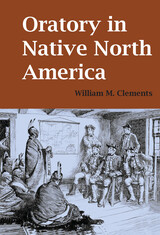 Oratory in Native North America
William M. Clements
University of Arizona Press, 2002 In Euroamerican annals of contact with Native Americans, Indians have consistently been portrayed as master orators who demonstrate natural eloquence during treaty negotiations, councils, and religious ceremonies. Esteemed by early European commentators more than indigenous storytelling, oratory was in fact a way of establishing self-worth among Native Americans, and might even be viewed as their supreme literary achievement. William Clements now explores the reasons for the acclaim given to Native oratory. He examines in detail a wide range of source material representing cultures throughout North America, analyzing speeches made by Natives as recorded by whites, such as observations of treaty negotiations, accounts by travelers, missionaries' reports, captivity narratives, and soldiers' memoirs.
Here is a rich documentation of oratory dating from the earliest records: Benjamin Franklin's publication of treaty proceedings with the Six Nations of the Iroquois; the travel narratives of John Lawson, who visited Carolina Indians in the early 1700s; accounts of Jesuit missionary Pierre De Smet, who evangelized to Northern Plains Indians in the nineteenth century; and much more. The book also includes full texts of several orations. These texts are comprehensive documents that report not only the contents of the speeches but the entirety of the delivery: the textures, situations, and contexts that constitute oratorical events. While there are valid concerns about the reliability of early recorded oratory given the prejudices of those recording them, Clements points out that we must learn what we can from that record.
He extends the thread unwoven in his earlier study Native American Verbal Art to show that the long history of textualization of American Indian oral performance offers much that can reward the reader willing to scrutinize the entirety of the texts. By focusing on this one genre of verbal art, he shows us ways in which the sources are—and are not—valuable and what we must do to ascertain their value. Oratory in Native North America is a panoramic work that introduces readers to a vast history of Native speech while recognizing the limitations in premodern reporting. By guiding us through this labyrinth, Clements shows that with understanding we can gain significant insight not only into Native American culture but also into a rich storehouse of language and performance art.
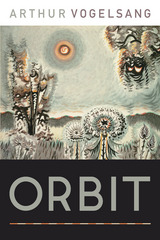 Orbit
Arthur Vogelsang
University of Pittsburgh Press, 2016 Orbit connects the intimate with what is farthest from us, mixing what we can imagine with what is daily and near. Landscapes stretch from stable and fulfilling domestic interiors to the destiny of our sun as an exploding red giant. That dilemma of human fertility and love facing ultimate destruction is orchestrated by the author’s provocative voice and coiled lines, which fondle and handle the reader’s heart and mind in a bright light. The book insists on connecting the three eras of human experience – Then, Now, and When – at every turn. Orbit continues the unique aesthetic of Vogelsang’s first five award-winning books through its “oddly direct original persona,” its “mind – prophetic, wild, loony,” its “language of surveillance and trembling,” and the poems’ ability “to find and magnify the emotion suddenly, instantaneously” (comments draw from other poets’ reviews.) Vogelsang’s new book Orbit is a dialogue between daily life and transcendent vision, insisting on the reality of each.
 Orbiting the Sun: Planets and Satellites of the Solar System
Fred L. Whipple
Harvard University Press, 1981 --Spokes and braids in the rings of Saturn
--Eddying currents around Jupiter's Great Red Spot
--Volcanic eruptions on the satellite Io
These are the images from Voyager that have made headlines and captured the public imagination. Now, a giant of twentieth century astronomy guides us on a literary voyage of discovery that retraces the steps of this and other recent space probes--Viking, Mariner, Pioneer, as well as Russian efforts--that have revolutionized our understanding of Earth's nearest neighbors. Every step of the way, Fred Whipple provides the basic foundation in astronomy that enables the reader to be not merely awed and entranced but thoroughly informed, with a solid and satisfying understanding of the workings of our solar system.
In a dazzling combination of text and illustrations, Orbiting the Sun offers vistas that rival science fiction:
--mountains on Mars twice the height of Everest
--thunderstorms and sulfuric acid clouds on Venus
--the possibility of liquid nitrogen oceans on Titan
But the author also explores in precise detail the tests carried out by the Viking Lander that with virtual certainty have ruled out the hope of finding life on Mars.
This completely revised and updated edition of Whipple's classic Earth, Moon, and Planets once again presents Earth within its planetary context. This view allows us to speculate on such provocative concepts as the connection between an asteroid collision and the extinction of the dinosaurs. But the most obvious enhancement of this new edition is the stunning photographs, that include the eerie panorama of the Martian landscape taken from the Viking Landers, the dramatic sweep of Saturn's thousand rings, and full color port raits of the Jovian moons--the battered face of Callisto, Europa with its web of thin scratches, the "superhighways" of Ganymede, and Io with its volcanic plumes.
Fred Whipple has introduced two generations of student and amateur astronomers to the wonders of the solar system. In Orbiting the Sun he will charm and inform an entirely new audience.
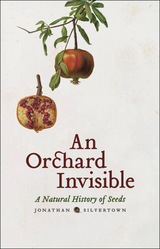 An Orchard Invisible: A Natural History of Seeds
Jonathan Silvertown
University of Chicago Press, 2009 The story of seeds, in a nutshell, is a tale of evolution. From the tiny sesame that we sprinkle on our bagels to the forty-five-pound double coconut borne by the coco de mer tree, seeds are a perpetual reminder of the complexity and diversity of life on earth. With An Orchard Invisible, Jonathan Silvertown presents the oft-ignored seed with the natural history it deserves, one nearly as varied and surprising as the earth’s flora itself. Beginning with the evolution of the first seed plant from fernlike ancestors more than 360 million years ago, Silvertown carries his tale through epochs and around the globe. In a clear and engaging style, he delves into the science of seeds: How and why do some lie dormant for years on end? How did seeds evolve? The wide variety of uses that humans have developed for seeds of all sorts also receives a fascinating look, studded with examples, including foods, oils, perfumes, and pharmaceuticals. An able guide with an eye for the unusual, Silvertown is happy to take readers on unexpected—but always interesting—tangents, from Lyme disease to human color vision to the Salem witch trials. But he never lets us forget that the driving force behind the story of seeds—its theme, even—is evolution, with its irrepressible habit of stumbling upon new solutions to the challenges of life. "I have great faith in a seed," Thoreau wrote. "Convince me that you have a seed there, and I am prepared to expect wonders." Written with a scientist’s knowledge and a gardener’s delight, An Orchard Invisible offers those wonders in a package that will be irresistible to science buffs and green thumbs alike.
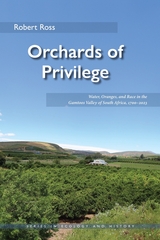 Orchards of Privilege: Water, Oranges, and Race in the Gamtoos Valley of South Africa, 1700–2023
Robert Ross
Ohio University Press, 2025 This study of the Gamtoos River floodplain in South Africa’s Eastern Cape Province traces its transformation from an eighteenth-century natural landscape of thick bush into an agricultural zone now threatened by climate change. The first half of the book explains how missionaries from the London Missionary Society and residents of the Hankey Mission Station introduced irrigation, turning the area into a community of small-scale farmers. Despite early failures, by 1849 they had constructed South Africa’s first major irrigation tunnel and aqueduct. However, conflicts between the missionaries and residents led to the loss of communal lands to privatization, which ultimately impoverished the local farmers. The second half explores efforts to develop the valley for large-scale agriculture, addressing challenges like drought, flash floods, and saline water. By the mid-twentieth century, Afrikaners dominated the area, benefiting from the construction in 1970 of the Kouga Dam, which provided fresh water for the floodplain. This led to the rise of a wealthy white farming community, sustained by apartheid policies and labor from the “Coloured” and African populations. In the early twenty-first century, however, this prosperity has become threatened by severe droughts linked to global climate change. In view of these historical transformations, the Gamtoos River floodplain exemplifies the complex interplay between human ambition, environmental challenges, and sociopolitical forces.
Orchestrating Public Opinion: How Music Persuades in Television Political Ads for US Presidential Campaigns, 1952-2016
Paul Christiansen
Amsterdam University Press, 2018 Analysis of political advertising tends to give music short shrift - which flies in the face of what we know about the power of music to set a mood, affect feelings, and influence our perceptions. This book is the first to offer a detailed exploration of the role of music in US presidential campaign advertising, from Eisenhower to the present, showing that in many cases music isn't simply one element in the presentation of an ad's message - it's the dominant factor, more important than images, words, or narration.
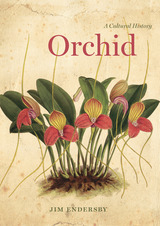 Orchid: A Cultural History
Jim Endersby
University of Chicago Press, 2016 At once delicate, exotic, and elegant, orchids are beloved for their singular, instantly recognizable beauty. Found in nearly every climate, the many species of orchid have carried symbolic weight in countless cultures over time. The ancient Greeks associated them with fertility and thought that parents who ingested orchid root tubers could control the sex of their child. During the Victorian era, orchids became deeply associated with romance and seduction. And in twentieth-century hard-boiled detective stories, they transformed into symbols of decadence, secrecy, and cunning. What is it about the orchid that has enthralled the imagination for so many centuries? And why do they still provoke so much wonder?
Following the stories of orchids throughout history, Jim Endersby divides our attraction to them into four key themes: science, empire, sex, and death. When it comes to empire, for instance, orchids are a prime example of the exotic riches sought by Europeans as they shaped their plans for colonization. He also reveals how Charles Darwin’s theory of evolution became intimately entangled with the story of the orchid as he investigated their methods of cross-pollination. As he shows, orchids—perhaps because of their extraordinarily diverse colors, shapes, and sizes—have also bloomed repeatedly in films, novels, plays, and poems, from Shakespeare to science fiction, from thrillers to elaborate modernist novels.
Featuring many gorgeous illustrations from the collection of the Royal Botanic Gardens, Kew, Orchid: A Cultural History tells, for the first time, the extraordinary story of orchids and our prolific interest in them. It is an enchanting tale not only for gardeners and plant collectors, but anyone curious about the flower’s obsessive hold on the imagination in history, cinema, literature, and more.
The Orchid House
Allfrey, Phyllis Shand
Rutgers University Press, 1996 Lally helps to raise three white sisters in the Orchid House on the Island of Dominica and observes as each flees to the cold northern lands of England and America only to return to their magical past and the man they love.
 Orchid of the Bayou: A Deaf Woman Faces Blindess
Cathryn Carroll
Gallaudet University Press, 2001 In graduating from Gallaudet University, finding a job in Washington, D.C., and starting a family with her college sweetheart, Kitty Fischer tacitly abandoned the Louisiana Cajun culture that had exposed her to little more than prejudice and misery as a child. Upon discovering that she suffered from Usher syndrome (a genetic condition that causes both deafness and blindness), however, Fischer began an unlikely journey toward reclaiming her heritage. She and Cathryn Carroll tell the story of her heroic struggle and cultural odyssey in Orchid of the Bayou: A Deaf Woman Faces Blindness.
“By this time Mama knew I was ‘not right,’” Fischer says of her early childhood. “She knew the real words for ‘not right,’ too, though she never said those words. I was deaf and dumb.” Initially Fischer’s parents turned to folk healers to try and “cure” their daughter’s deafness, but an aunt’s fortunate discovery of the Louisiana School for the Deaf would rescue Fischer from misunderstanding and introduce her to sign language and Deaf culture. She weathered the school’'s experiments with oralism and soon rose to the top of her class, ultimately leaving Louisiana for the academic promise of Gallaudet.
While in college, Fischer met and married her future husband, Lance, a Jewish Deaf man from Brooklyn, New York, and each landed jobs close to their alma mater. After the birth of their first child, however, Fischer could no longer ignore her increasing tunnel vision. Doctors quickly confirmed that Fischer had Usher syndrome.
While Fischer struggled to come to terms with her condition, the high incidence of Usher syndrome among Cajun people led her to re-examine her cultural roots. “Could I still be me, Catherine Hoffpauir Fischer, had I not been born of a mix that codes for Usher syndrome?” she asks. “To some extent, the history of my people explains the constitution of my genes and the way my life has unfolded.” Today Fischer prospers, enjoying her time with family and friends and celebrating the Deaf, Cajun, Blind, and Jewish cultures that populate her life. Her lively story will resonate with anyone who recognizes the arduous journey toward claiming an identity.
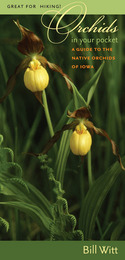 Orchids in Your Pocket: A Guide to the Native Orchids of Iowa (10-pack)
Bill Witt
University of Iowa Press, 2006 10-PACK IN A POP DISPLAYFrom 1843, when the first collections were made, until 1987, when an amateur botanist discovered the only known Iowa site for spring ladies tresses, thirty-two species of orchids have been recorded in Iowa. The state’s wild orchids range in size from the three-inch-tall delicately blossomed nodding pogonia of the eastern woodlands to the three-foot-tall floral spike of the western prairie fringed orchid and in color from whites and pale pastels to buttery yellows and passionate pinks. Flower shapes run the gamut, too, from the tight-lipped parsimony of the fall coral-root to the cheerful roundness of the yellow lady’s-slipper.Along with superb color photographs of all thirty-two species, this latest addition to Iowa’s series of laminated guides includes common and scientific names, habitat (prairie, woodland, wetland) and distribution, height, approximate time of blooming, status, and potential for hybridization. Bill Witt devotes a separate panel to species missing and presumed extirpated; photos of orchids from nearby states illustrate these lost species. Because orchids have highly specific requirements for germination, growth, and reproduction, the conversion of natural lands for agricultural development has resulted in such loss of habitat that all but a handful of orchid species are now considered threatened or endangered; two orchid species are now known to live in just one site each; and three species have likely been wiped out. Orchids in Your Pocket is a welcome reminder of the beauty and fragility of these native species and their prairie, woodland, and wetland homes.
 The Orchids: Natural History and Classification
Robert Dressler
Harvard University Press, 1990 This lively examination of the structure, classification, evolution, and ecology of the Orchidaceae will appeal to anyone with an eye for beauty or a bent for natural history. It will provide professional biologists and amateur orchidists alike with a deeper understanding--and a thoroughly new classification--of this, the largest flowering family in the plant kingdom.
The book is richly illustrated, with 95 color photographs and 99 line drawings emphasizing orchid morphology. But in the context of serious orchidology, aesthetic richness is not a superficial vanity. It is the result of evolutionary processes that demand adaptation and reward diversity, and Dressler's exploration of these mechanisms demonstrates how well the orchids have met the challenge, with over 20,000 species, a geographical range from Sweden to Tierra del Fuego, and, at times, as many as 47 different species on a single tree. But both the orchids' success and their profligate beauty are grounded, in part, in their voluptuary nature, and one of Dressler's most engaging themes is the reproductive adaptations, worthy of a Renaissance courtesan, that orchids use to attract, deceive, and manipulate pollinating insects.
The orchid family is actively evolving, providing rich possibilities for comparative study. Yet no one, whether professional or amateur, could reasonably proceed without first addressing Robert Dressler's The Orchids. Its new classification alone, including pollination biology, phyletic trends, chromosome counts, and generic relationships, will stand as a watershed contribution to the field.
Orchids of Madagascar Second Edition
Edited by Johan Hermans, Clare Hermans, David Du Puy, Phillip Cribb, and Jean Bosser
Royal Botanic Gardens, Kew, 2007 A new edition of a now classic work, with the diagnostic notes on each species extended to provide much additional information on distribution, habitat and flowering times. The number of colour photographs has been greatly increased to cover over 250 orchids, and line drawings of new species added in an appendix, while the bibliography has been refined to include the most essential references, with new entries accompanied by concise annotations. This is still the one essential book for botanist, orchid enthusiast, ecologist, environmentalist and field worker who need to have the complete picture on Madagascar’s orchid flora.
 Ordaining Women: Culture and Conflict in Religious Organizations
Mark Chaves
Harvard University Press, 1997 Why does a denomination prohibiting women clergy support parishes run by women? Why does a denomination opt to ordain women when there are few women seeking to join that clergy? And why have some denominations ordained women so much earlier than others? In a revealing examination of the complex relationship among religion, social forces, and organizational structure, Ordaining Women draws examples and data from over 100 Christian denominations to explore the meaning of institutional rules about women's ordination.
Combining historical and sociological perspectives, Mark Chaves deftly shows that formal institutional rules about ordination often diverge from the actual roles of women and are best understood as symbolic gestures in favor of--or in opposition to--gender equality. Ordaining Women concludes that external pressures from the women's movement and ecumenical pressure expressed through interdenominational organizations such as the National Council of Churches influence ordination practices. At the same time, internal factors such as having a source of religious authority that is considered superior to modern principles of equal rights also explain why some denominations ordain women much earlier than others.
Surprisingly, "the Bible forbids it" does not account for policies even among fundamentalists and other biblical inerrantists. Chaves' historical and comparative approach offers a revealing analysis of how the internal denominational debates have changed over time, becoming more frequent, more politicized, and more contentious. The skillful delineation of forces affecting debates and policies about women's ordination makes this book an important contribution to our understanding of religious organizations and of gender equality.
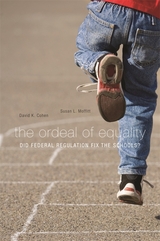 The Ordeal of Equality: Did Federal Regulation Fix the Schools?
David K. Cohen and Susan L. Moffitt
Harvard University Press, 2009 American schools have always been locally created and controlled. But ever since the Title I program in 1965 appropriated nearly one billion dollars for public schools, federal money and programs have been influencing every school in America.What has been accomplished in this extraordinary assertion of federal influence? What hasn’t? Why not? With incisive clarity and wit, David K. Cohen and Susan L. Moffitt argue that enormous gaps existed between policies and programs and the real-world practices that they attempted to change. Learning and teaching are complicated and mysterious. So the means to achieve admirable goals are uncertain, and difficult to develop and sustain, particularly when teachers get little help to cope with the blizzard of new programs, new slogans, new tests, and new rules.Ironically, as the authors observe, the least experienced and least well-trained teachers are often in the most needy schools, so federal support “is compromised by the inequality it is intended to ameliorate.” If new policies and programs don’t include means to create the capability they require, they cannot succeed. We don’t know what we need to enable states, school systems, schools, teachers, and students to use the resources that programs offer. The trouble with standards-based reform is that standards and tests still don’t teach you how to teach.
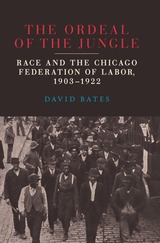 The Ordeal of the Jungle: Race and the Chicago Federation of Labor, 1903–1922
David Bates
Southern Illinois University Press, 2019 Between 1910 and 1920, the Chicago Federation of Labor (CFL) inaugurated a massive organizing drive in the city’s meatpacking and steel industries. Although the CFL sought legitimately progressive goals, worked earnestly to organize an interracial union, and made major inroads among both black and white workers, their efforts resulted in a bitter defeat. David Bates provides a clear picture of how even the most progressive of intentions can be ground to a halt.
By organizing workers into neighborhood locals, which connected workplace struggles to ethnic and religious identities, the CFL facilitated a surge in the organization’s membership, particularly among African American workers, and afforded the federation the opportunity to aggressively confront employers. The CFL’s innovative structure, however, was ultimately its demise. Linking union locals to neighborhoods proved to be a form of de facto segregation. Over time union structures, rank-and-file conflicts, and employer resistance combined to turn the union’s hopeful calls for solidarity into animosity and estrangement. Tensions were exacerbated by violent shop floor confrontations and exploded in the bloody 1919 Chicago Race Riot. By the early 1920s, the CFL had collapsed.
The Ordeal of the Jungle explores the choices of a variety of people while showing a complex, overarching interplay of black and white workers and their employers. In addition to analyzing union structures and on-the-ground relations between workers, Bates synthesizes and challenges previous scholarship on interracial organizing to explain the failure of progressive unionism in Chicago.
The Ordeal of Thomas Hutchinson
Bernard Bailyn
Harvard University Press “This book,” Bernard Bailyn writes, “depicts the fortunes of a conservative in a time of radical upheaval and deals with problems of public disorder and ideological commitment.” It is at the same time a dramatic account of the origins of the American Revolution from the viewpoint, not of the winners who became the Founding Fathers, but of the losers, the Loyalists. By portraying the ordeal of the last civilian royal governor of Massachusetts, Mr. Bailyn explains “what the human reality was against which the victors struggled” and in doing so makes the story of the Revolution fuller and more comprehensible.
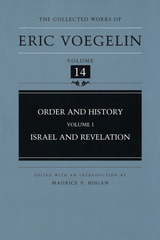 Order and History, Volume 1 (CW14): Israel and Revelation
Eric Voegelin, Edited & Intro by Maurice P. Hogan
University of Missouri Press, 2001 Eric Voegelin's Israel and Revelation is the opening volume of his monumental Order and History, which traces the history of order in human society. This volume examines the ancient near eastern civilizations as a backdrop to a discussion of the historical locus of order in Israel. The drama of Israel mirrors the problems associated with the tension of existence as Israel attempted to reconcile the claims of transcendent order with those of pragmatic existence and so becomes paradigmatic. According to Voegelin, what happened in Israel was a decisive step, not only in the history of Israel, but also in the human attempt to achieve order in society. The uniqueness of Israel is the fact that it was the first to create history as a form of existence, that is, the recognition by human beings of their existence under a world-transcendent God, and the evaluation of their actions as conforming to or defecting from the divine will. In the course of its history, Israel learned that redemption comes from a source beyond itself. Voegelin develops rich insights into the Old Testament by reading the text as part of the universal drama of being. His philosophy of symbolic forms has immense implications for the treatment of the biblical narrative as a symbolism that articulates the experiences of a people's order. The author initiates us into attunement with all the partners in the community of being: God and humans, world and society. This may well be his most significant contribution to political thought: "the experience of divine being as world transcendent is inseparable from an understanding of man as human."
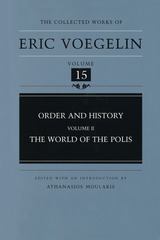 Order and History, Volume 2 (CW15): The World of the Polis
Eric Voegelin. Edited & Intro by Athanasios Moulakis
University of Missouri Press, 2000 This second volume of Voegelin's magisterial Order and History, The World of the Polis, explores the ancient Greek symbolization of human reality. Taking us from the origins of Greek culture in the Pre-Homeric Cretan civilizations, through the Iliad and Odyssey, Hesiod, and the rise of philosophy with the Pre-Socratics Parmenides and Heraclitus, this masterful work concludes with the historians of the classical period. In The World of the Polis, Voegelin traces the emergence of the forms of the city-state and of philosophy from the ancient symbolism of myth. He maintains that the limits and ultimate goals of human nature are constant and that the central problem of every society is the same—"to create an order that will endow the fact of its existence with meaning in terms of ends divine and human." Thus, Voegelin shows how "the meaning of existence" achieved concrete expression in the typical political, social, and religious institutions of Greece and in the productions of its poets and thinkers. He deals with more than fifty Greek writers in the course of his analysis of the rise of myth and its representation of the divine order of the cosmos as the first great symbolic form of order, one later supplanted by the leap in being reflected in the emergence of philosophy. The book is a tour de force, a virtuoso performance by a scholar and philosopher of great power, learning, and imagination that places its subject matter in a new light. The editor's critical introduction places The World of the Polis in the broader context of Voegelin's philosophy of history. Scholars and students of political science, philosophy, and the history of ideas will find this work invaluable.
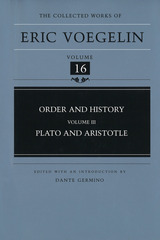 Order and History, Volume 3 (CW16): Plato and Aristotle
Eric Voegelin. Edited & Intro by Dante Germino
University of Missouri Press, 2000 This third volume of Order and History completes Voegelin's study of Greek culture from its earliest pre- Hellenic origins to its full maturity with the dominance of Athens. As the title suggests, Plato and Aristotle is principally devoted to the work of the two great thinkers who represent the high point of philosophic inquiry among the Greeks. Through an absorbing analysis of the Platonic and Aristotelian vision of soul, polis, and cosmos, Voegelin demonstrates how the symbolic framework of the older myth was superseded by the more precisely differentiated symbols of philosophy. Although this outmoding and rejection of past symbols of truth might seem to lead to a chaotic and despairing relativism, Voegelin makes it the basis of a profound conception of the historical process: "the attempts to find the symbolic forms that will adequately express the meaning [of a society], while imperfect, do not form a senseless series of failures. For the great societies have created a sequence of orders, intelligibly connected with one another as advances toward, or recessions from, an adequate symbolization of the truth concerning the order of being of which the order of society is a part." In this view, history has no obvious "meaning," yet each society makes a similar venture after truth. Although every society works out its destiny under different conditions, each nonetheless creates symbols"in its deeds and institutions"which bear the meaning of its own existence. History, then, acquires a unity in the common endeavor toward meaning and order. The rationality and nobility of this view of history has much to say to the present age. Dante Germino's powerful introduction to this edition of Plato and Aristotle eloquently directs the reader into Voegelin's search through the thought of Plato foremost and Aristotle secondarily and toward a full understanding of their relevance to the "modern" world. This masterpiece, Germino argues, provides a welcome antidote to the spirit of an era Voegelin once called the Gnostic age.
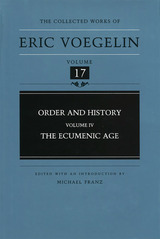 Order and History, Volume 4 (CW17): The Ecumenic Age
Eric Voegelin. Edited & Intro by Michael Franz
University of Missouri Press, 2000 Order and History, Eric Voegelin's five-volume study of how human and divine order are intertwined and manifested in history, has been widely acclaimed as one of the great intellectual achievements of our age. In the fourth volume, The Ecumenic Age, Voegelin breaks with the course he originally charted for the series, in which human existence in society and the corresponding symbolism of order were to be presented in historical succession. The analyses in the three previous volumes remain valid as far as they go, Voegelin explains, but the original conception proved "untenable because it had not taken proper account of the important lines of meaning in history that did not run along lines of time." The Ecumenic Age treats history not as a stream of human beings and their actions in time, but as the process of man's participation in a flux of divine presence that has eschatological direction. "The process of history, and such order as can be discerned in it," Voegelin writes, "is not a story to be told from the beginning to its happy, or unhappy, end; it is a mystery in process of revelation." In the present volume, Voegelin applies his revised conception of historical analysis to the "Ecumenic Age," a pivotal period that extends roughly from the rise of the Persian Empire to the fall of the Roman. The age is marked by the advent of a new type of political unit—the ecumenic empire—achieved at the cost of unprecedented destruction. Yet the pragmatic destructiveness of the age is paralleled by equally unprecedented spiritual creativity, born from the need to make sense of existence in the wake of imperial conquest. These spiritual outbursts gave rise to the great ecumenic religions and raised fundamental questions for human self- understanding that extend into our historical present.
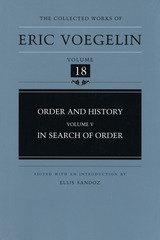 Order and History, Volume 5 (CW18): In Search of Order
Eric Voegelin, Edited & Intro by Ellis Sandoz
University of Missouri Press, 2000 In Search of Order brings to a conclusion Eric Voegelin's masterwork, Order and History. Voegelin conceived Order and History as "a philosophical inquiry concerning the principal types of order of human existence in society and history as well as the corresponding symbolic forms." In previous volumes, Voegelin discussed the imperial organizations of the ancient Near East and their existence in the form of the cosmological myth; the revelatory form of existence in history, developed by Moses and the prophets of the Chosen People; the polis, the Hellenic myth, and the development of philosophy as the symbolism of order; and the evolution of the great religions, especially Christianity. This final volume of Order and History is devoted to the elucidation of the experience of transcendence that Voegelin discussed in earlier volumes. He aspires to show in a theoretically acute manner the exact nature of transcendental experiences. Voegelin's philosophical inquiry unfolds in the historical context of the great symbolic enterprise of restating man's humanity under the horizon of the modern sciences and in resistance to the manifold forces of our age that deform human existence. His stature as one of the major philosophical forces of the twentieth century clearly emerges from these concluding pages. In Search of Order deepens and clarifies the meditative movement that Voegelin, now in reflective distance to his own work, sees as having been operative throughout his search. Because of Voegelin's death, on January 19, 1985, In Search of Order is briefer than it otherwise might have been; however, the theoretical presentation that he had set for himself is essentially completed here. Just as this volume serves Voegelin well in his striking analyses of Hegel, Hesiod, and Plato, it will serve as a model for the reader's own efforts in search of order.
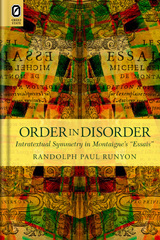 Order in Disorder: Intratextual Symmetry in Montaigne's “Essais”
Randolph Paul Runyon
Ohio State University Press, 2013 Montaigne’s Essays are treasured for their philosophical and moral insights and the fascinating portrait they give us of the man who wrote them, but another of their undoubted delights is that they tantalize the reader, offering beneath an apparent disorder some hints of a hidden plan. After all, though the essayist kept adding new pages, except when he added the third and final book he never added a new chapter, but worked within the structure already in place.
Order in Disorder: Intratextual Symmetry in Montaigne’s “Essais,” by Randolph Paul Runyon, offers a new answer to the question of how ordered the Essays may be. Following up on Montaigne’s likening them to a painter’s “grotesques” surrounding a central image, and seeing in this an allusion to the ancient Roman decorative style, rediscovered in the Renaissance, of symmetrical motifs on either side of a central image, Runyon uncovers an extensive network of symmetrical verbal echoes linking every chapter with another. Often two chapters of greatly different length and apparent importance (one on thumbs, for instance, balanced against one on the limits of human understanding) will in this way be brought together—not without, Runyon finds, an intended irony. The Essays emerge as even more self-reflexive than we thought, an amazingly intratextual work.
 Order In The Twilight
Bernhard Waldenfels
Ohio University Press, 1996 “Whoever distrusts the barking of watchdogs, however, does not immediately have to begin howling with the wolves.”—Bernhard Waldenfels In this seminal work, acclaimed philosopher Bernhard Waldenfels deals with the problem of the nature of order after the “shattering of the world,” and the loss of the idea of a universal or fundamental order. Order in the Twilight unites phenomenological methodology with recent work on the theory of order, normativity, and dialogue, as well as structuralism and Gestalt theory. Philosophically stringent, it expresses a more optimistic attitude than much modern philosophy, especially deconstruction. Waldenfels passes the question of order through numerous defining aspects, and concludes that there is not one global order, but rather various conflicting domains of order. Whenever the boundary of a vital or experiential domain is crossed, a discourse speaks at the boundary, not about it, and across a threshold without abolishing it. The rest is rationalization, i.e., an attempt to find a place in the respective order for what is to-be-ordered. But why, the author concludes, should a theory be more unambiguous than reality? Order in the Twilight is an important book at this time, because it may help lift the humanities out of the skeptical, relativistic disarray in which they have been embroiled in recent decades. Waldenfels does not attempt to dictate what reality should be; rather, he is open to any valid evidences. His book offers a solid footing to the human and social sciences as they seek to escape from deconstructive irrationalism.
Order, Materiality, and Urban Space in the Early Modern Kingdom of Sweden
Riitta Laitinen
Amsterdam University Press, 2017 Our corporeality and immersion in the material world make us inherently spatial beings, and the fact that we all share everyday experiences in the global physical environment means that community is also spatial by nature. This book explores the relationship between the seventeenth-century townspeople of Turku, Sweden, and their urban surroundings. Riitta Laitinen offers a novel account of civil and social order in this early modern town, highlighting the central importance of materiality and spatiality and breaking down the dichotomy of public versus private life that has dominated traditional studies of the time period.
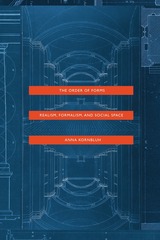 The Order of Forms: Realism, Formalism, and Social Space
Anna Kornbluh
University of Chicago Press, 2019 In literary studies today, debates about the purpose of literary criticism and about the place of formalism within it continue to simmer across periods and approaches. Anna Kornbluh contributes to—and substantially shifts—that conversation in The Order of Forms by offering an exciting new category, political formalism, which she articulates through the co-emergence of aesthetic and mathematical formalisms in the nineteenth century. Within this framework, criticism can be understood as more affirmative and constructive, articulating commitments to aesthetic expression and social collectivity.
Kornbluh offers a powerful argument that political formalism, by valuing forms of sociability like the city and the state in and of themselves, provides a better understanding of literary form and its political possibilities than approaches that view form as a constraint. To make this argument, she takes up the case of literary realism, showing how novels by Dickens, Brontë, Hardy, and Carroll engage mathematical formalism as part of their political imagining. Realism, she shows, is best understood as an exercise in social modeling—more like formalist mathematics than social documentation. By modeling society, the realist novel focuses on what it considers the most elementary features of social relations and generates unique political insights. Proposing both this new theory of realism and the idea of political formalism, this inspired, eye-opening book will have far-reaching implications in literary studies.
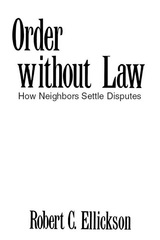 Order without Law: How Neighbors Settle Disputes
Robert Ellickson
Harvard University Press, 1994 In Order without Law, Robert Ellickson shows that law is far less important than is generally thought. He demonstrates that people largely govern themselves by means of informal rules—social norms—that develop without the aid of a state or other central coordinator. Integrating the latest scholarship in law, economics, sociology, game theory, and anthropology, Ellickson investigates the uncharted world within which order is successfully achieved without law.
The springboard for Ellickson’s theory of norms is his close investigation of a variety of disputes arising from the damage created by escaped cattle in Shasta County, California. In “The Problem of Social Cost”—the most frequently cited article on law—economist Ronald H. Coase depicts farmers and ranchers as bargaining in the shadow of the law while resolving cattle-trespass disputes. Ellickson’s field study of this problem refutes many of the behavioral assumptions that underlie Coase’s vision, and will add realism to future efforts to apply economic analysis to law.
Drawing examples from a wide variety of social contexts, including whaling grounds, photocopying centers, and landlord–tenant relations, Ellickson explores the interaction between informal and legal rules and the usual domains in which these competing systems are employed. Order without Law firmly grounds its analysis in real-world events, while building a broad theory of how people cooperate to mutual advantage.
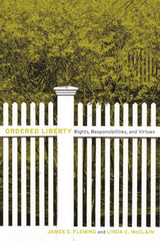 Ordered Liberty: Rights, Responsibilities, and Virtues
James E. Fleming and Linda McClain
Harvard University Press, 2012 Many have argued in recent years that the U.S. constitutional system exalts individual rights over responsibilities, virtues, and the common good. Answering the charges against liberal theories of rights, James Fleming and Linda McClain develop and defend a civic liberalism that takes responsibilities and virtues—as well as rights—seriously. They provide an account of ordered liberty that protects basic liberties stringently, but not absolutely, and permits government to encourage responsibility and inculcate civic virtues without sacrificing personal autonomy to collective determination.
The battle over same-sex marriage is one of many current controversies the authors use to defend their understanding of the relationship among rights, responsibilities, and virtues. Against accusations that same-sex marriage severs the rights of marriage from responsible sexuality, procreation, and parenthood, they argue that same-sex couples seek the same rights, responsibilities, and goods of civil marriage that opposite-sex couples pursue. Securing their right to marry respects individual autonomy while also promoting moral goods and virtues. Other issues to which they apply their idea of civic liberalism include reproductive freedom, the proper roles and regulation of civil society and the family, the education of children, and clashes between First Amendment freedoms (of association and religion) and antidiscrimination law. Articulating common ground between liberalism and its critics, Fleming and McClain develop an account of responsibilities and virtues that appreciates the value of diversity in our morally pluralistic constitutional democracy.
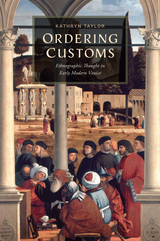 Ordering Customs: Ethnographic Thought in Early Modern Venice
Kathryn Taylor
University of Delaware Press, 2023 Ordering Customs explores how Renaissance Venetians sought to make sense of human difference in a period characterized by increasing global contact and a rapid acceleration of the circulation of information. Venice was at the center of both these developments. The book traces the emergence of a distinctive tradition of ethnographic writing that served as the basis for defining religious and cultural difference in new ways. Taylor draws on a trove of unpublished sources—diplomatic correspondence, court records, diaries, and inventories—to show that the study of customs, rituals, and ways of life not only became central in how Venetians sought to apprehend other peoples, but also had a very real impact at the level of policy, shaping how the Venetian state governed minority populations in the city and its empire. In contrast with the familiar image of ethnography as the product of overseas imperial and missionary encounters, the book points to a more complicated set of origins.
 The Ordering of Time: From the Ancient Computus to the Modern Computer
Arno Borst
University of Chicago Press, 1993 This book is a concise history of the use and interpretation of time, written by one of the foremost medievalists in Europe today.
Arno Borst examines the various ways that time has been calculated by numbers and measured by instruments over several centuries, from the computus—an ancient method of determining times and dates—to the present-day computer. In a wide-ranging discussion, he analyzes the classical Greek concepts of divine, natural, and human time; the universal time of ancient Rome; the Easter cycle of the Middle Ages; the development of the mechanical clock in the fourteenth and fifteenth centuries; early modern chronology; and twentieth-century data processing.
Borst argues that although many centuries and countless different instruments—sundials, horologia, abaci, astrolabes, calendars, and calculating machines—separate the medieval computus from the modern computer, each generation has had to answer the same question: how can we make the best use of our available time to improve our lives? The computer, he suggests, is merely a new instrument employed for an ancient purpose.
Lively and accessible, The Ordering of Time will be welcomed by students and researchers in social and cultural history, the history of science and mathematics, as well as anyone interested in the history of time and numbers.
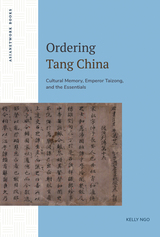 Ordering Tang China: Cultural Memory, Emperor Taizong, and the Essentials
Kelly Ngo
Lever Press, 2024 In Ordering Tang China: Cultural Memory, Emperor Taizong and the Essentials, Kelly Ngo presents the first book-length study in English of the Essentials for Bringing about Order from Assembled Texts (Qunshu zhiyao 群書治要), a rulership anthology that became renowned for its model of governance in ancient and early modern East Asia. The Essentials is one of the earliest Chinese anthologies designed to educate rulers in cultivating an ethical character and governing the state. Commissioned for the Tang emperor Taizong in the 620s, the Essentials articulates a distinctive political philosophy through a collection of excerpts from earlier canonical, historical, and masters writings, and their commentaries. Examining the Essentials and its transmission in China, Japan, Korea, and Vietnam through the lens of cultural memory, Ngo explores the foundation, conduct, and impact of Zhenguan rulership, which became synonymous with good governance among later generations of ruling elites, scholars, and historians in China and beyond.
By connecting the textual discourse with an analysis of its use and reception across the region, Ngo demonstrates that the Essentials was a key source of Confucian political thought and practice during the early Tang dynasty. In accounting for the place of the Essentials in political advice literature, Ngo illustrates how it drew from the ancient Confucian heritage and was still responsive to contemporaneous political concerns, suggesting that the Essentials played a part in the success of Zhenguan political practice.
Ordering Tang China also includes the first English-language translations of portions of the seventh-century anthology, with reference to partial translations published in nine languages. Utilizing the theory of cultural memory to study the Essentials not only opens a fresh approach to learning about the imperial consumption of literature, as well as the theory and practice of emperorship, but also offers a case study for how to study Chinese governance literature, including its “mirror for princes” genre.
 An Orderly Mess
Helga Nowotny
Central European University Press, 2017 This book was triggered by the recent geopolitical shifts and the turn towards an allegedly post-factual era. "An Orderly Mess" gives a timely diagnosis of the current dissolution of the modern order, while highlighting the opportunities of messiness. The essay focuses on the temporal and spatial dimensions in which messiness becomes apparent today: broken time lines and fragmented spaces. Messiness is framed by a blurring of the world orderings inherited from modernity. Against the backdrop of rapid digitalization, we may find ourselves again in a phase of transition toward new ways of world ordering. The focus on messiness reveals the different patterns of order and disorder that underpin the current process of transition. In the second half of the volume the author revisits her 1989 book on Eigenzeit, which explored how moderns experience time, or are exposed to it. A quarter century later she finds that the new inventions of technology have challenged the traditional meaning of time (and also of space) even more, increasing the non-simultaneity of human existence. Today, small devices channel into one’s fingertips medial Eigenzeit: the time that one has to oneself in order to spend it with those who are absent. The past has shrunk and the present extends to the future: “there is no predetermined future, only a future that is as radically open as it is inherently uncertain.”
 The Ordinal Society
Marion Fourcade and Kieran Healy
Harvard University Press, 2024 A sweeping critique of how digital capitalism is reformatting our world.
We now live in an “ordinal society.” Nearly every aspect of our lives is measured, ranked, and processed into discrete, standardized units of digital information. Marion Fourcade and Kieran Healy argue that technologies of information management, fueled by the abundance of personal data and the infrastructure of the internet, transform how we relate to ourselves and to each other through the market, the public sphere, and the state.
The personal data we give in exchange for convenient tools like Gmail and Instagram provides the raw material for predictions about everything from our purchasing power to our character. The Ordinal Society shows how these algorithmic predictions influence people’s life chances and generate new forms of capital and social expectation: nobody wants to ride with an unrated cab driver anymore or rent to a tenant without a risk score. As members of this society embrace ranking and measurement in their daily lives, new forms of social competition and moral judgment arise. Familiar structures of social advantage are recycled into measures of merit that produce insidious kinds of social inequality.
While we obsess over order and difference—and the logic of ordinality digs deeper into our behaviors, bodies, and minds—what will hold us together? Fourcade and Healy warn that, even though algorithms and systems of rationalized calculation have inspired backlash, they are also appealing in ways that make them hard to relinquish.
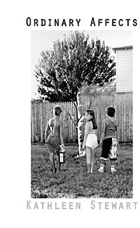 Ordinary Affects
Kathleen Stewart
Duke University Press, 2007 Ordinary Affects is a singular argument for attention to the affective dimensions of everyday life and the potential that animates the ordinary. Known for her focus on the poetics and politics of language and landscape, the anthropologist Kathleen Stewart ponders how ordinary impacts create the subject as a capacity to affect and be affected. In a series of brief vignettes combining storytelling, close ethnographic detail, and critical analysis, Stewart relates the intensities and banalities of common experiences and strange encounters, half-spied scenes and the lingering resonance of passing events. While most of the instances rendered are from Stewart’s own life, she writes in the third person in order to reflect on how intimate experiences of emotion, the body, other people, and time inextricably link us to the outside world. Stewart refrains from positing an overarching system—whether it’s called globalization or neoliberalism or capitalism—to describe the ways that economic, political, and social forces shape individual lives. Instead, she begins with the disparate, fragmented, and seemingly inconsequential experiences of everyday life to bring attention to the ordinary as an integral site of cultural politics. Ordinary affect, she insists, is registered in its particularities, yet it connects people and creates common experiences that shape public feeling. Through this anecdotal history—one that poetically ponders the extremes of the ordinary and portrays the dense network of social and personal connections that constitute a life—Stewart asserts the necessity of attending to the fleeting and changeable aspects of existence in order to recognize the complex personal and social dynamics of the political world.
 Ordinary Enchantments: Magical Realism and the Remystification of Narrative
Wendy B. Faris
Vanderbilt University Press, 2004 Ordinary Enchantments investigates magical realism as the most important trend in contemporary international fiction, defines its characteristics and narrative techniques, and proposes a new theory to explain its significance. In the most comprehensive critical treatment of this literary mode to date, Wendy B. Faris discusses a rich array of examples from magical realist novels around the world, including the work not only of Latin American writers like Gabriel Garcia Marquez, but also of authors like Salman Rushdie, Gunter Grass, Toni Morrison, and Ben Okri. Faris argues that by combining realistic representation with fantastic elements so that the marvelous seems to grow organically out of the ordinary, magical realism destabilizes the dominant form of realism based on empirical definitions of reality, gives it visionary power, and thus constitutes what might be called a "remystification" of narrative in the West. Noting the radical narrative heterogeneity of magical realism, the author compares its cultural role to that of traditional shamanic performance, which joins the worlds of daily life and that of the spirits. Because of that capacity to bridge different worlds, magical realism has served as an effective decolonizing agent, providing the ground for marginal voices, submerged traditions, and emergent literatures to develop and create masterpieces. At the same time, this process is not limited to postcolonial situations but constitutes a global trend that replenishes realism from within.
In addition to describing what many consider to be the progressive cultural work of magical realism, Faris also confronts the recent accusation that magical realism and its study as a global phenomenon can be seen as a form of commodification and an imposition of cultural homogeneity. And finally, drawing on the narrative innovations and cultural scenarios that magical realism enacts, she extends those principles toward issues of gender and the possibility of a female element within magical realism.
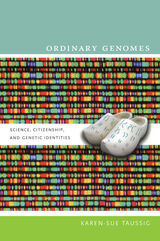 Ordinary Genomes: Science, Citizenship, and Genetic Identities
Karen-Sue Taussig
Duke University Press, 2009 Ordinary Genomes is an ethnography of genomics, a global scientific enterprise, as it is understood and practiced in the Netherlands. Karen-Sue Taussig’s analysis of the Dutch case illustrates how scientific knowledge and culture are entwined: Genetics may transform society, but society also transforms genetics. Taussig traces the experiences of Dutch people as they encounter genetics in research labs, clinics, the media, and everyday life. Through vivid descriptions of specific diagnostic processes, she illuminates the open and evolving nature of genetic categories, the ways that abnormal genetic diagnoses are normalized, and the ways that race, ethnicity, gender, and religion inform diagnoses. Taussig contends that in the Netherlands ideas about genetics are shaped by the desire for ordinariness and the commitment to tolerance, two highly-valued yet sometimes contradictory Dutch social ideals, as well as by Dutch history and concerns about immigration and European unification. She argues that the Dutch enable a social ideal of tolerance by demarcating and containing difference so as to minimize its social threat. It is within this particular construction of tolerance that the Dutch manage the meaning of genetic difference.
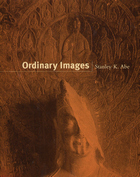 Ordinary Images
Stanley K. Abe
University of Chicago Press, 2002 This richly illustrated book explores the large body of sculpture, paintings, and other religious imagery produced for China's common classes from the third to the sixth centuries C.E. In contrast to the works made for imperial patrons, illustrious monastics, or other luminaries, these ordinary images-modest in scale, mass produced, and at times incomplete-were created for those of lesser standing. Because they cannot be related to well-known historical figures or social groups, these images have been considered a largely nebulous, undistinguished mass of works.
Situating his study in the gaps between conventional categories such as Buddhism, Daoism, and Chinese popular art, Abe examines works—including some of the earliest known examples of Buddha-like images in China—that were commissioned by patrons of modest standing and produced by nameless artists and artisans. Sophisticated and lucidly written, Ordinary Images offers an unprecedented exploration of the lively and diverse nature of image making and popular practices.
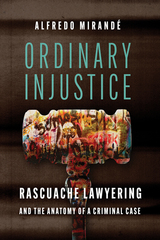 Ordinary Injustice: Rascuache Lawyering and the Anatomy of a Criminal Case
Alfredo Mirandé
University of Arizona Press, 2023 Ordinary Injustice is the unique and riveting story of a young Latino student, Juan Rulfo, with no previous criminal record involved in a domestic violence dispute that quickly morphs into a complex case with ten felonies, multiple enhancements, a “No Bail” order, and a potential life sentence without the possibility of parole.
Building from author Alfredo Mirandé’s earlier work Rascuache Lawyer, the account is told by “The Professor,” who led a pro bono rascuache legal defense team comprising the professor, a retired prosecutor, and student interns, working without a budget, office, paralegals, investigators, or support staff. The book is a must-read for anyone interested in race, gender, and criminal injustice and will appeal not only to law scholars and social scientists but to lay readers interested in ethnographic field research, Latinx communities, and racial disparities in the legal system.
The case is presented as a series of letters to the author’s fictional alter-ego, Fermina Gabriel, an accomplished lawyer and singer. This narrative device allows the author to present the case as it happens, relaying the challenges and complexities as they occur and drawing the reader in.
While Ordinary Injustice deals with important, complicated legal issues and questions that arise in criminal defense work and looks at the case from the time of Juan’s arrest to the preliminary hearing, indictment, pretrial motions, and attempts to obtain a negotiated plea, it is written in nontechnical and engaging language that makes law accessible to the lay reader.
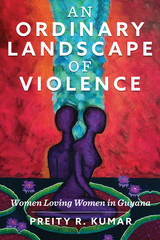 An Ordinary Landscape of Violence: Women Loving Women in Guyana
Preity R. Kumar
Rutgers University Press, 2024 An Ordinary Landscape of Violence: Women Loving Women in Guyana tells a new history of queer women in postcolonial Guyana. While the country has experienced a rise in queer activism, especially toward human rights efforts, members of the Guyanese queer community have also been victims of extreme violence. This book asks how a hetero-patriarchal state shapes queer and "women-lovin’ women’s" experiences, and how such women navigate racialized, sexualized, and homophobic violence. With a unique focus on the lives of queer women in Guyana, it reveals their manifold experiences of violence, explores regional differences, and shows their complicated understanding of what exactly constitutes “rights” and the limitations of those rights in their lives. While activism against violence is crucial, this book addresses not only the violence against women, but theorizes the intimate partner violence between women, and demonstrates the ways that violence is both racialized and sexualized.
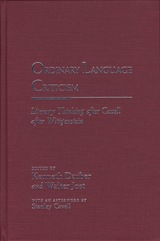 Ordinary Language Criticism: Literary Thinking after Cavell after Wittgenstein
Kenneth Dauber and Walter Jost
Northwestern University Press, 2003 Marking a return of literary study from the remote reaches of abstraction to the realm of the immediate, the particular, and the real in which language and literature truly live, the essays in this volume articulate a productive, new critical approach: ordinary language criticism. With roots in the ordinary language philosophy derived especially from Wittgenstein in the early twentieth century, and in the ideas of American pragmatic philosophy propounded and extended by Stanley Cavell, this approach seeks to return criticism to its grounds in the natural language we all speak; to expose the terms of our engagement with narratives, arguments, and concepts-what Wittgenstein and Cavell call the "criteria" of our writing and reading.
Resisting master formulations and overarching theories, Ordinary Language Criticism does not so much dismiss the excitement of the last two decades of literary theorizing as it reminds us of the excitement of the shared common enterprises to which theory may still contribute. In this, the volume and the model it offers have wide implications for the academy, in which a widespread ersatz-sophistication has shorted the circuit between literary works and the real lives of those reading and teaching them.
With a definitive introduction by editors Kenneth Dauber and Walter Jost, and elaborations and practical examples by major figures such as Cavell himself, Martha Nussbaum, Marjorie Perloff, Anthony Cascardi, and Charles Altieri, among others, this volume clearly shows and explains how ordinary language criticism differs from current trends and what it exactly it can accomplish in theory and practice. These essays prove that by attending more faithfully to what we actually do when we read, we can make reading more productive--can reveal how extraordinary and rich, how really sophisticated, the ordinary actually is.
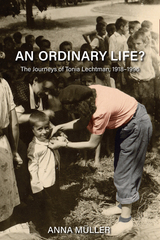 An Ordinary Life?: The Journeys of Tonia Lechtman, 1918–1996
Anna Müller
Ohio University Press, 2024 One woman’s national, political, ethnic, social, and personal identities impart an extraordinary perspective on the histories of Europe, Polish Jews, Communism, activism, and survival during the twentieth century. Tonia Lechtman was a Jew, a loving mother and wife, a Polish patriot, a committed Communist, and a Holocaust survivor. Throughout her life these identities brought her to multiple countries—Poland, Palestine, Spain, France, Germany, Switzerland, and Israel—during some of the most pivotal and cataclysmic decades of the twentieth century. In most of those places, she lived on the margins of society while working to promote Communism and trying to create a safe space for her small children. Born in Łódź in 1918, Lechtman became fascinated with Communism in her early youth. In 1935, to avoid the consequences of her political activism during an increasingly antisemitic and hostile political environment, the family moved to Palestine, where Tonia met her future husband, Sioma. In 1937, the couple traveled to Spain to participate in the Spanish Civil War. After discovering she was pregnant, Lechtman relocated to France while Sioma joined the International Brigades. She spent the Second World War in Europe, traveling with two small children between France, Germany, and Switzerland, at times only miraculously avoiding arrest and being transported east to Nazi camps. After the war, she returned to Poland, where she planned to (re)build Communist Poland. However, soon after her arrival she was imprisoned for six years. In 1971, under pressure from her children, Lechtman emigrated from Poland to Israel, where she died in 1996. In writing Lechtman’s biography, Anna Müller has consulted a rich collection of primary source material, including archival documentation, private documents and photographs, interviews from different periods of Lechtman’s life, and personal correspondence. Despite this intimacy, Müller also acknowledges key historiographical questions arising from the lacunae of lost materials, the selective preservation of others, and her own interpretive work translating a life into a life story.
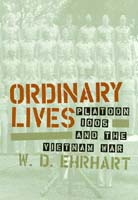 Ordinary Lives: Platoon 1005 and the Vietnam War
W. Ehrhart
Temple University Press, 1999 In the summer of 1966, in the middle of the Vietnam War, eighty young volunteers arrived at the Marine Corps Recruit Depot on Parris Island, South Carolina, from all over the Eastern United States. For the next eight weeks, as Platoon 1005, they endured one of the most intense basic training programs ever devised. Parris Island was not a place for idle conversation or social gatherings, and these men remained from start to finish almost complete strangers. Ehrhart did get to know one Marine, his bunkmate John Harris, who quietly shared his sweetheart's letters. He was a friend who died in Vietnam only a year later.
Twenty-seven years after basic training. Ehrhart began what became a five-year search for the men of his platoon. Who were these men alongside whom he trained? Why had they joined the Marines at a time when being sent to war and of the country that sent them to fight it? What does the Corps mean to them? What Ehrhart learned offers an extraordinary window into the complexities of the Vietnam Generation and the United States of America then and now.
Based on supporting materials from military records and family members as well as interviews -- some of which Ehrhart held in such active secondary roles as dairy farmhand, fishing companion, and impromptu guest at a family wedding -- this book records the more-than-30-year journey that each man took after his boot-camp graduation on August 12, 1966. Photos of the men, both then and now, accompany the profiles. Their stories are diverse, but as Ehrhart says, "It was, in short, history, and each of these men was and is a part of that history....There are, no doubt, scoundrels and liars and losers among these men, but as a group they have mostly impressed me with their decency and their loyalty and their hard work and their perseverance in the face of hardships and hurdles, the everyday obstacles that make ordinary lives extraordinary."
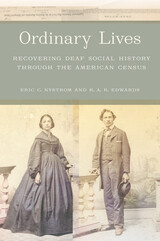 Ordinary Lives: Recovering Deaf Social History through the American Census
Eric C. Nystrom and R. A. R. Edwards
University of Massachusetts Press, 2024 The collective social history of deaf people in America has yet to be written. While scholars have focused their attention on residential schools for the deaf, leaders in the deaf community, and prominent graduates of these institutions, the lives of “ordinary” deaf individuals have been largely overlooked. Employing the methods of social history, such as the use of digital history techniques and often-ignored sources like census records, Eric C. Nystrom and R. A. R. Edwards recover the lived experiences of everyday deaf people in late nineteenth century America. Ordinary Lives captures the stories of deaf women and men, both Black and white, describing their family lives, networks of support, educational experiences, and successes and hardships. In this pioneering “deaf social history,” Edwards and Nystrom reconstruct the biographies of a wider range of deaf individuals to tell a richer, more nuanced, and more inclusive history of the larger American deaf community.
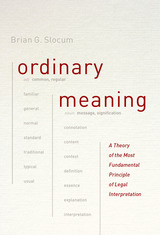 Ordinary Meaning: A Theory of the Most Fundamental Principle of Legal Interpretation
Brian G. Slocum
University of Chicago Press, 2015 Consider this court case: a defendant has traded a gun for drugs, and there is a criminal sentencing provision that stipulates an enhanced punishment if the defendant “uses” a firearm “during and in relation to a drug trafficking crime.” Buying the drugs was obviously a crime—but can it be said that the defendant actually “used” the gun during the crime? This sort of question is at the heart of legal interpretation.
Legal interpretation is built around one key question: by what standard should legal texts be interpreted? The traditional doctrine is that words should be given their “ordinary meaning”: words in legal texts should be interpreted in light of accepted standards of communication. Yet often, courts fail to properly consider context, refer to unsuitable dictionary definitions, or otherwise misconceive how the ordinary meaning of words should be determined. In this book, Brian Slocum builds his argument for a new method of interpretation by asking glaring, yet largely ignored, questions. What makes one particular meaning the “ordinary” one, and how exactly do courts conceptualize the elements of ordinary meaning? Ordinary Meaning provides a much-needed, revised framework, boldly instructing those involved with the law in how the components of ordinary meaning should properly be identified and developed in our modern legal system.
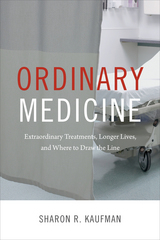 Ordinary Medicine: Extraordinary Treatments, Longer Lives, and Where to Draw the Line
Sharon R. Kaufman
Duke University Press, 2015 Most of us want and expect medicine’s miracles to extend our lives. In today’s aging society, however, the line between life-giving therapies and too much treatment is hard to see—it’s being obscured by a perfect storm created by the pharmaceutical and biomedical industries, along with insurance companies. In Ordinary Medicine Sharon R. Kaufman investigates what drives that storm’s “more is better” approach to medicine: a nearly invisible chain of social, economic, and bureaucratic forces that has made once-extraordinary treatments seem ordinary, necessary, and desirable. Since 2002 Kaufman has listened to hundreds of older patients, their physicians and family members express their hopes, fears, and reasoning as they faced the line between enough and too much intervention. Their stories anchor Ordinary Medicine. Today’s medicine, Kaufman contends, shapes nearly every American’s experience of growing older, and ultimately medicine is undermining its own ability to function as a social good. Kaufman’s careful mapping of the sources of our health care dilemmas should make it far easier to rethink and renew medicine’s goals.
Ordinary Misfortunes
Emily Yoon
Tupelo Press, 2017 Korea continues to grapple with the shared memory of its Japanese and US occupations. The poems in Ordinary Misfortunes incorporate actual testimony about cruelty against vulnerable bodies—including the wianbu, euphemistically known as “comfort women”—as the poet seeks to find places where brutality is overcome through true human connections. Emily Jungmin Yoon asks Why do we write poems amid such violence? What can I, and what can poetry, do? Her response to those tough questions is a sequence of reverberating poems that blend documentary precision with impassioned witness, bringing to bear both scholarship and artistry.
Ordinary Poverty: A Little Food and Cold Storage
William DiFazio
Temple University Press, 2005 At St. John's Bread and Life, a soup kitchen in the Bedford-Stuyvesant section of Brooklyn, more than a thousand people line up for breakfast and lunch five days a week. During the twelve-year era of welfare reform, William DiFazio observed the daily lives of poor people at St. John's and throughout New York City.
In this trenchant and groundbreaking work, DiFazio presents the results of welfare reform—from ending entitlements to diminished welfare benefits—through the eyes and voices of those who were most directly affected by it. Ordinary Poverty concludes with a program to guarantee universal rights to a living wage as a crucial way to end poverty. Ultimately, DiFazio articulates the form a true poor people's movement would take—one that would link the interests of all social movements with the interests of ending poverty.
 Ordinary Queerness in American Modernism
Jess Shollenberger
Ohio State University Press, 2025 Can queer life be ordinary? By answering “yes,” Ordinary Queerness in American Modernism prompts queer studies to consider what it has long devalued and neglected: the ordinary lives queer people create. Declining to cede the ordinary to queer studies’ critique of the normal, Jess Shollenberger argues for and models a reading practice that is attuned to queer desires, figures, and intimacies arrayed against the normal yet enabled by ordinary life. By tracing the representation of queerness in modernist literature as presence, possibility, and insistence, Shollenberger illuminates how the modernist interest in ordinary life cannot be understood apart from queer experience, culture, and aesthetics. Ordinary Queerness in American Modernism disturbs queer studies by turning toward the ordinary as an object for queer inquiry and by reading perversely without the dominant hermeneutic for queer literary studies—the closet. Across interpretations of work by Sarah Orne Jewett, Gertrude Stein, Gwendolyn Brooks, and Elizabeth Bishop, Shollenberger develops the practice of reading modernist writing without the closet, expanding the scope of modernist studies and augmenting our knowledge of queerness for a shifting, unstable present.
Ordinary Reactions to Extraordinary Events
Edited by Ray B. Browne and Arthur B. Neal
University of Wisconsin Press, 2001 The essays in this collection present communities beset by unexpected social and physical events. Some outline immediate responses that soon pass and some that will not go away. Who would have foreseen that Elvis would be a phenomenon apparently as lasting as the faces on Mount Rushmore? Cultural history will not allow us to forget the H. G. Wells account of the Martian attack, nor can we ever forget the continued terror of the Chernobyl explosion. Ordinary Reactions to Extraordinary Events catalogues on the Geiger counter of human emotions societal reactions to events both earthshaking and culture-disturbing.
Ordinary Trauma: A Memoir
Jennifer Sinor
University of Utah Press, 2017 As if she could not bear to leave it, Jennifer Sinor came into this spinning world twice, once dead and once alive, the first time born from her mother, the second, from a bucket, its silvery metal sides a poor substitute for the womb, yet enough. Through spare yet lyrical prose, Sinor threads together the story of how she learned to carry the bucket she was born into and reclaim all that was tossed away. In short, almost telegraphic, linked pieces, Ordinary Trauma reveals moments in life that are made to appear unremarkable but harm deeply. Set against the late Cold War and a military childhood spent amid fast-attack submarines and long-range nuclear missiles, this memoir delivers a revelatory look at how moments that typically pass unnoticed form the very basis for our perceptions of both love and loss. Finalist for the 15 Bytes Book Award for Creative Nonfiction Interview with Tom Williams at Access Utah
Ordinary Vices
Judith N. Shklar
Harvard University Press, 1984 The seven deadly sins of Christianity represent the abysses of character, whereas Judith Shklar’s “ordinary vices”—cruelty, hypocrisy, snobbery, betrayal, and misanthropy—are merely treacherous shoals, flawing our characters with mean-spiritedness and inhumanity.
Shklar draws from a brilliant array of writers—Molière and Dickens on hypocrisy, Jane Austen on snobbery, Shakespeare and Montesquieu on misanthropy, Hawthorne and Nietzsche on cruelty, Conrad and Faulkner on betrayal—to reveal the nature and effects of the vices. She examines their destructive effects, the ambiguities of the moral problems they pose to the liberal ethos, and their implications for government and citizens: liberalism is a difficult and challenging doctrine that demands a tolerance of contradiction, complexity, and the risks of freedom.
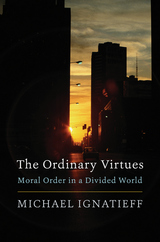 The Ordinary Virtues: Moral Order in a Divided World
Michael Ignatieff
Harvard University Press, 2017 Winner of the Zócalo Book Prize
A New York Times Book Review Editors’ Choice
“Combines powerful moral arguments with superb storytelling.”
—New Statesman
What moral values do we hold in common? As globalization draws us together economically, are the things we value converging or diverging? These twin questions led Michael Ignatieff to embark on a three-year, eight-nation journey in search of an answer. What we share, he found, are what he calls “ordinary virtues”: tolerance, forgiveness, trust, and resilience. When conflicts break out, these virtues are easily exploited by the politics of fear and exclusion, reserved for one’s own group but denied to others. Yet these ordinary virtues are the key to healing and reconciliation on both a local and global scale.
“Makes for illuminating reading.”
—Simon Winchester, New York Review of Books
“Engaging, articulate and richly descriptive… Ignatieff’s deft histories, vivid sketches and fascinating interviews are the soul of this important book.”
—Times Literary Supplement
“Deserves praise for wrestling with the devolution of our moral worlds over recent decades.”
—Los Angeles Review of Books
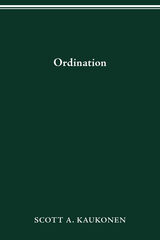 ORDINATION
SCOTT A KAUKONEN
Ohio State University Press, 2005 “If my mother were to tell the story . . .” So begins the title piece in this debut collection of short fiction, eight stories that explore the gap between the stories we tell ourselves and the stories we have lived. In “Punitive Damages,” a father, the beneficiary of a huge financial settlement in compensation for his son’s death, must confront the truth of the life that the son’s death has provided. In “Punnett’s Squares,” winner of the Chicago Tribune’s Nelson Algren Award, an adopted son seeks to prove, against all evidence to the contrary, that his adoptive father is in fact his biological father. In “Induction Ceremony,” a small-town basketball hero returns to his hometown no longer a man but now a woman, and his onetime teammate-and-friend must reconsider who they were and who they are now. In the pair of pieces that bookend the collection, “Ordination” and “Be a Missionary,” a Baptist preacher’s son must reconcile the distance between the evidence of things seen and the evidence of things unseen. These are men and boys who like to see themselves as worthy of the titles of father, son, husband, lover, and friend, but who must fight their own instincts and desires to claim such honors. These are boys and men for whom questions of identity—biological, cultural, sexual, religious, moral—are unavoidable, men and boys always seeking to be who they want to be, always aware of who they are.
Ore Choir: The Lava on Iceland
Katy Didden
Tupelo Press, 2022 Part miracle, part oracle, in these poems lava speaks “with the focus of a burning glass,” lighting lyric core samples through geo-historical and cultural texts about Iceland. Shifting the ground so “nouns are never still,” the lava reveals how language itself is a record of collisions: poem as matter, sound as forge, form as friction. And what does it mean to be human in the face of such ancient forces, especially as climate change unsettles the earth that anchors us? By the light of the “sphere’s credo,” can we, too, be remade?
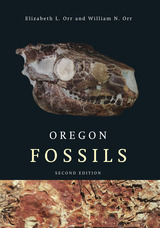 Oregon Fossils, Second Edition
Elizabeth L. Orr
Oregon State University Press, 2009 This revised and expanded edition of Oregon Fossils includes a record of all known fossils in Oregon going back 400 million years, along with collecting localities by county, age, rock formation, and published source. The book also provides a geologic overview of the state, from ocean beaches to the high desert, from the Blue Mountains to the Siskiyous.
Unique among fossil field guides, Oregon Fossils includes both specimen identification and interesting notes about their discovery, naming, and conservation. The narrative is sprinkled with biographical sketches of paleontologists who have contributed to the state’s fossil record, and the text is richly illustrated with photographs, line drawings, charts, and maps. A complete bibliography lists full citations to fossil material. The only single volume that provides Oregon’s fossil record and history, Oregon Fossils is a well-written, well-organized guide. It is an excellent reference for classroom and library use, for researchers, and for private collectors and hobbyists.
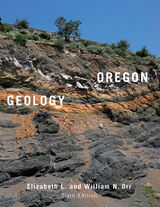 Oregon Geology
Elizabeth L. Orr and William N. Orr
Oregon State University Press, 2012 Because Oregon sits on the leading edge of a moving crustal plate, a striking diversity of geologic events have molded its topography. Over a century of study, a deeper understanding of the region’s tectonic overprint has emerged. In this timely update to the 2000 edition, Elizabeth and William Orr incorporate that new knowledge, addressing current environmental problems and detailing tectonic hazards. “Caught between converging crustal plates,” the Orrs write, “the Pacific Northwest faces a future of massive earthquakes and tsunamis.”
A comprehensive treatment of the state’s geologic history, Oregon Geology moves through Oregon’s regions to closely examine the unique geologic features of each, from the Blue Mountains to the Willamette Valley, from the high lava Plains to the Coast Range.
The book includes biographical sketches of notable geologists. It is lavishly illustrated and includes an extensive bibliography.
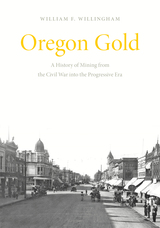 Oregon Gold: A History of Mining from the Civil War into the Progressive Era
William F. Willingham
Oregon State University Press, 2025 Following the discovery of gold in 1862 at Auburn and Canyon City, new communities and prospects were established in eastern Oregon. Just as the lure of free land attracted homesteaders and livestock raisers in search of new opportunities, so did the possibility of finding wealth in gold and silver throughout the region. Based on exhaustive research and a wealth of sources—federal census and mining records, newspapers, mining periodicals, county land records, maps, and federal government reports—Oregon Gold offers a comprehensive study of mining in Oregon between 1862 and 1910. From carefully examining the eastern portion of the state to exploring the economic expansion and political development of Portland, William Willingham highlights what is unique about the Oregon gold mining experience and places Oregon’s precious metal mining in the context of mining throughout the American West. Willingham shows how mining was an important aspect of the state’s history, far greater than has been traditionally understood. He provides special attention and analysis to the role Chinese miners played in the story of eastern Oregon mining and to the demographic makeups of two major mining communities, Susanville and Granite, that thrived during the period. The attention to detail and thorough reporting in Oregon Gold will captivate both scholars and general readers interested in western mining and Oregon history during the nineteenth century.
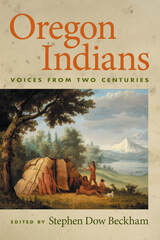 Oregon Indians: Voices from Two Centuries
Stephen Dow Beckham
Oregon State University Press, 2006 In this deeply researched volume, Stephen Dow Beckham brings together commentary by Native Americans about the events affecting their lives in Oregon. Now available in paperback for the first time, this volume presents first-person accounts of events threatening, changing, and shaping the lives of Oregon Indians, from “first encounters” in the late eighteenth century to modern tribal economies. The book's seven thematic sections are arranged chronologically and prefaced with introductory essays that provide the context of Indian relations with Euro-Americans and tightening federal policy. Each of the nearly seventy documents has a brief introduction that identifies the event and the speakers involved. Most of the book's selections are little known. Few have been previously published, including treaty council minutes, court and congressional testimonies, letters, and passages from travelers’ journals. Oregon Indians opens with the arrival of Euro-Americans and their introduction of new technology, weapons, and diseases. The role of treaties, machinations of the Oregon volunteers, efforts of the US Army to protect the Indians but also subdue and confine them, and the emergence of reservation programs to “civilize” them are recorded in a variety of documents that illuminate nineteenth-century Indian experiences. Twentieth-century documents include Tommy Thompson on the flooding of the Celilo Falls fishing grounds in 1942, as well as Indian voices challenging the "disastrous policy of termination," the state's prohibition on inter-racial marriage, and the final resting ground of Kennewick Man. Selections in the book's final section speak to the changing political atmosphere of the late twentieth century, and suggest that hope, rather than despair, became a possibility for Oregon tribes.
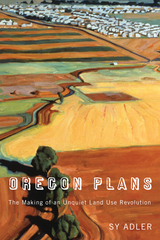 Oregon Plans: The Making of an Unquiet Land Use Revolution
Sy Adler
Oregon State University Press, 2012 Oregon Plans provides a rich, detailed, and nuanced analysis of the origins and early evolution of Oregon’s nationally renowned land use planning program. Drawing primarily on archival sources, Sy Adler describes the passage of key state laws that set the program into motion by establishing the agency charged with implementing those laws, adopting the land-use planning goals that are the heart of the Oregon system, and monitoring and enforcing the implementation of those goals through a unique citizen organization. Oregon Plans documents the consequential choices and compromises that were made in the 1970s to control growth and preserve Oregon's quality of life. Environmental activists, farmers, industry groups, local governments, and state officials all played significant roles. Adler brings these actors—among them governors Tom McCall and Robert Straub, business leaders John Gray and Glenn Jackson, 1000 Friends of Oregon, and the Oregon Home Builders Association—to life. "Adler's story is about unusual conditions, purposeful action, dynamic personalities, and the messiness of democratic and bureaucratic processes. His conclusions reveal much about how Oregonians defined liveability in the late twentieth century." —William L. Lang, from the Preface A volume in the Culture and Environment in the West series. Series editor: William L. Lang
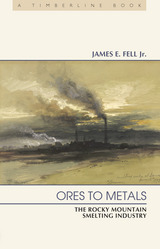 Ores to Metals: The Rocky Mountain Smelting Industry
James E. Fell
University Press of Colorado, 2009 This comprehensive treatment of the smelting industry of Colorado, originally published in 1979, is now back in print with a new preface by the author. Packed with fascinating statistics and mining data, Ores to Metals details the people, technologies, and business decisions that have shaped the smelting industry in the Rockies. Although mining holds more of the glamour for those in and interested in the minerals industry, smelters have continuously played a critical role in the industry’s evolution since their introduction in Colorado in the 1860s. At that time, miners desperately needed new technology to recover gold and silver from ores resistant to milling. Beginning as small independent enterprises, progressing to larger integrated firms working in urban centers, and finally following a trend toward mergers, the entire industry was absorbed into one large holding company—the American Smelting and Refining Company. Over time, fortunes were won and lost, business success was converted to political success, and advances were made in science and metallurgy. Drawing on archival material, Fell expertly presents the triumphs and troubles of the entrepreneurs who built one of the great industries of the West.
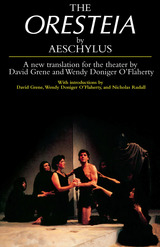 The Oresteia
Aeschylus
University of Chicago Press, 1989 Highly acclaimed as translators of Greek and Sanskrit classics, respectively, David Grene and Wendy Doniger O'Flaherty here present a complete modern translation of the three plays comprising Aeschylus' Oresteia and, with the assistance of director Nicholas Rudall, an abridged stage adaptation. This balanced and highly successful collaboration of scholars with a theater director solves the contemporary problems of translating and staging the Oresteia, which originally was written to be performed in Athens in the first half of the fifth century B.C. While remaining faithful to the original Greek, Grene and O'Flaherty embrace a strong and adventurous English style, vivid and visceral. The language of this extraordinary translation, immediately accessible to a theater audience, speaks across the centuries. Premiered at Chicago's Court Theater in 1986 under Rudall's direction, the stage adaptation of the Oresteia proved eminently playable. This new adaptation of the Oresteia offers a brilliant demonstration of how clearly defined goals (here, the actor's needs) can inspire translators to produce fresh, genuine, accessible dramatic texts. The resulting work provides complete and accurate texts for those who cannot read the original Greek, and it transforms the Oresteia into an effective modern stage play. With interpretive introductions written by the translators and director, this new version will be welcomed by teachers of translation courses, by students of Greek and world drama in general, and by theater professionals.
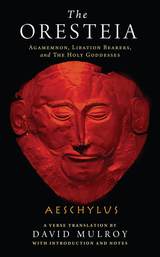 The Oresteia: Agamemnon, Libation Bearers, and The Holy Goddesses
Aeschylus, A verse translation by David Mulroy, with introduction and notes
University of Wisconsin Press, 2018 First presented in the spring of 458 B.C.E. at the festival of Dionysus in Athens, Aeschylus' trilogy Oresteia won the first prize. Comprised of three plays—Agamemnon, Libation Bearers, and The Furies—it is the only surviving example of the ancient trilogy form for Greek tragedies.
This drama of the House of Atreus catches everyone in a bloody net. Queen Clytaemestra of Argos murders her husband Agamemnon. Their son Orestes avenges his father by killing his mother. The Furies, hideous deities who punish the murder of blood kin, pursue Orestes. Into this horrific cycle steps Athena, goddess of wisdom, who establishes the rule of law to replace fatal vengeance. Orestes is tried in court before a jury of Athenians and found not guilty. Athena transforms the Furies into benevolent goddesses and extols the virtue of mercy.
An important historical document as well as gripping entertainment, the Oresteia conveys beliefs and values of the ancient Athenians as they established the world's first great democracy. Aeschylus (525/4–456/5 B.C.E.) was the first of the three great tragic dramatists of ancient Greece, forerunner of Sophocles and Euripides. In this trilogy he created a new dramatic form with characters and plot, infused with spellbinding emotion. David Mulroy's fluid, accessible English translation with its rhyming choral songs does full justice to the meaning and theatricality of the ancient Greek. In an introduction and appendixes, he provides cultural background for modern readers, actors, and students.
 Oresteia: Agamemnon. Libation-Bearers. Eumenides
Aeschylus
Harvard University Press, 2008 The tragic cycle of justice.
Aeschylus (ca. 525–456 BC), the dramatist who made Athenian tragedy one of the world’s great art forms, witnessed the establishment of democracy at Athens, fought against the Persians at Marathon and probably also at Salamis, and had one of his productions sponsored by the young Pericles. He was twice invited to visit Sicily, and it was there that he died. At Athens he competed for the tragic prize at the City Dionysia about nineteen times between circa 499 and 458, and won it on thirteen occasions; in his later years he was probably victorious almost every time he put on a production, though Sophocles beat him at least once.
Of his total of about eighty plays, seven survive complete. The first volume of this new Loeb Classical Library edition contains fresh texts and translations by Alan H. Sommerstein of Persians (472), on the recent war, the only surviving Greek historical drama; Seven against Thebes (467), the third play of a trilogy, on the conflict between Oedipus’ sons which ends when they kill each other; Suppliants, the first or second play of a trilogy, on the successful appeal by the daughters of Danaus to the king and people of Argos for protection against a forced marriage to their cousins (whom they will later murder, all but one); and Prometheus Bound (of disputed authenticity), on the terrible punishment of Prometheus for giving fire to humans in defiance of Zeus (with whom he will later be reconciled after preventing his overthrow). The second volume contains the complete Oresteia trilogy (458), comprising Agamemnon, Libation-Bearers, and Eumenides, presenting the murder of Agamemnon by his wife, the revenge taken by their son Orestes, the pursuit of Orestes by his mother’s avenging Furies, his trial and acquittal at Athens, Athena’s pacification of the Furies, and the blessings they both invoke upon the Athenian people.
This edition’s third volume offers all the major fragments of lost Aeschylean plays, with brief headnotes explaining what is known, or can be plausibly inferred, about their content, and bibliographies of recent studies.
The Organ in Manitoba: A History of the Instruments, the Builders, and the Players
James B. Hartman
University of Manitoba Press, 1997 Pipe organs were once a central (and sometimes hotly debated) part of Manitoba's cultural life. The Organ in Manitoba portrays that history--the instruments, builders, players and critics--from the date of the earliest known installations to the 1990s, and includes information on musical organizations such as the Royal Canadian College of Organists. It documents over a century of evolution and changes, from concepts of tonal design to styles of musical commentary and tastes, and includes an inventory of installations and specifications for over 100 organs. Well-illustrated with photographs and excerpts from historical reviews and other documents, it will be of interest to musicians, teachers, and music, church, and cultural historians.
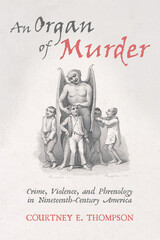 An Organ of Murder: Crime, Violence, and Phrenology in Nineteenth-Century America
Courtney E. Thompson
Rutgers University Press, 2021 Finalist for the 2022 Cheiron Book Prize
An Organ of Murder explores the origins of both popular and elite theories of criminality in the nineteenth-century United States, focusing in particular on the influence of phrenology. In the United States, phrenology shaped the production of medico-legal knowledge around crime, the treatment of the criminal within prisons and in public discourse, and sociocultural expectations about the causes of crime. The criminal was phrenology’s ideal research and demonstration subject, and the courtroom and the prison were essential spaces for the staging of scientific expertise. In particular, phrenology constructed ways of looking as well as a language for identifying, understanding, and analyzing criminals and their actions. This work traces the long-lasting influence of phrenological visual culture and language in American culture, law, and medicine, as well as the practical uses of phrenology in courts, prisons, and daily life.
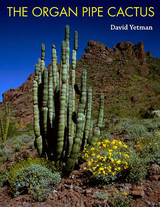 The Organ Pipe Cactus
David Yetman
University of Arizona Press, 2006 Distinguished by its slender vertical branches, which resemble the tubes of a pipe organ, and growing to the imposing height of 15 to more than 30 feet, it’s obvious how the organ pipe cactus got its name. In the United States, these spectacular and intriguing plants are found exclusively in a small area of the Sonoran Desert in the southwestern corner of Arizona. With a landscape marked by sharp, rocky slopes and daytime highs in the summer reaching 110 degrees Fahrenheit, the region is inhospitable for most ordinary life, whether plant or animal. But the organ pipe cactus is far from ordinary. Although it is the most common columnar cactus, it is so unusual in the United States that it is only one of three cacti to have a national preserve established to protect it. In this regard, it joins a select group of plants—including Joshua trees, redwoods, and sequoias—upon which that honor has been conferred. In this beautifully illustrated, large-format book, David Yetman provides an in-depth and comprehensive look at these intriguing and picturesque plants that most Americans will never have the opportunity to see. Chapters explore their ethnobotanical uses, their habitat, their distribution, and special conditions required for their germination, establishment, growth, and survival. Yetman also places the organ pipe in perspective as a member of a genus with at least twenty-three species, ranging from the prostrate Stenocereus eruca of Baja California to the 50-foot high giant S. chacalapensis of the coast of Oaxaca.
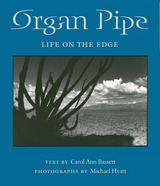 Organ Pipe: Life on the Edge
Text by Carol Ann Bassett; Photographs by Michael Hyatt
University of Arizona Press, 2004 Deep in the heart of the Sonoran Desert lies an oasis of ebony mountains, golden poppies, stately saguaros—and the organ pipe cactus, "a prickly octopus turned on its head."
A terrain where one learns to pay attention to the details: the tracks of a sidewinder in the sand, the tiny eggs of a cactus wren, the flash of a vermilion flycatcher against the azure sky.
Organ Pipe Cactus National Monument lies in southwestern Arizona on the Mexican border. It is an isolated park that for Carol Ann Bassett has long been a place of solitude—a silent refuge where she often camped out alone to capture the natural rhythms of the desert. Photographer Michael Hyatt hiked through Organ Pipe to visually document its subtle beauty in the Ajo Mountains and the valley of the Ajo, and at Quitobaquito, a rare desert oasis.
Few visitors may brave Organ Pipe during summer, when the temperature can reach 120 degrees, but for Bassett and Hyatt the searing heat is but a harbinger of rain, when normally dry arroyos surge with rust-colored water and desert tarantulas come out to mate. Bassett introduces readers to Organ Pipe’s cultural heritage as well: Spanish missionaries, Anglo settlers, and the Tohono O’odham and the Hia Ced O’odham people who still travel there to gather cactus fruit during Hasan Bakmasad, "saguaro moon." She also considers the changes taking place throughout the park, including the onrush of immigrants passing through in search of better lives in the United States.
This small, lyrical book is a sensitive reflection on the heart of the Sonoran Desert. It reminds us of the beauty to be found in unexpected places—and of our intimate connection with the wild.
 The Organ Shortage Crisis in America: Incentives, Civic Duty, and Closing the Gap
Andrew Michael Flescher
Georgetown University Press Nearly 120,000 people are in need of healthy organs in the United States. Every ten minutes a new name is added to the list, while on average twenty people die each day waiting for an organ to become available. Worse, our traditional reliance on cadaveric organ donation is becoming increasingly insufficient, and in recent years there has been a decline in the number of living donors as well as in the percentage of living donors relative to overall kidney donors. Some transplant surgeons and policy advocates have responded to this shortage by arguing for the legalization of the sale of organs among living donors. Andrew Flescher objects to this approach by going beyond concerns traditionally cited about social justice, commodification, and patient safety, and moving squarely onto the terrain of discussing what motivates major and costly acts of human selflessness. What is the most efficacious means of attracting prospective living kidney donors? Flescher, drawing on literature in the fields of moral psychology and economics, as well as on scores of interviews with living donors, suggests that inculcating a sense of altruism and civic duty is a more effective means of increasing donor participation than the resort to financial incentives. He encourages individuals to spend time with patients on dialysis in order to become acquainted with their plight and, as an alternative to lump-sum payments, consider innovative solutions that positively impact living donor participation that do not undermine the spirit of the National Organ Transplant Act of 1984. This book not only re-examines the important debate over whether to allow the sale of organs; it is also the first volume in the field to take a close look at alternative solutions to the organ shortage crisis.
Organ Transplantation Policy
James F. Blumstein and Frank A. Sloan, eds.
Duke University Press, 1989 Organ transplantation as a high-cost surgical and medical procedure poses an extraordinarily rich and complex set of social, ethical, and policy issues.
A June 1988 symposium at Vanderbilt University gathered leaders in a wide variety of fields to synthesize the current state of knowledge concerning organ transplantation policy and to access policy options. Collected here are the revised papers presented at that symposium; also included is one influential earlier paper on the same topic. Together, they constitute a major contribution to the debate on organ transplantation policy and its moral, legal, financial, and political implications.
 Organ Transplants: A Patient's Guide
Massachusetts General Hospital Organ Transplant Team and Harry F. Pizer
Harvard University Press, 1991 The replacement of a diseased organ by a healthy one is a medical dream that has become a reality for thousands of men and women, boys and girls. Once considered experimental and highly risky, human tissue and organ transplantation is today's successful therapy for disorders affecting the heart, liver, kidney, pancreas, eyes, ears, and bone marrow. Combining the most advanced techniques in surgery, immunology, infectious diseases, cardiology, nephrology, psychiatry, and nursing, organ transplantation is at the forefront of medical science.
Despite the advances in transplantation, the literature available to a potential transplant recipient is scant. This book, written by members of the world-renowned transplant team at the Massachusetts General Hospital in collaboration with a veteran medical journalist, is expressly created for patients and their families, the lay public, and allied health personnel. With an unparalleled sweep, the authors present a history of human organ transplantation, a review of transplant immunology and antirejection drugs, a survey of the national donor organ network, a characterization of the hospital transplant team, and the process of harvesting donor organs. They also discuss the realities of surgery and recovery; potential complications, and hints for transplant recipients and their families on how to cope with the stresses of illness, the wait for a donor organ, and the transplant operation itself.
In providing a clear picture of what to expect from an organ transplant, the authors include case studies of patients' experiences before and following transplantation, and they depict how patients and their families interact with the hospital's medical team. As a result, this book offers a sympathetic and unsensationalized guide for the more than 20,000 patients each day who await an organ transplant-and for those who are intimately involved with the patient's successful recovery.
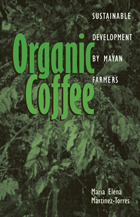 Organic Coffee: Sustainable Development by Mayan Farmers
Maria Elena Martinez-Torres
Ohio University Press, 2006 Despite deepening poverty and environmental degradation throughout rural Latin America, Mayan peasant farmers in Chiapas, Mexico, are finding environmental and economic success by growing organic coffee. Organic Coffee: Sustainable Development by Mayan Farmers provides a unique and vivid insight into how this coffee is grown, harvested, processed, and marketed to consumers in Mexico and in the north.
Maria Elena Martinez-Torres explains how Mayan farmers have built upon their ethnic networks to make a crucial change in their approach to agriculture. Taking us inside Chiapas, Mexico's poorest state and scene of the 1994 Zapatista uprising, she examines the anatomy of the ongoing organic coffee boom and the fair-trade movement. The organic coffee boom arose as very poor farmers formed cooperatives, revalued their ethnic identity, and improved their land through organic farming. The result has been significant economic benefits for their families and ecological benefits for the future sustainability of agriculture in the region.
Organic Coffee refutes the myth that organic farming is less productive than chemical-based agriculture and gives us reasons to be hopeful for indigenous peoples and peasant farmers
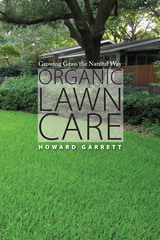 Organic Lawn Care: Growing Grass the Natural Way
By Howard Garrett
University of Texas Press, 2014 Organic gardening expert Howard Garrett offers step-by-step instructions for planting and maintaining lawns, golf courses, and other turf with organic methods that he has proven to be easier, less expensive, and less water-intensive than conventional lawn care.
A lush green lawn is one of the great pleasures of the natural world, whether it’s right outside your front door or on a majestic fairway at a legendary golf course. But anyone who has tried to grow the perfect lawn the conventional way knows it requires an endless cycle of watering and applying synthetic fertilizers and toxic chemical pesticides that costs a lot of money and kills all the life in the soil, on the surface, and on the grass. Fortunately, there’s a better way. Organic lawn care is not only healthier for the environment, it’s actually cheaper and less water-intensive, whether you’re managing a small yard or acres of turf.
In Organic Lawn Care: Growing Grass the Natural Way, Howard Garrett, the renowned “Dirt Doctor,” takes you step-by-step through creating and maintaining turf organically. He begins with the soil, showing you how to establish a healthy habitat for grass. Then he discusses a variety of turfgrasses, including Bermudagrass, bluegrass, buffalograss, fescue, ryegrass, St. Augustine, and zoysia. Garrett explains in detail how to establish and maintain a lawn, including planting, mowing, watering, fertilizing, composting, and managing weeds and pests. And he offers alternatives to lawn grasses and turf, describing the situations in which they might be your best choice.
Follow the program in Organic Lawn Care, and don’t be surprised when your water bill drops dramatically and your lawn or golf course is the best-looking one around.
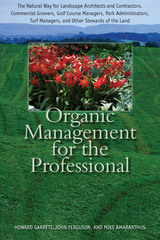 Organic Management for the Professional: The Natural Way for Landscape Architects and Contractors, Commercial Growers, Golf Course Managers, Park Administrators, Turf Managers, and Other Stewards of the Land
By Howard Garrett, John Ferguson, and Mike Amaranthus
University of Texas Press, 2012 Can you manage the landscape of a golf course, city park, or corporate campus without synthetic fertilizers and toxic pesticides? Absolutely! Organic landscaping is not only possible on a large scale, but it also makes sense both economically and environmentally. It promotes healthy soils and plants, which require less water and sequester more carbon—a winning combination for both your bottom line and the planet’s fight against resource depletion and global warming. Organic programs on a commercial scale have enormous potential to make a difference in the quality of our environment, our use of fuels, and our climate. And as those who have already converted to organics have discovered, they also cost a lot less over the long term. Organic Management for the Professional is the first comprehensive guide to “going green” in large-scale landscaping. Nationally recognized organic gardening expert Howard Garrett, with associates John Ferguson and Mike Amaranthus, not only explains in detail how to manage projects with natural organic techniques, but also presents the material in clear, simple terms so that commercial and institutional property owners can understand what to ask of their landscape architects, contractors, growers, and maintenance people. They give detailed, proven instructions for the key components of organic landscaping—soil building, correct planting techniques, fertilizing, pest control, compost, and mulch. Then they show how to apply these organic methods in large-scale landscaping, commercial growing (orchards, tree farms, nurseries, and greenhouse operations), and recreational properties (golf courses, parks, and sports fields).
Organic Sensors: Materials and applications
Eduardo Garcia-Breijo
The Institution of Engineering and Technology, 2017 This book reviews the state of the art in the use of organic materals as physical, chemical and biomedical sensors in a variety of application settings.
 Organic Worldview of Nikolai Leskov
Irmhild Christina Sperrle
Northwestern University Press, 2002 Although little studied in the West, Nikolai Semenovich Leskov (1831-95) is accorded a place among major nineteenth-century writers in his native Russia. Irmhild Christina Sperrle's The Organic Worldview of Nikolai Leskov draws on previously unavailable archival and primary sources to offer English-speaking readers the opportunity to appreciate the work of this neglected author. Leskov remarked to his contemporary Anatolii Faresov, "People talk about my 'language,' about its colorfulness and its national traits; about the richness of my plots, about my condensed way of writing, about 'similarity' and so on, but they do not notice the most important thing." It is this "most important thing," Leskov's consistent thematic adherence to an "organic" philosophical model, that Sperrle traces and elaborates here. Focusing on movement and transformation in "an organic manner"—a manner in which death and rebirth alternate and condition each other—Sperrle develops Leskov's notion of organicity and explores his relationship to the organic tradition in philosophy and literature. Her reading of key texts among his more than five hundred works entails a close look at Leskov's ideas about the Divine as freedom of belief, about truth as a continual renewal of previously held theories, and about death in both a physical and a spiritual sense. She examines Leskov's vexed relation to Tolstoyan ideas and shows how the notion of heresy—as a questioning rather than rejection of authority-is a crucial element in his worldview and his work.
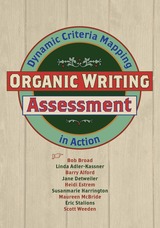 Organic Writing Assessment: Dynamic Criteria Mapping in Action
Bob Broad, Linda Adler-Kassner, Barry Alford, Jane Detweiler, Heidi Estrem, Susanmarie Harrington, Maureen McBride, Eric Stalions, and Scott Weeden
Utah State University Press, 2009 Educators strive to create “assessment cultures” in which they integrate evaluation into teaching and learning and match assessment methods with best instructional practice. But how do teachers and administrators discover and negotiate the values that underlie their evaluations? Bob Broad’s 2003 volume, What We Really Value, introduced dynamic criteria mapping (DCM) as a method for eliciting locally-informed, context-sensitive criteria for writing assessments. The impact of DCM on assessment practice is beginning to emerge as more and more writing departments and programs adopt, adapt, or experiment with DCM approaches.
For the authors of Organic Writing Assessment, the DCM experience provided not only an authentic assessment of their own programs, but a nuanced language through which they can converse in the always vexing, potentially divisive realm of assessment theory and practice. Of equal interest are the adaptations these writers invented for Broad’s original process, to make DCM even more responsive to local needs and exigencies.
Organic Writing Assessment represents an important step in the evolution of writing assessment in higher education. This volume documents the second generation of an assessment model that is regarded as scrupulously consistent with current theory; it shows DCM’s flexibility, and presents an informed discussion of its limits and its potentials.
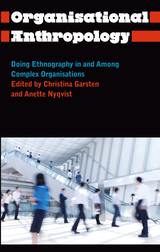 Organisational Anthropology: Doing Ethnography in and Among Complex Organisations
Edited by Christina Garsten and Anette Nyqvist
Pluto Press, 2013 Organisational Anthropology, newly published in paperback, is a pioneering analysis of doing ethnographic fieldwork in different types of complex organisations. The book focuses on the process of initiating contact, establishing rapport and gaining the trust of the organisation's members.
The contributors work from the premise that doing fieldwork in an organisation shares essential characteristics with fieldwork in more ‘classical’ anthropological environments, but that it also poses some particular challenges to the ethnographer. These include the ideological or financial interests of the organisations, protection of resources and competition between organisations.
Organisational Anthropology brings together and highlights crucial aspects of doing anthropology in contemporary complex settings, and will have wide appeal to students, researchers and academics in anthropology and organisation studies.
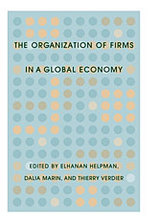 The Organization of Firms in a Global Economy
Elhanan Helpman
Harvard University Press, 2008 The Organization of Firms in a Global Economy presents a new research program that is transforming the study of international trade. Driven by the availability of new micro data sets and innovative theoretical models, it focuses on the level of firms, products, and stages of production rather than on countries and industries. It addresses such questions as why only a small proportion of firms in a given industry export and why an even smaller proportion invest abroad; why exporters tend to be more productive than nonexporters; why almost one-third of international trade takes place between units of the same firm and why as much as two-thirds involves multinational firms as exporter, importer, or both; and why international trade may have been the most important driver of organizational changes in the corporation that have been taking place in the last decade.
Until a few years ago, models of international trade did not recognize the heterogeneity of firms and exporters, and could not provide good explanations of international production networks. Now such models exist and are explored in this volume.
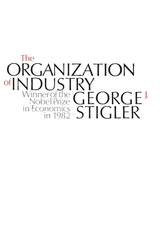 The Organization of Industry
George J. Stigler
University of Chicago Press, 1983 The Organization of Industry collects essays written over two decades—pieces prepared especially for this volume, previously unpublished material, and reprinted articles drawn from numerous sources, many which include additional commentary by the author. The essays are unified by George J. Stigler's careful analysis and by his clear and witty style.
In part one, Stigler examines the nature of competition and monopoly. In part two he discusses the forces that determine the size structure of industry, including barriers to entry, economics of scale, and mergers. Part three contains articles on a wide range of topics, such as profitability, delivered price systems, block booking, the economics of information, and the kinky oligopoly demand curve and rigid price. Part four offers a discussion of antitrust policy and includes Stigler's recommendations for future policy as well as an examination of the effects of past policies.
"Stigler's writings might well be subtitled 'The Joys of Doing Economics.' He, more than any other contemporary American economist, dispels the gloom surrounding economic theory. It is impossible to confront the subject treated with such humor and verve and come away still believing that economics is the dismal science."—Shirley B. Johnson, American Scholar
Organization of Insect Societies: From Genome to Sociocomplexity
Jürgen Gadau
Harvard University Press, 2009 In this landmark volume, an international group of scientists has synthesized their collective expertise and insight into a newly unified vision of insect societies and what they can reveal about how sociality has arisen as an evolutionary strategy.
Jürgen Gadau and Jennifer Fewell have assembled leading researchers from the fields of molecular biology, evolutionary genetics, neurophysiology, behavioral ecology, and evolutionary theory to reexamine the question of sociality in insects. Recent advances in social complexity theory and the sequencing of the honeybee genome ensure that this book will be valued by anyone working on sociality in insects. At the same time, the theoretical ideas presented will be of broad-ranging significance to those interested in social evolution and complex systems.
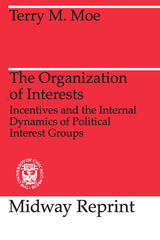 The Organization of Interests: Incentives and the Internal Dynamics of Political Interest Groups
Terry M. Moe
University of Chicago Press, 1980 "Criticisms of Mancur Olson's theory of group membership and organizational behavior and discussions of the limits of his formulations are not new, but Terry Moe has set them forth in thoroughgoing fashion, has elaborated and extended them, and has made positive new contributions. The result is a book that is valuable and constructive, one that may well revive interest in the systematic study of political groups."—David B. Truman, American Political Science Review
"The Organization of Interests is a valuable addition to the literature. It reminds us that the interior life of groups has political significance and gives us a conceptual framework for exploring that life. It balances nicely between the pluralists—who tend to interpret interest group behaviour entirely in political terms—and Olson—who has no satisfactory explanation for behaviour that is not attributable to economic self-interest. In the concept of the entrepreneur Moe gives us a useful analytical device which deserves operationalization. The book is well worth study."—A. Paul Pross, Canadian Journal of Political Science
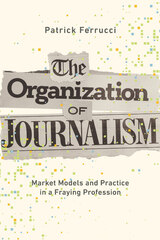 The Organization of Journalism: Market Models and Practice in a Fraying Profession
Patrick Ferrucci
University of Illinois Press, 2024 New business models have splintered journalists’ once-monolithic professional culture. Where the organization once had little sway in the newsroom, in today’s journalism ecosystem, owners and management influence newsgathering more than ever. Using rich interviews and participant observation, Patrick Ferrucci examines institutions with funding mechanisms that range from traditional mogul ownership and online-only nonprofits to staff-owned cooperatives and hedge fund control. The variations in market models have frayed the tenets of professionalization, with unique work cultures emerging from each organization’s focus on its mission and the implantation of its own processes and ethical guidelines. As a result, the field of American journalism no longer shares uniform newsgathering practices and a common identity, a break with the past that affects what information we consume today and what the press will become tomorrow. An inside look at a fracturing profession, The Organization of Journalism illuminates the institution’s expanding impact on newsgathering and the people who practice it.
Organizational Ecology
Michael T. Hannan and John Freeman
Harvard University Press, 1989 Michael T. Hannan and John Freeman examine the ecology of organizations by exploring the competition for resources and by trying to account for rates of entry and exit and for the diversity of organizational forms. They show that the destinies of organizations are determined more by impersonal forces than by the intervention of individuals.
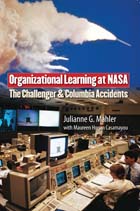 Organizational Learning at NASA: The Challenger and Columbia Accidents
Julianne G. Mahler . with Maureen Hogan Casamayou
Georgetown University Press, 2009 Just after 9:00 a.m. on February 1, 2003, the space shuttle Columbia broke apart and was lost over Texas. This tragic event led, as the Challenger accident had 17 years earlier, to an intensive government investigation of the technological and organizational causes of the accident. The investigation found chilling similarities between the two accidents, leading the Columbia Accident Investigation Board to conclude that NASA failed to learn from its earlier tragedy. Despite the frequency with which organizations are encouraged to adopt learning practices, organizational learning—especially in public organizations—is not well understood and deserves to be studied in more detail. This book fills that gap with a thorough examination of NASA’s loss of the two shuttles. After offering an account of the processes that constitute organizational learning, Julianne G. Mahler focuses on what NASA did to address problems revealed by Challenger and its uneven efforts to institutionalize its own findings. She also suggests factors overlooked by both accident commissions and proposes broadly applicable hypotheses about learning in public organizations.
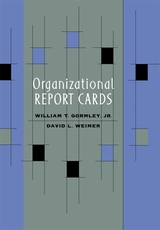 Organizational Report Cards
William T. Gormley, Jr. and David L. Weimer
Harvard University Press, 1999 In recent years, consumers, professional organizations, government officials, and third-party payers have become increasingly concerned about how to assess the quality of the services provided by organizations in both the private and the public sectors. One new approach is the organizational report card, which compares the performance of organizations such as public schools, colleges, hospitals, and HMOs.
This book offers the first comprehensive study of such instruments. It discusses the circumstances under which they are desirable alternatives to other policy instruments, such as regulation; how they should be designed; who is likely to use them and for what purpose; and what role, if any, government should have in their creation. Informed by cases drawn from education, health, and other policy areas, this book develops a conceptual framework for analyzing these issues. It explores the tradeoffs in measuring performance, the methods of communicating results effectively to mass and elite audiences, and the ways in which organizations respond to the data gathered.
Organizational State: Social Choice: In National Policy Domains
Edward O. Laumann
University of Wisconsin Press, 1987 The Federal Government in the United States is a government “of the people, by the people, and for the people.” Presidents are elected by popular vote in the nation (filtered through the electoral college), Senators are elected by popular vote in their states, and Representatives are elected by popular vote in their Congressional districts. Cabinet members and agency heads are appointed by the elected president, as are members of the Supreme Court. But this says nothing about politics. Professor Lauman and Knoke have asked, in this book, how policies were made, in the period 1977-1980, in the areas of energy and health. The question is a very different one from the question of how the positions of president and Congress are filled.
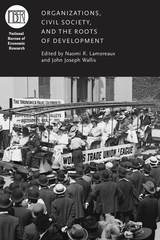 Organizations, Civil Society, and the Roots of Development
Edited by Naomi R. Lamoreaux and John Joseph Wallis
University of Chicago Press, 2017 Modern developed nations are rich and politically stable in part because their citizens are free to form organizations and have access to the relevant legal resources. Yet in spite of the advantages of open access to civil organizations, it is estimated that eighty percent of people live in countries that do not allow unfettered access. Why have some countries disallow the formation of organizations as part of their economic and political system?
The contributions to Organizations, Civil Society, and the Roots of Development seek to answer this question through an exploration of how developing nations throughout the eighteenth and nineteenth centuries, including the United States, United Kingdom, France, and Germany, made the transition to allowing their citizens the right to form organizations. The transition, contributors show, was not an easy one. Neither political changes brought about by revolution nor subsequent economic growth led directly to open access. In fact, initial patterns of change were in the opposite direction, as political coalitions restricted access to specific organizations for the purpose of maintaining political control. Ultimately, however, it became clear that these restrictions threatened the foundation of social and political order. Tracing the path of these modern civil societies, Organizations, Civil Society, and the Roots of Development is an invaluable contribution to all interested in today’s developing countries and the challenges they face in developing this organizational capacity.
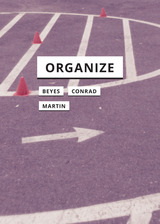 Organize
Timon Beyes
University of Minnesota Press, 2019 A pioneering systematic inquiry into—and mapping of—the field of media and organization
Media organize things into patterns and relations. As intermediaries among people and between people and worlds, media shape sociotechnical orders. At the same time, media are organized: while they condition different organizational forms and processes, they, too, are formed and can be re-formed. This intimate relation of media and organizing is timeless. Yet arguably, digital media technologies repose the question of organization—and thus of power and domination, control and surveillance, disruption and emancipation. Bringing together leading media thinkers and organization theorists, this book interrogates organization as an effect and condition of media. How can we understand the recursive relation between media and organization? How can we think, explore, critique, and perhaps alter the organizational bodies and scripts that shape contemporary life? Organize will be of interest to scholars and students of new and old media, social organization, and technology. Moreover, the dialogical form of these essays provides a concise and path-breaking view on the recursive relation between technological media and social organization. The book therefore establishes and maps “media and organization” as a highly relevant field of inquiry, appealing to those with a critical interest in the technological conditioning of the social.
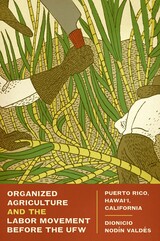 Organized Agriculture and the Labor Movement before the UFW: Puerto Rico, Hawai’i, California
By Dionicio Nodín Valdés
University of Texas Press, 2011 Puerto Rico, Hawai'i, and California share the experiences of conquest and annexation to the United States in the nineteenth century and mass organizational struggles by rural workers in the twentieth. Organized Agriculture and the Labor Movement before the UFW offers a comparative examination of those struggles, which were the era's longest and most protracted campaigns by agricultural workers, supported by organized labor, to establish a collective presence and realize the fruits of democracy. Dionicio Nodín Valdés examines critical links between the earlier conquests and the later organizing campaigns while he corrects a number of popular misconceptions about agriculture, farmworkers, and organized labor. He shows that agricultural workers have engaged in continuous efforts to gain a place in the institutional life of the nation, that unions succeeded before the United Farm Workers and César Chávez, and that the labor movement played a major role in those efforts. He also offers a window into understanding crucial limitations of institutional democracy in the United States, and demonstrates that the widespread lack of participation in the nation's institutions by agricultural workers has not been due to a lack of volition, but rather to employers' continuous efforts to prevent worker empowerment. Organized Agriculture and the Labor Movement before the UFW demonstrates how employers benefitted not only from power and wealth, but also from imperialism in both its domestic and international manifestations. It also demonstrates how workers at times successfully overcame growers' advantages, although they were ultimately unable to sustain movements and gain a permanent institutional presence in Puerto Rico and California.
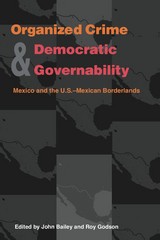 Organized Crime and Democratic Governability: Mexico and the U.S.-Mexican Borderlands
John Bailey
University of Pittsburgh Press, 2001
The United States–Mexico border zone is one of the busiest and most dangerous in the world. NAFTA and rapid industrialization on the Mexican side have brought trade, travel, migration, and consequently, organized crime and corruption to the region on an unprecedented scale. Until recently, crime at the border was viewed as a local law enforcement problem with drug trafficking—a matter of “beefing” up police and “hardening” the border. At the turn of the century, that limited perception has changed.
The range of criminal activity at the border now extends beyond drugs to include smuggling of arms, people, vehicles, financial instruments, environmentally dangerous substances, endangered species, and archeological objects. Such widespread trafficking involves complex, high-level criminal-political alliances that local lawenforcement alone can’t address. Researchers of the region, as well as officials from both capitals, now see the border as a set of systemic problems that threaten the economic, political, and social health of their countries as a whole.
Organized Crime and Democratic Governability brings together scholars and specialists, including current and former government officials, from both sides of the border to trace the history and define the reality of this situation. Their diverse perspectives place the issue of organized crime in historical, political, economic, and cultural contexts unattainable by single-author studies. Contributors examine broad issues related to the political systems of both countries, as well as the specific actors—crime gangs, government officials, prosecutors, police, and the military—involved in the ongoing drama of the border. Editors Bailey and Godson provide an interpretive frame, a “continuum of governability,” that will guide researchers and policymakers toward defining goals and solutions to the complex problem that, along with a border, the United States and Mexico now share.
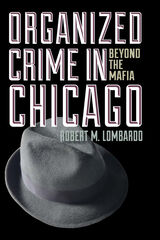 Organized Crime in Chicago: Beyond the Mafia
Robert M. Lombardo
University of Illinois Press, 2013 This book provides a comprehensive sociological explanation for the emergence and continuation of organized crime in Chicago. Tracing the roots of political corruption that afforded protection to gambling, prostitution, and other vice activity in Chicago and other large American cities, Robert M. Lombardo challenges the dominant belief that organized crime in America descended directly from the Sicilian Mafia. According to this widespread "alien conspiracy" theory, organized crime evolved in a linear fashion beginning with the Mafia in Sicily, emerging in the form of the Black Hand in America's immigrant colonies, and culminating in the development of the Cosa Nostra in America's urban centers. Looking beyond this Mafia paradigm, this volume argues that the development of organized crime in Chicago and other large American cities was rooted in the social structure of American society. Specifically, Lombardo ties organized crime to the emergence of machine politics in America's urban centers. From nineteenth-century vice syndicates to the modern-day Outfit, Chicago's criminal underworld could not have existed without the blessing of those who controlled municipal, county, and state government. These practices were not imported from Sicily, Lombardo contends, but were bred in the socially disorganized slums of America where elected officials routinely franchised vice and crime in exchange for money and votes. This book also traces the history of the African-American community's participation in traditional organized crime in Chicago and offers new perspectives on the organizational structure of the Chicago Outfit, the traditional organized crime group in Chicago.
Organized Labor In Postcommunist States: From Solidarity To Infirmity
Paul J. Kubicek
University of Pittsburgh Press, 2004 Paul Kubicek offers a comparative study of organized labor's fate in four postcommunist countries, and examines the political and economic consequences of labor's weakness. He notes that with few exceptions, trade unions have lost members and suffered from low public confidence. Unions have failed to act while changing economic policies have resulted in declining living standards and unemployment for their membership.
While some of labor's problems can be traced to legacies of the communist period, Kubicek draws upon the experience of unions in the West to argue that privatization and nascent globalization are creating new economic structures and a political playing field hostile to organized labor. He concludes that labor is likely to remain a marginalized economic and political force for the foreseeable.
 Organized Labour and Politics in Mexico: Changes, Continuities and Contradictions
Graciela Bensusan and Kevin J. Middlebrook
University of London Press, 2012 As a consequence of market-oriented reforms and historic shifts in governmentpolicy toward labor, the Mexican organized labor movement has declined substantially in size, bargaining strength, and political influence since the 1980s. Democratization has expanded workers' choices at the ballot box, and some unions have bolstered their position by forging alliances with counterparts in Canada and the United States. By analyzing the changes, continuities, and contradictions characterizing labor politics in Mexico, this book contributes to a broader assessment of organized labor's role in contemporary Latin America. Democratization has had remarkably little impact on the state-labor relations regimeinstitutionalized following the Mexican Revolution of 1910-1920. This legal regimeboth underpins the position of unrepresentative union leaders and grants governmentofficials extensive controls over labor organizations. The combination of weakenedunions, unaccountable leaders, and strong government controls fundamentally constrainsworkers' capacity to defend their interests.
This state of affairs - especially the failure to enact progressive labor law reform since democratic regime change in 2000 - limits democracy and imposes heavy costs on society as a whole.
Organizing Access To Capital: Advocacy And The Democratization
edited by Gregory D. Squires
Temple University Press, 2003 Community activists were delighted with the passage of the Community Reinvestment Act, but they came to realize that it would take more than the word of law to bring about real change. This book gives voice to the activists who took it upon themselves to agitate for increased investment by financial institutions in their local communities. They tell of their struggles to get banks, mortgage companies and others to rethink their lending policies. Their stories, drawn from experiences in Chicago, New York, Milwaukee, Boston, Pittsburgh, and other cities around the country, offer insight into the way our political/economic system really works.
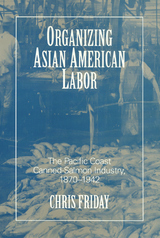 Organizing Asian-American Labor: The Pacific Coast Canned-Salmon Industry, 1870-1942
Chris Friday
Temple University Press, 1995 Between 1870 and 1942, successive generations of Asians and Asian Americans—predominantly Chinese, Japanese, and Filipino—formed the predominant body of workers in the Pacific Coast canned-salmon industry. This study traces the shifts in the ethnic and gender composition of the cannery labor market from its origins through it decline and examines the workers' creation of work cultures and social communities. Resisting the label of cheap laborer, these Asian American workers established formal and informal codes of workplace behavior, negotiated with contractors and recruiters, and formed alliances to organize the workforce. Whether he is discussing Japanese women workers' sharing of child-care responsibilities or the role of Filipino workers in establishing the Cannery and Field Workers Union, Chris Friday portrays Asian and Asian American workers as people who, while enduring oppressive restrictions, continually attempted to shape their own lives.
In the series Asian American History and Culture, edited by Sucheng Chan, David Palumbo-Liu, Michael Omi, K. Scott Wong, and Linda Trinh Võ.
 Organizing Control: August Thyssen and the Construction of German Corporate Management
Jeffrey Fear
Harvard University Press, 2005 In a pioneering work, Jeffrey Fear overturns the dominant understanding of German management as “backward” relative to the U.S. and uncovers an autonomous and sophisticated German managerial tradition. Beginning with founder August Thyssen—the Andrew Carnegie of Germany—Fear traces the evolution of management inside the Thyssen-Konzern and the Vereinigte Stahlwerke (United Steel Works) between 1871 and 1934.
Fear focuses on the organization and internal dynamics of the company. He demonstrates that initiatives often flowed from middle managers, rather than from the top down. Shattering stereotypes of the overly bureaucratic and rigid German firm, Fear portrays a decentralized and flexible system that underscores the dynamic and entrepreneurial nature of German business. He fundamentally revises the scholarship on Alexander Gerschenkron and Germany’s Sonderweg, and critiques Max Weber’s concept of the corporation and capital accounting. He develops a loosely coupled relationship among enterprise strategy, organization, the structure of responsibility, and its accounting system, which links information, knowledge, and power inside the firm. This method of organizing control is central to understanding corporate governance.
Original and provocative, this work will generate much debate among historians, organizational theorists, and management and accounting scholars.
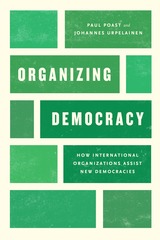 Organizing Democracy: How International Organizations Assist New Democracies
Paul Poast and Johannes Urpelainen
University of Chicago Press, 2018 In the past twenty-five years, a number of countries have made the transition to democracy. The support of international organizations is essential to success on this difficult path. Yet, despite extensive research into the relationship between democratic transitions and membership in international organizations, the mechanisms underlying the relationship remain unclear.
With Organizing Democracy, Paul Poast and Johannes Urpelainen argue that leaders of transitional democracies often have to draw on the support of international organizations to provide the public goods and expertise needed to consolidate democratic rule. Looking at the Baltic states’ accession to NATO, Poast and Urpelainen provide a compelling and statistically rigorous account of the sorts of support transitional democracies draw from international institutions. They also show that, in many cases, the leaders of new democracies must actually create new international organizations to better serve their needs, since they may not qualify for help from existing ones.
Organizing Dixie: Alabama's Workers in the Industrial Era
Philip Taft
University of Alabama Press, 2007 "As befits a state in which coal, iron, and steel were the bulwarks of its industrial sector, Taft stresses that history of unionism among coal miners and iron and steel workers. Here we learn much about the experiences of the United Mine Workers of America and the Steel Workers Organizing Committee—United Steelworkers of America in the Deep South. Yet Taft does not neglect the history of other Alabama workers. Building tradesmen, railroad employees, textile millhands, and Gadsden’s rubber workers all appear in the pages of this book. Here we have the most complete and modern history of a state labor movement in the South written from the perspective of its institutional leaders." —American Historical Review
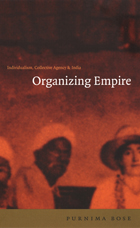 Organizing Empire: Individualism, Collective Agency, and India
Purnima Bose
Duke University Press, 2003 Organizing Empire critically examines how concepts of individualism functioned to support and resist British imperialism in India. Through readings of British colonial and Indian nationalist narratives that emerged in parliamentary debates, popular colonial histories, newsletters, memoirs, biographies, and novels, Purnima Bose investigates the ramifications of reducing collective activism to individual intentions. Paying particular attention to the construction of gender, she shows that ideas of individualism rhetorically and theoretically bind colonials, feminists, nationalists, and neocolonials to one another. She demonstrates how reliance on ideas of the individual—as scapegoat or hero—enabled colonial and neocolonial powers to deny the violence that they perpetrated. At the same time, she shows how analyses of the role of the individual provide a window into the dynamics and limitations of state formations and feminist and nationalist resistance movements. From a historically grounded, feminist perspective, Bose offers four case studies, each of which illuminates a distinct individualizing rhetorical strategy. She looks at the parliamentary debates on the Amritsar Massacre of 1919, in which several hundred unarmed Indian protesters were killed; Margaret Cousins’s firsthand account of feminist organizing in Ireland and India; Kalpana Dutt’s memoir of the Bengali terrorist movement of the 1930s, which was modeled in part on Irish anticolonial activity; and the popular histories generated by ex-colonial officials and their wives. Bringing to the fore the constraints that colonial domination placed upon agency and activism, Organizing Empire highlights the complexity of the multiple narratives that constitute British colonial history.
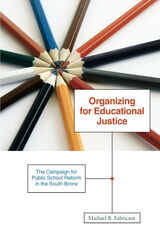 Organizing for Educational Justice: The Campaign for Public School Reform in the South Bronx
Michael B. Fabricant
University of Minnesota Press, 2010 Since the 1980s, strategies for improving public education in America have focused on either competition through voucher programs and charter schools or standardization as enacted into federal law through No Child Left Behind. These reforms, however, have failed to narrow the performance gap between poor urban students and other children. In response, parents have begun to organize local campaigns to strengthen the public schools in their communities. One of the most original, successful, and influential of these parent-led campaigns has been the Community Collaborative to Improve District 9 (CC9), a consortium of six neighborhood-based groups in the Bronx. In Organizing for Educational Justice, Michael B. Fabricant tells the story of CC9 from its origins in 1995 as a small group of concerned parents to the citywide application of its reform agenda—concentrating on targeted investment in the development of teacher capacity—ten years later. Drawing on in-depth interviews with participants, analysis of qualitative data, and access to meetings and archives, Fabricant evaluates CC9’s innovative approach to organizing and collaboration with other stakeholders, including the United Federation of Teachers, the NYC Department of Education, neighborhood nonprofits, and city colleges and universities. Situating this case within a wider exploration of parent participation in educational reform, Fabricant explains why CC9 succeeded and other parent-led movements did not. He also examines the ways in which the movement effectively empowered parents by rigorously ensuring a democratic process in making decisions and, more broadly, an inclusive organizational culture. As urban parents across America search for ways to hold public schools accountable for their failures, this book shows how the success of the CC9 experience can be replicated elsewhere around the country.
 Organizing for Equality: The Evolution of Women's and Racial-Ethnic Organizations in America, 1955-1985
Minkoff, Debra C
Rutgers University Press, 1995 Women and racial-ethnic minorities have had long histories of mobilizing for equality in U.S. society, but recent decades have witnessed an unprecedented expansion in the number and visibility of voluntary and activist organizations committed to challenging gender and racial-ethnic discrimination. What conditions have encouraged this growth? Going beyond more familiar accounts of social movement development, Debra Minkoff uses multivariate techniques to demonstrate that there is an ecology of organizational evolution that has shaped the formation and survival of national women's, African-American, Asian American, and Latino social and political organizations. Changes in the environment for action during the 1960s promoted the creation of a niche for women's and minority organizational activity, and this sector continued to expand even as the climate for social action became increasingly conservative during the 1970s and 1980s. Drawing on recent advances in both social movement and organizational theory and research, Minkoff offers an organizational analysis of the evolution of the women's and racial-ethnic social change sector since the mid-1950s. She provides an original synthesis of social movement and organizational theory, and unique analysis of the development of these women's and minority organizations from the civil rights era to the present.
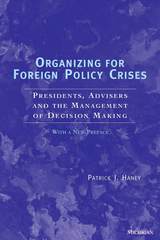 Organizing for Foreign Policy Crises: Presidents, Advisers, and the Management of Decision Making
Patrick J. Haney
University of Michigan Press, 2002 Presidents often assemble ad hoc groups of advisers to help them make decisions during foreign policy crises. These advisers may include the holders of the traditional foreign policy positions--secretaries of state and defense--as well as others from within and without the executive branch. It has never been clear what role these groups play in the development of policy. In this landmark study, Patrick Haney examines how these crisis decision groups were structured and how they performed the tasks of providing information, advice, and analysis to the president. From this, Haney investigates the links between a president's crisis management structure and the decision-making process that took place during a foreign policy crisis.
Haney employs case studies to examine the different ways presidents from Truman through Bush used crisis decision-making groups to help manage foreign policy crises. He looks at the role of these groups in handling the Berlin blockade in 1948, the Suez Crisis in 1956, the Tet offensive in 1968, the Yom Kippur War in 1973, and the Panama invasion in 1989, among other crises. He extends our understanding of the organization, management and behavior of the decision-making groups presidents assemble during foreign policy crises. This book will appeal to scholars of the American presidency and American foreign policy.
Patrick Haney is Assistant Professor of Political Science, Miami University of Ohio.
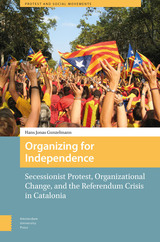 Organizing for Independence: Secessionist Protest, Organizational Change, and the Referendum Crisis in Catalonia
Hans Jonas Gunzelmann
Amsterdam University Press, 2024 Independence protests are on the rise across Europe, as Spain, the UK, and other states have faced severe secessionist challenges. The largest wave of these protests swept Catalonia and reached its peak in 2017 when the push for a binding referendum led to an unprecedented secessionist crisis. Organizing for Independence explores the question of how the referendum crisis as a threat and opportunity transformed secessionist protest and its organizational basis. Combining protest event data, qualitative interviews, and network analyses, Hans Jonas Gunzelmann shows how organizational change took place inside, outside, and between formal organizations, and was driven by activists’ symbolic constructions of transformative events. The book goes beyond simplistic accounts of secessionist protest by providing a dynamic perspective on strategic interactions between protesters and their opponents and allies. These insights are particularly timely as independence movements all over the world look with great interest at what happened in Catalonia.
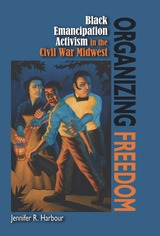 Organizing Freedom: Black Emancipation Activism in the Civil War Midwest
Jennifer R. Harbour
Southern Illinois University Press, 2020 Organizing Freedom is a riveting and significant social history of black emancipation activism in Indiana and Illinois during the Civil War era. By enlarging the definition of emancipation to include black activism, author Jennifer R. Harbour details the aggressive, tenacious defiance through which Midwestern African Americans—particularly black women—made freedom tangible for themselves.
Despite banning slavery, Illinois and Indiana share an antebellum history of severely restricting rights for free black people while protecting the rights of slaveholders. Nevertheless, as Harbour shows, black Americans settled there, and in a liminal space between legal slavery and true freedom, they focused on their main goals: creating institutions like churches, schools, and police watches; establishing citizenship rights; arguing against oppressive laws in public and in print; and, later, supporting their communities throughout the Civil War.
Harbour’s sophisticated gendered analysis features black women as being central to the seeking of emancipated freedom. Her distinct focus on what military service meant for the families of black Civil War soldiers elucidates how black women navigated life at home without a male breadwinner at the same time they began a new, public practice of emancipation activism. During the tumult of war, Midwestern black women negotiated relationships with local, state, and federal entities through the practices of philanthropy, mutual aid, religiosity, and refugee and soldier relief.
This story of free black people shows how the ideal of equality often competed against reality in an imperfect nation. As they worked through the sluggish, incremental process to achieve abolition and emancipation, Midwestern black activists created a unique regional identity.
Organizing Governance, Governing Organizations
Colin Campbell
University of Pittsburgh Press, 1988
In recent years, Western bureaucracies have continued to expand, but are citizens better served? In this volume, sixteen contributors analyze the problems of government organization, both in individual cases and in a broader comparative context.
Contributors: Joel D. Aberbach; Peter Aucoin; Richard A. Chapman; Michael G. Hansen; Peter Hennessy; Brian W. Hogwood; Mohammad Mohabbat Kahn; Ulrich Klöti; Charles H. Levine; Johan P. Olsen; Bert A. Rockman; Richard Rose; Norman C. Thomas; John Warhurst; and the editors.
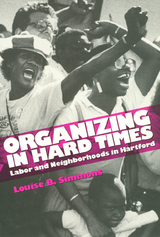 Organizing In Hard Times: Labor and Neighborhoods In Hartford
Louise B. Simmons
Temple University Press, 1994 In 1990, Hartford, Connecticut, ranked as the eight poorest city in the country by the census; the real estate market was severely depressed; downtown insurance companies were laying off and the retail department stores were closing; public services were strained; and demolition sites abandoned for lack of funds pockmarked the streets. Hartford's problems are typical of those experienced in numerous U.S. cities affected by a lingering recession. The harsh economic times felt throughout the city's workplaces and neighborhoods precipitated the formation of grassroots alliances between labor and community organizations. Coming together to create new techniques, their work has national implications for the development of alternative strategies for stimulating economic recovery. Louise B. Simmons, a former Hartford City Councilperson, offers an insider's view of these coalitions, focusing on three activist unions—rhe New England Health Care Employees Union, the Hotel and Restaurant Employees, and the United Auto Workers—and three community groups—Hartford Areas Rally Together, Organized North Easterners-Clay Hill and North End, and Asylum Hill Organizing Project. Her in-depth analysis illustrates these groups' successes and difficulties in working together toward a new vision of urban politics. In the series Labor and Social Change, edited by Paula Rayman and Carmen Sirianni.
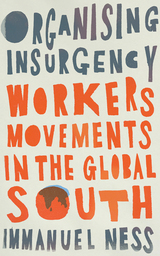 Organizing Insurgency: Workers' Movements in the Global South
Immanuel Ness
Pluto Press, 2021 Workers in the Global South are doomed through economic imperialism to carry the burden of the entire world. While these workers appear isolated from the Global North, they are in fact deeply integrated into global commodity chains and essential to the maintenance of global capitalism. Looking at contemporary case studies in India, the Philippines and South Africa, this book affirms the significance of political and economic representation to the struggles of workers against deepening levels of poverty and inequality that oppress the majority of people on the planet. Immanuel Ness shows that workers are eager to mobilise to improve their conditions, and can achieve lasting gains if they have sustenance and support from political organisations. From the Dickensian industrial zones of Delhi to the agrarian oligarchy on the island of Mindanao, a common element remains – when workers organise they move closer to the realisation of socialism, solidarity and equality.
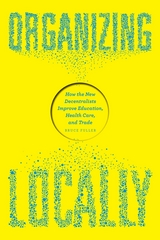 Organizing Locally: How the New Decentralists Improve Education, Health Care, and Trade
Bruce Fuller
University of Chicago Press, 2015 We love the local. From the cherries we buy, to the grocer who sells them, to the school where our child unpacks them for lunch, we express resurgent faith in decentralizing the institutions and businesses that arrange our daily lives. But the fact is that huge, bureaucratic organizations often still shape the character of our jobs, schools, the groceries where we shop, and even the hospitals we entrust with our lives. So how, exactly, can we work small, when everything around us is so big, so global and standardized? In Organizing Locally, Bruce Fuller shows us, taking stock of America’s rekindled commitment to localism across an illuminating range of sectors, unearthing the crucial values and practices of decentralized firms that work.
Fuller first untangles the economic and cultural currents that have eroded the efficacy of—and our trust in—large institutions over the past half century. From there we meet intrepid leaders who have been doing things differently. Traveling from a charter school in San Francisco to a veterans service network in Iowa, from a Pennsylvania health-care firm to the Manhattan branch of a Swedish bank, he explores how creative managers have turned local staff loose to craft inventive practices, untethered from central rules and plain-vanilla routines. By holding their successes and failures up to the same analytical light, he vividly reveals the key cornerstones of social organization on which motivating and effective decentralization depends. Ultimately, he brings order and evidence to the often strident debates about who has the power—and on what scale—to structure how we work and live locally.
Written for managers, policy makers, and reform activists, Organizing Locally details the profound decentering of work and life inside firms, unfolding across postindustrial societies. Its fresh theoretical framework explains resurging faith in decentralized organizations and the ingredients that deliver vibrant meaning and efficacy for residents inside. Ultimately, it is a synthesizing study, a courageous and radical new way of conceiving of American vitality, creativity, and ambition.
Organizing Professionals: Academic Employees Negotiating a New Academy
Gary Rhoades
Rutgers University Press, 2025 Amidst unprecedented levels of union organizing in higher education, Gary Rhoades combines the perspectives of a scholar and labor movement activist and leader to provide a comprehensive analysis of organizing campaigns and collective bargaining agreements for faculty (contingent and tenure-track), graduate students, and postdoc employees. Academic employees are organizing and negotiating for respect for workers, their work, and the public value of higher education. Rhoades analyzes how academic employees are shifting the imbalance of power between labor and management, reducing the internal professional stratification between segments of the academic workforce, and intersecting workplace issues with broader issues of equality, public value, and social justice, and in the process organizing and negotiating for a new, more progressive academy.
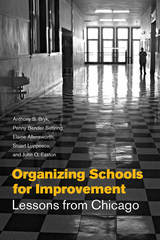 Organizing Schools for Improvement: Lessons from Chicago
Anthony S. Bryk, Penny Bender Sebring, Elaine Allensworth, Stuart Luppescu, and John Q. Easton
University of Chicago Press, 2009 In 1988, the Chicago public school system decentralized, granting parents and communities significant resources and authority to reform their schools in dramatic ways. To track the effects of this bold experiment, the authors of Organizing Schools for Improvement collected a wealth of data on elementary schools in Chicago. Over a seven-year period they identified one hundred elementary schools that had substantially improved—and one hundred that had not. What did the successful schools do to accelerate student learning? The authors of this illuminating book identify a comprehensive set of practices and conditions that were key factors for improvement, including school leadership, the professional capacity of the faculty and staff, and a student-centered learning climate. In addition, they analyze the impact of social dynamics, including crime, critically examining the inextricable link between schools and their communities. Putting their data onto a more human scale, they also chronicle the stories of two neighboring schools with very different trajectories. The lessons gleaned from this groundbreaking study will be invaluable for anyone involved with urban education.
|
|
